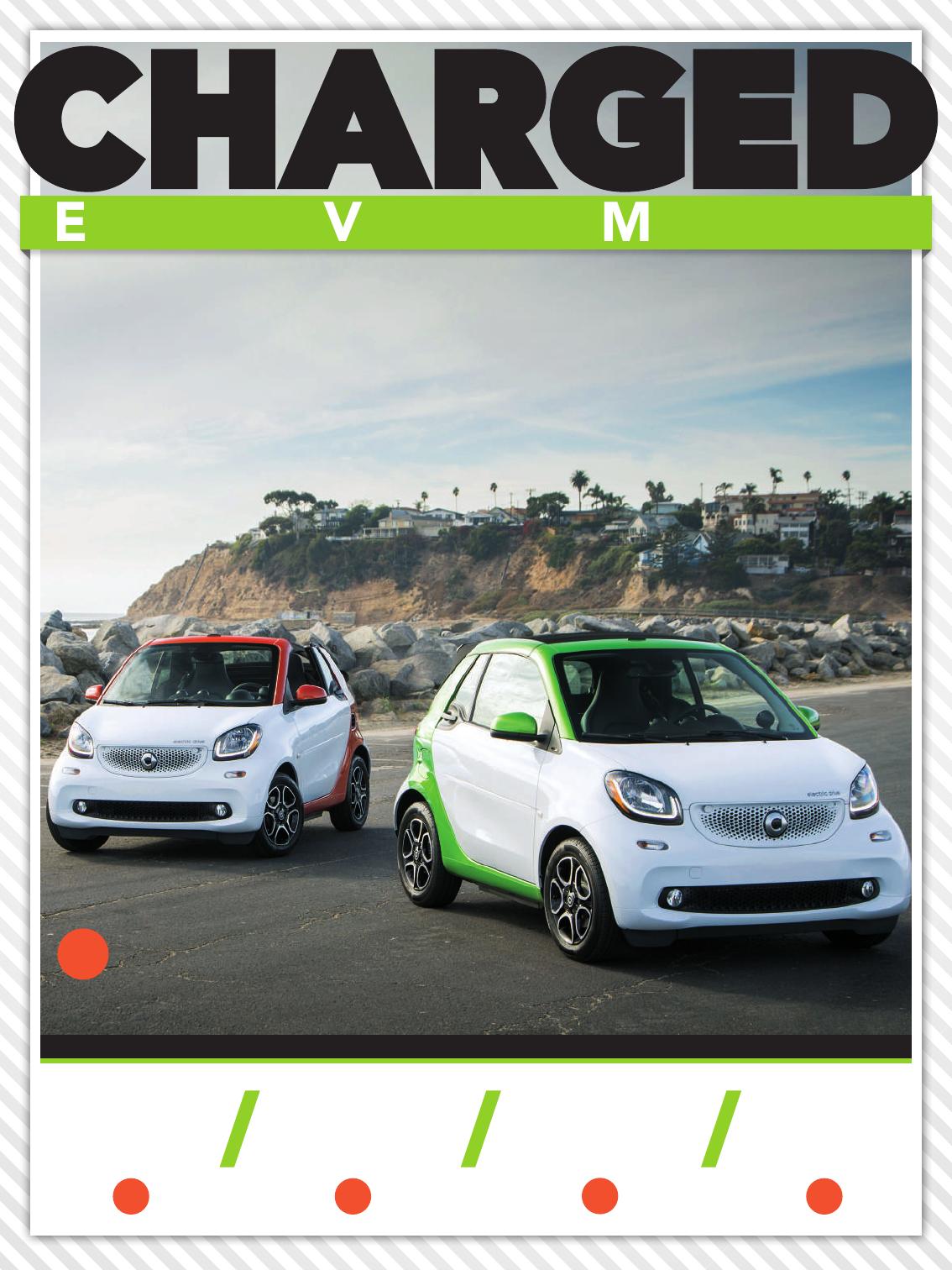
ELECTRIC VEHICLES MAGAZINE
ISSUE 35 | JANUARY/FEBRUARY 2018 | CHARGEDEVS.COM
2018 SMART
ELECTRIC DRIVE
p. 48
p. 32
IONIC MATERIALS
EMERGES AS A SOLID-
STATE BATTERY LEADER
p. 68
EVBOX COMPARES
US AND EUROPEAN
EVSE MARKETS
p. 64
HOW CHARGING
STATIONS EARN ENERGY
STAR CERTIFICATION
p. 28
TESLA’S MOTOR
CHIEF ON MODEL 3’S
PM MACHINE
The smart loses its top - and its gas engine
FORTWO

Battery/EV Automated Test Equipment
chromausa.com | 949-600-6400 | sales@chromausa.com
© 2018 Chroma Systems Solutions, Inc. All rights reserved.
17040 Battery Test System
Next Generation Test for Battery and Battery Connected Devices
The 17040 is a highly ecient, precision battery test system. It’s regenerative, so power
consumption is greatly reduced. The energy discharged from testing is recycled back to the
grid reducing wasted energy and without generating harmonic pollution on other devices
– even in dynamic charge and discharge conditions. It’s also dual mode. Not only is the
17040 equipped with a Charge/Discharge mode but has a Battery Simulation mode to
verify if a connected device like a motor driver is functioning properly under varied
conditions. Software/hardware integration and customization capabilities include BMS,
data loggers, chambers, external signals, and HIL (Hardware in the Loop).
To nd out more about the 17040, Battery Pro Software, and other battery/EV test
solutions, visit chromausa.com.
Voltage Current Power
1000V 0~1500A 0~600kW
Conforms to International Standards
IEC, ISO, UL, and GB/T
High accuracy current/voltage measurement
±0.05%FS/±0.02%FS
New App Note Download:
Battery Electrical Tests
(Reference IEC61960)
60kW 300kW
Battery Pro Software
Waveform Current Test
Editor Shown
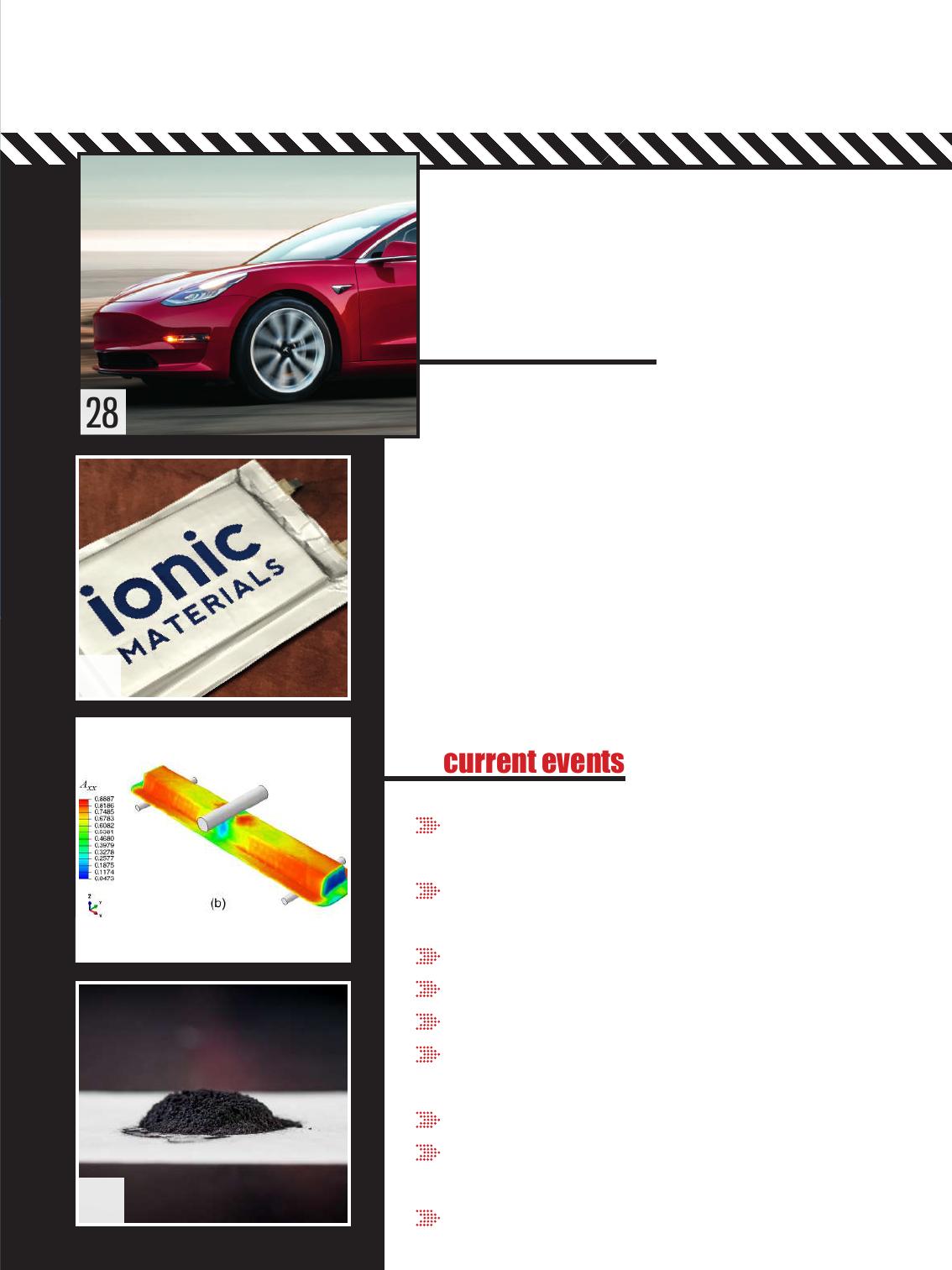
12
28
20
32
22 A closer look at energy
consumption in EVs
32 Ionic Materials
The Massachusetts-based company emerges as a leader in
solid-state batteries by focusing on polymer science
28 Model 3’s PM motor
Tesla’s top motor engineer talks about designing a
permanent magnet machine for Model 3
THE TECH
12 Aqueous anode enables super-fast charging
Predictingthepropertiesoflightweightcarbonbercomposites
14 DOE awards $2.25 million to develop lightweight vehicle materials
Toyota Tsusho to acquire 15% stake in Australian lithium mining company
15 BMW partners with Solid Power to develop solid-state batteries
16 Groupe PSA and Nidec form JV for automotive traction motors
17 New insight into lithium metal plating
18 Waterloo team develops low-cost approach to stabilize lithium metal anodes
Toyota and Panasonic explore joint prismatic battery development
19 SparkEVtelematicssolutionaimstoincreaseproductivityforEVeets
20 Recycling worn cathodes to make new batteries
Nexeon and partners win £7 million in funding to develop silicon anode tech
21 YASA secures £15 million growth funding, opens new Oxford production facility
current events
CONTENTS
Battery/EV Automated Test Equipment
chromausa.com | 949-600-6400 | sales@chromausa.com
© 2018 Chroma Systems Solutions, Inc. All rights reserved.
17040 Battery Test System
Next Generation Test for Battery and Battery Connected Devices
The 17040 is a highly ecient, precision battery test system. It’s regenerative, so power
consumption is greatly reduced. The energy discharged from testing is recycled back to the
grid reducing wasted energy and without generating harmonic pollution on other devices
– even in dynamic charge and discharge conditions. It’s also dual mode. Not only is the
17040 equipped with a Charge/Discharge mode but has a Battery Simulation mode to
verify if a connected device like a motor driver is functioning properly under varied
conditions. Software/hardware integration and customization capabilities include BMS,
data loggers, chambers, external signals, and HIL (Hardware in the Loop).
To nd out more about the 17040, Battery Pro Software, and other battery/EV test
solutions, visit chromausa.com.
Voltage Current Power
1000V 0~1500A 0~600kW
Conforms to International Standards
IEC, ISO, UL, and GB/T
High accuracy current/voltage measurement
±0.05%FS/±0.02%FS
New App Note Download:
Battery Electrical Tests
(Reference IEC61960)
60kW 300kW
Battery Pro Software
Waveform Current Test
Editor Shown
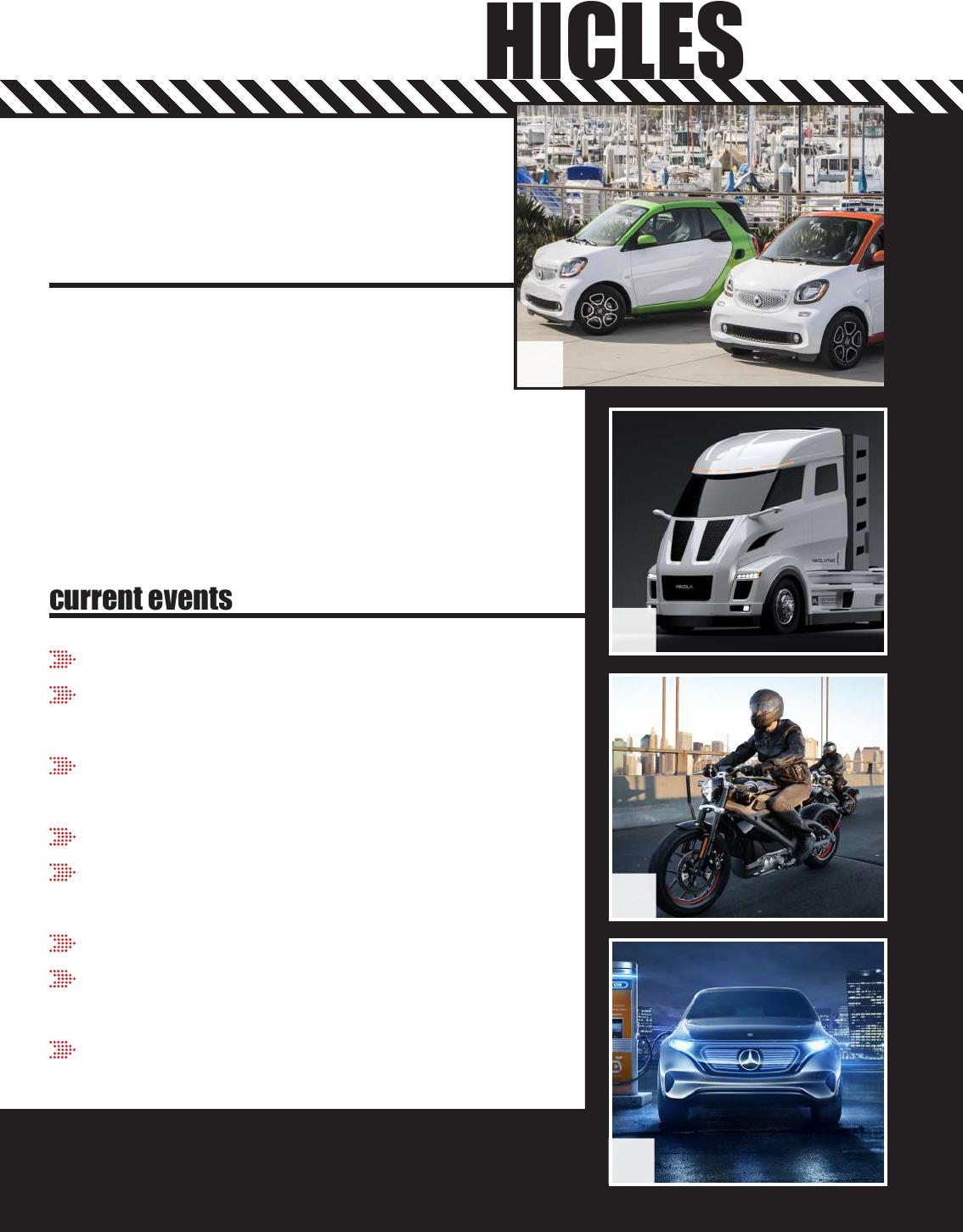
48 smart fortwo
The smart loses its top - and its gas engine
current events
THE VEHICLES
CONTENTS
38 2017 plug-in sales up 26%, Tesla and Chevy on top
40 All New Flyer facilities now capable of manufacturing electric buses
QuébecissuesnalregulationsforZEVmandate
42 Shenzhen goes fully electric with over 16,000 electric buses
Fuel cell truck maker Nikola gets investment from safety specialist WABCO
43 Electric container barges to sail from Europe this summer
44 Harley-Davidsonconrmsitwillbringelectricmotorcycletomarket
Los Angeles DOT orders 25 Proterra e-buses
45 Colorado releases new EV support plan to accelerate adoption
46 User survey shows buyers misunderstand the used EV market
Mercedes to build EVs in six plants on three continents
47 California Energy Commission awards $3 million to EV ride-sharing projects
46
44
48
42
82 Howsignicantare
so-called ICE bans?
IDENTIFICATION STATEMENT
CHARGED Electric Vehicles Magazine (ISSN: 24742341) January/February 2018, Issue #35 is published bi-monthly by Electric
Vehicles Magazine LLC, 2260 5th Ave S, STE 10, Saint Petersburg, FL 33712-1259. Periodicals Postage Paid at Saint Petersburg,
FL and additional mailing oces. POSTMASTER: Send address changes to CHARGED Electric Vehicles Magazine, Electric
Vehicles Magazine LLC at 2260 5th Ave S, STE 10, Saint Petersburg, FL 33712-1259.

—
So much more than hardware
Open, connected, reliable, and
experienced.
EV charging systems should never have a ‘set and forget’ approach to deployment.
Faster charging at higher powers demands greater technical competency and
plenty of real-world experience. With nearly a decade developing EV charging
solutions and several thousand DCFC stations installed around the world, we
understand the complexities of delivering more than power; but rather delivering an
optimal operator, site and driver experience. Our 24/7 service coverage, proven
hardware and intelligent connectivity make ABB the bankable choice for sustainable
mobility solutions. abb.com/evcharging

62
61
64
68
64 ENERGY STAR
HowEVchargingstationsearnENERGYSTARcertication
68 EVBox
The charging markets in Europe and the US: EVBox
explainsthedierence
74 Vehicle-to-grid challenges
Air Force V2G project reveals challenges of the early days
58 GM wants Congress to fund EVSE, Toyota wants hydrogen fueling
Allego and Fortum collaborate on a European charging network
59 AeroVironment’s new TurboDX charging solution
60 SouthKoreatoociallyadoptCCSfastchargingstandard
Mack demonstrates catenary-powered PHEV at port of Los Angeles
61 New York announces $3.5 million in R&D funding for EV-grid integration
175 kW charging station opens in Germany, 350 kW coming soon
62 BP invests in mobile charging company FreeWire
VW subsidiary Electrify America to install 2,800 charging stations
63 PG&E’s EV Charge Network to install 7,500 new charging stations
GeniePoint Network rolls out fast chargers at UK petrol stations
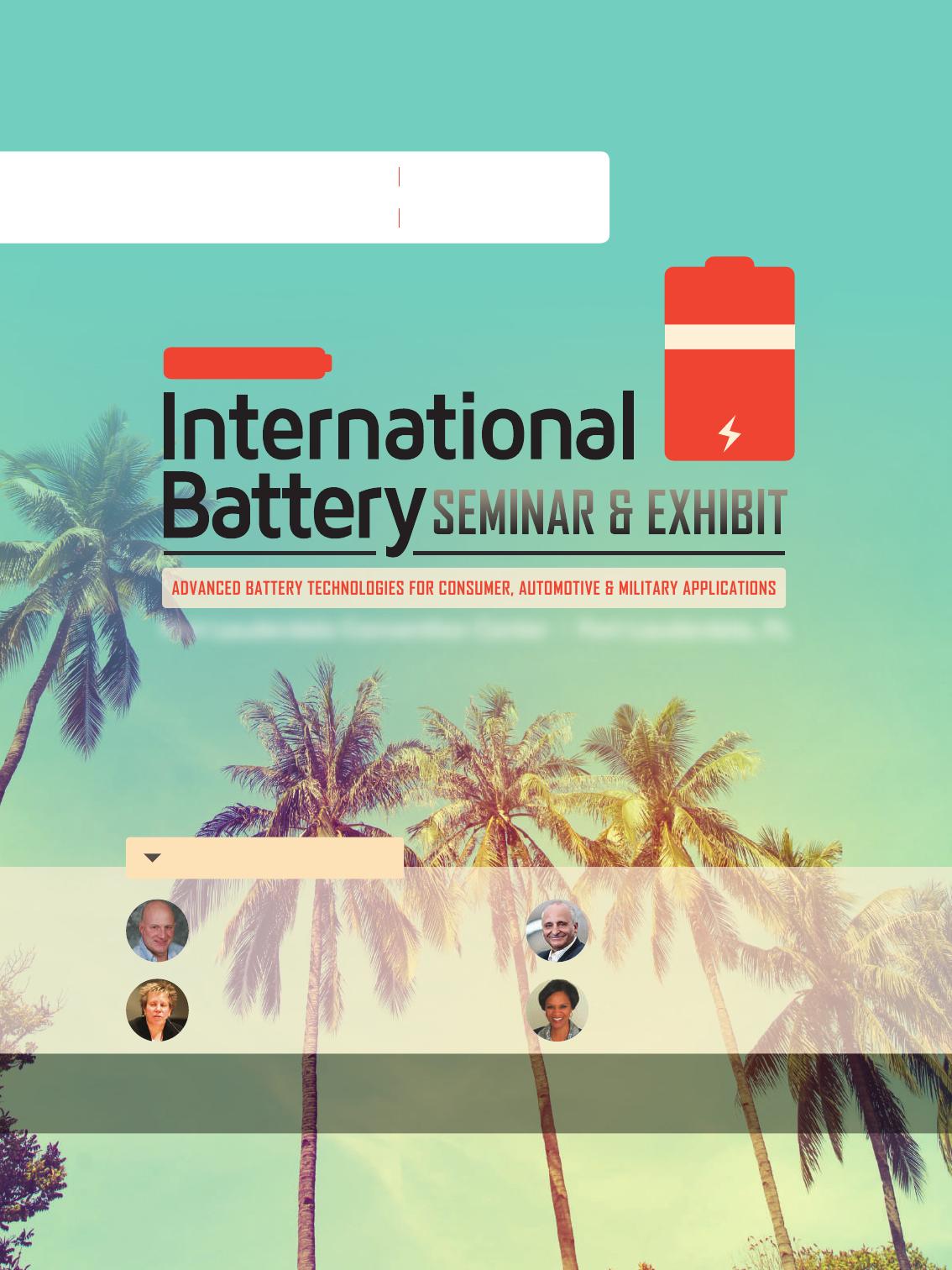
REGISTER EARLY
MAXIMUM
SAVINGS
InternationalBatterySeminar.com
35th ANNUAL
ADVANCED BATTERY TECHNOLOGIES FOR CONSUMER, AUTOMOTIVE & MILITARY APPLICATIONS
BATTERY
EVENT
35th ANNUAL
LONGEST
RUNNING
March 26-29, 2018
Fort Lauderdale Convention Center | Fort Lauderdale, FL
FOR
How Does the Electrolyte Change during
the Lifetime of a Li-Ion Cell?
Jeff Dahn, PhD
NSERC/Tesla Canada, Dalhousie University
Uber Elevate - Powering an Electric UberAIR Future
Celina Mikolajczak
Uber
Addressing Key Battery Issues from a
Thermodynamics Perspective
Rachid Yazami, PhD
Nanyang Technological University, Singapore
Global Electrication and LG Chem
Denise Gray
LG Chem Power
PLENARY KEYNOTES
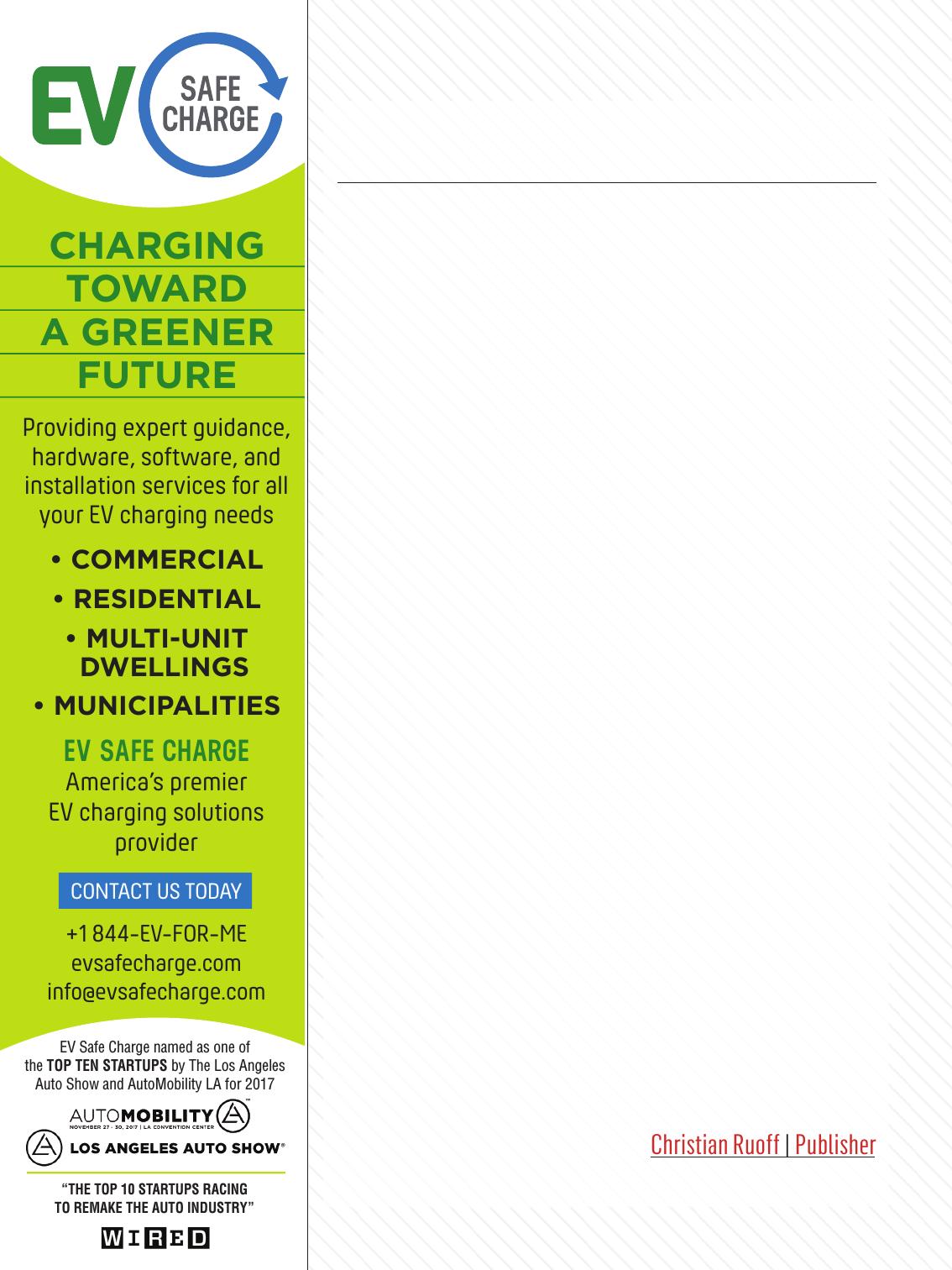
CHARGING
TOWARD
A GREENER
FUTURE
Providing expert guidance,
hardware, software, and
installation services for all
your EV charging needs
• COMMERCIAL
• RESIDENTIAL
• MULTI-UNIT
DWELLINGS
• MUNICIPALITIES
EV SAFE CHARGE
America’s premier
EV charging solutions
provider
CONTACT US TODAY
+1 844-EV-FOR-ME
evsafecharge.com
info@evsafecharge.com
EV Safe Charge named as one of
the TOP TEN STARTUPS by The Los Angeles
Auto Show and AutoMobility LA for 2017
“THE TOP 10 STARTUPS RACING
TO REMAKE THE AUTO INDUSTRY”
In September 2016, Tesla and SapceX CEO Elon Musk unveiled his ambi-
tious vision for colonizing Mars, which included building huge new rockets
and spacecra capable of holding 100 people at a time. During the presenta-
tion, Musk noted that moving a lot of humans to Mars is going to cost a lot
of money. He estimated that the cost of getting the interplanetary transport
system up and running would be around $10 billion total.
Musk also reiterated that his mission to get us to Mars is what motivates
most of his decisions. “I think as we show that this is possible, that this
dream is real, I think the support will snowball over time. e main reason
I’m personally accumulating assets is in order to fund this. I really don’t
have any other motivation except to be able to make the biggest contribu-
tion I can to making life multi-planetary.”
e man thinks very methodically, so it’s safe to assume his recent an-
nouncement to stay at the wheel of Tesla for another decade means that he’s
condent it’s the best bet to grow the fortune he wants to funnel into space
exploration. Previously, Musk had only publicly committed to staying on as
Tesla CEO until the Model 3 was successfully launched and on the road.
His compensation plan for the next decade is “perhaps the most radical
in corporate history,” as the New York Times put it. Musk will be paid only
if Tesla reaches a series of ambitious market value milestones - otherwise,
he will be paid nothing. Tesla has set a dozen market value targets, in
increments of $50 billion, starting at $100 billion, then $150 billion, and so
on up to a market cap of $650 billion. Also, the company has set a dozen
revenue and prot goals. Mr. Musk will receive 1.68 million shares, or about
1 percent of the company, only if he reaches both sets of milestones. Tesla’s
current market cap is about $59 billion.
Musk’s new compensation plan is similar to the previous one put in place
in 2012 (he reached all but one of those metrics), but now the numbers are
much larger. If he succeeds in increasing the value of Tesla to $650 billion - a
gure that would make Tesla one of the ve largest companies in the US -
his stock award could be worth as much as $55 billion.
e policy is about as shareholder-friendly as they come, in contrast to
those at many other corporations, which richly reward CEOs even when the
companies underperform. If the benchmarks are reached, the company’s
employees, including those who work on the factory oor, who get paid in
both cash and stock, could also become wealthy.
“If all that happens over the next 10 years is that Tesla’s value grows by 80
or 90 percent, then my amount of compensation would be zero,” Musk told
the NYT. “I actually see the potential for Tesla to become a trillion-dollar
company within a 10-year period.”
Coming from anyone else, that would seem like a totally crazy and un-
reachable milestone. It’s hard to imagine how Tesla could accomplish such
growth, but, at this point, it’s even harder to imagine betting against Musk.
Christian Ruoff | Publisher
EVs are here. Try to keep up.
Musk doubles down on Tesla to get us to Mars
170+ speakers including:
Discover the future of H/EV and
advanced baery technology at Europe’s
fastest-growing expert-led conference
15 – 17 May 2018 // Hannover, Germany
www.evtechexpo.eu
www.thebaeryshow.eu
Early-bird conference passes
available – book by Thursday 15
March 2018 to save up to €300
View
agenda and
pre-conference
workshops
online
Paul Freeland,
Principal Engineer,
Cosworth
Frank Bekemeier,
Chief Technology
Officer e-Mobility,
Volkswagen AG
Genis Turon, Senior
Engineer – Production
Engineering Advanced
Technology, Toyota
Marcus Hafkemeyer,
VP R&D Electric
Powertrain, BAIC
Dave Barnett,
Business
Development
Director, Wrightbus
Pascale Herman,
Valeo Thermal
Systems Marketing
Director, Valeo
Florian Joslowski,
Lead Engineer for
High-Voltage Systems,
Porsche Engineering
Services
Christophe Dos
Santos, Application
Engineer, LORD
Limhi Somerville,
Advanced Battery
Research, Jaguar
Land Rover

170+ speakers including:
Discover the future of H/EV and
advanced baery technology at Europe’s
fastest-growing expert-led conference
15 – 17 May 2018 // Hannover, Germany
www.evtechexpo.eu
www.thebaeryshow.eu
Early-bird conference passes
available – book by Thursday 15
March 2018 to save up to €300
View
agenda and
pre-conference
workshops
online
Paul Freeland,
Principal Engineer,
Cosworth
Frank Bekemeier,
Chief Technology
Officer e-Mobility,
Volkswagen AG
Genis Turon, Senior
Engineer – Production
Engineering Advanced
Technology, Toyota
Marcus Hafkemeyer,
VP R&D Electric
Powertrain, BAIC
Dave Barnett,
Business
Development
Director, Wrightbus
Pascale Herman,
Valeo Thermal
Systems Marketing
Director, Valeo
Florian Joslowski,
Lead Engineer for
High-Voltage Systems,
Porsche Engineering
Services
Christophe Dos
Santos, Application
Engineer, LORD
Limhi Somerville,
Advanced Battery
Research, Jaguar
Land Rover

Experience clarity like never before! Arbin’s new Laboratory Battery Test equipment allows
you to uncover battery trends that may be overlooked using traditional test equipment.
Industry leading measurement resolution, measurement precision, and timekeeping can
lead to new discoveries, and shorten the time required to bring new technology to
market. Innovative science demands the best instrumentation.
ETHICS STATEMENT AND COVERAGE POLICY
AS THE LEADING EV INDUSTRY PUBLICATION, CHARGED ELECTRIC VEHICLES MAGAZINE OFTEN COVERS, AND ACCEPTS CONTRIBUTIONS FROM, COMPANIES THAT ADVERTISE
IN OUR MEDIA PORTFOLIO. HOWEVER, THE CONTENT WE CHOOSE TO PUBLISH PASSES ONLY TWO TESTS: 1 TO THE BEST OF OUR KNOWLEDGE THE INFORMATION IS ACCU
RATE, AND 2 IT MEETS THE INTERESTS OF OUR READERSHIP. WE DO NOT ACCEPT PAYMENT FOR EDITORIAL CONTENT, AND THE OPINIONS EXPRESSED BY OUR EDITORS AND
WRITERS ARE IN NO WAY AFFECTED BY A COMPANY’S PAST, CURRENT, OR POTENTIAL ADVERTISEMENTS. FURTHERMORE, WE OFTEN ACCEPT ARTICLES AUTHORED BY “INDUS
TRY INSIDERS,” IN WHICH CASE THE AUTHOR’S CURRENT EMPLOYMENT, OR RELATIONSHIP TO THE EV INDUSTRY, IS CLEARLY CITED. IF YOU DISAGREE WITH ANY OPINION EX
PRESSED IN THE CHARGED MEDIA PORTFOLIO AND/OR WISH TO WRITE ABOUT YOUR PARTICULAR VIEW OF THE INDUSTRY, PLEASE CONTACT US AT CONTENTCHARGEDEVS.
COM. REPRINTING IN WHOLE OR PART IS FORBIDDEN EXPECT BY PERMISSION OF CHARGED ELECTRIC VEHICLES MAGAZINE.
Publisher
Associate Publisher
Senior Editor
Associate Editor
Account Executive
Technology Editor
Graphic Designers
Christian Ruoff
Laurel Zimmer
Charles Morris
Markkus Rovito
Jeremy Ewald
Jeffrey Jenkins
Mary Rose Robinson
Tome Vrdoljak
Andy Windy
For Letters to the Editor, Article
Submissions, & Advertising Inquiries
Contact: Info@ChargedEVs.com
Contributing Writers
Contributing Photographers
Cover Image Courtesy of
Special Thanks to
Peter Banwell
Paul Beck
Tom Ewing
Jeffrey Jenkins
Charles Morris
David Baillot
Sarah Corrice
Norsk Elbilforening
Vetatur Fumare
Jakob Härter
Nicolas Raymond
Mercedes-Benz USA
Kelly Ruoff
Sebastien Bourgeois
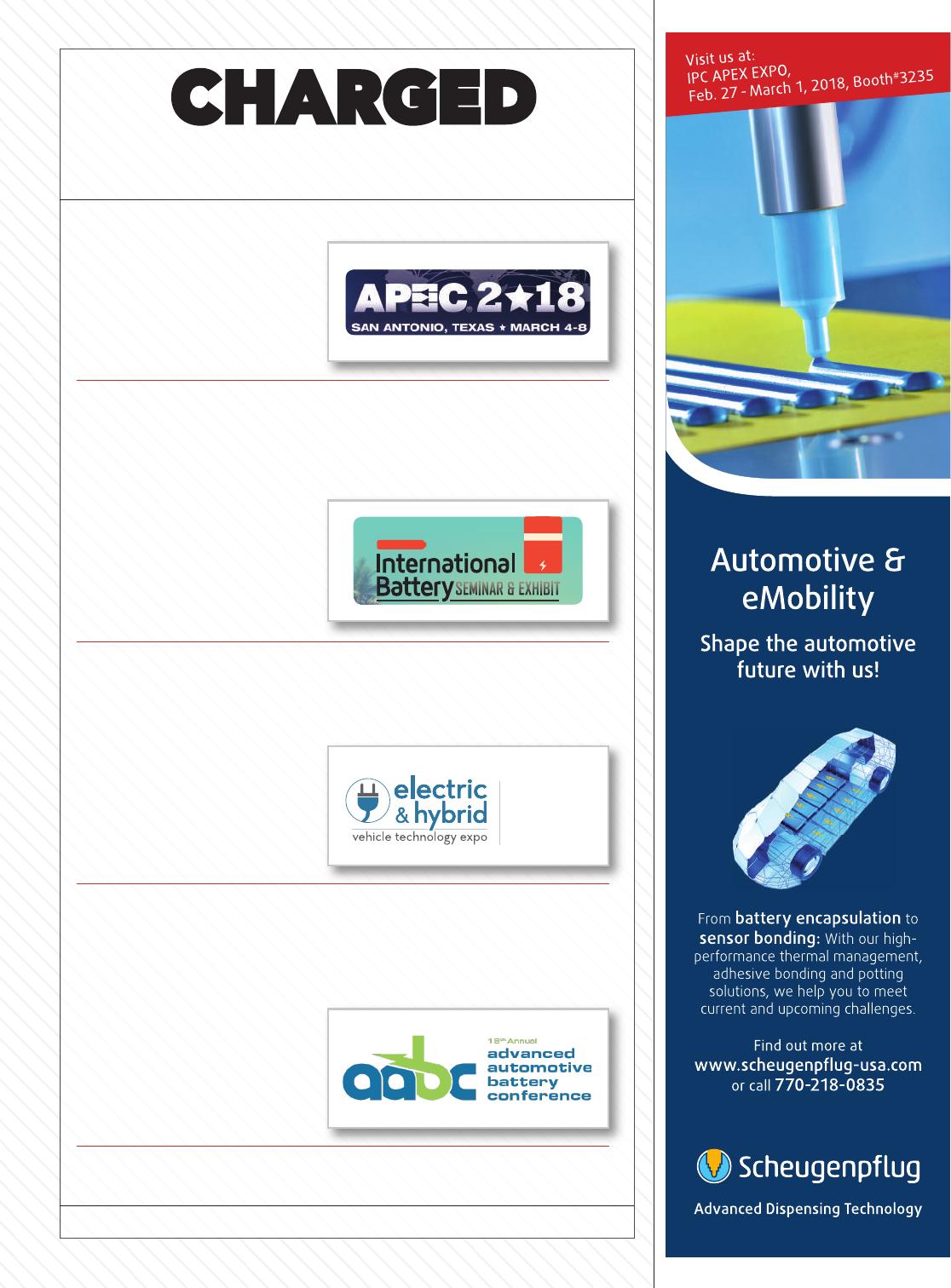
For more information on industry events visit ChargedEVs.com/Events
APEC 2018
March 4-8, 2018
San Antonio, TX
EV Tech Expo Europe
May 15-17, 2018
Hanover, Germany
2018
europe
15 – 17 May 2018 // Hanover, Germany
Europe’s largest trade fair for H/EV
and advanced baery technology
300+ exhibitors // 5,000+ aendees
Confirmed participation from:
“We are overwhelmed
with how many people are
here, very knowledgeable
people. It’s very different
to standard exhibitions.
All the engineers and
people from that
market are here.”
Max Göldi, LF Market Manager
Industry, HUBER+SUHNER
Co-located with
Register
online for
your free
trade fair
pass
www.evtechexpo.eu www.thebaeryshow.eu
info@evtechexpo.eu info@thebaeryshow.eu
Advanced
Automotive Battery
Conference
June 4 - 7, 2018
San Diego, CA
International Battery
Seminar
March 26-29, 2018
Fort Lauderdale, FL
REGISTER EARLY
MAXIMUM
SAVINGS
Internationa lBatterySeminar.com
35th ANNUAL
ADVANCED BATTERY TECHNOLOGIES FOR CONSUMER, AUTOMOTIVE & MILITARY APPLICATIONS
BATTERY
EVENT
35th ANNUAL
LONGEST
RUNNING
March 26-29, 2018
Fort Lauderdale Convention Center | Fort Lauderdale, FL
FOR
Sponsored Events
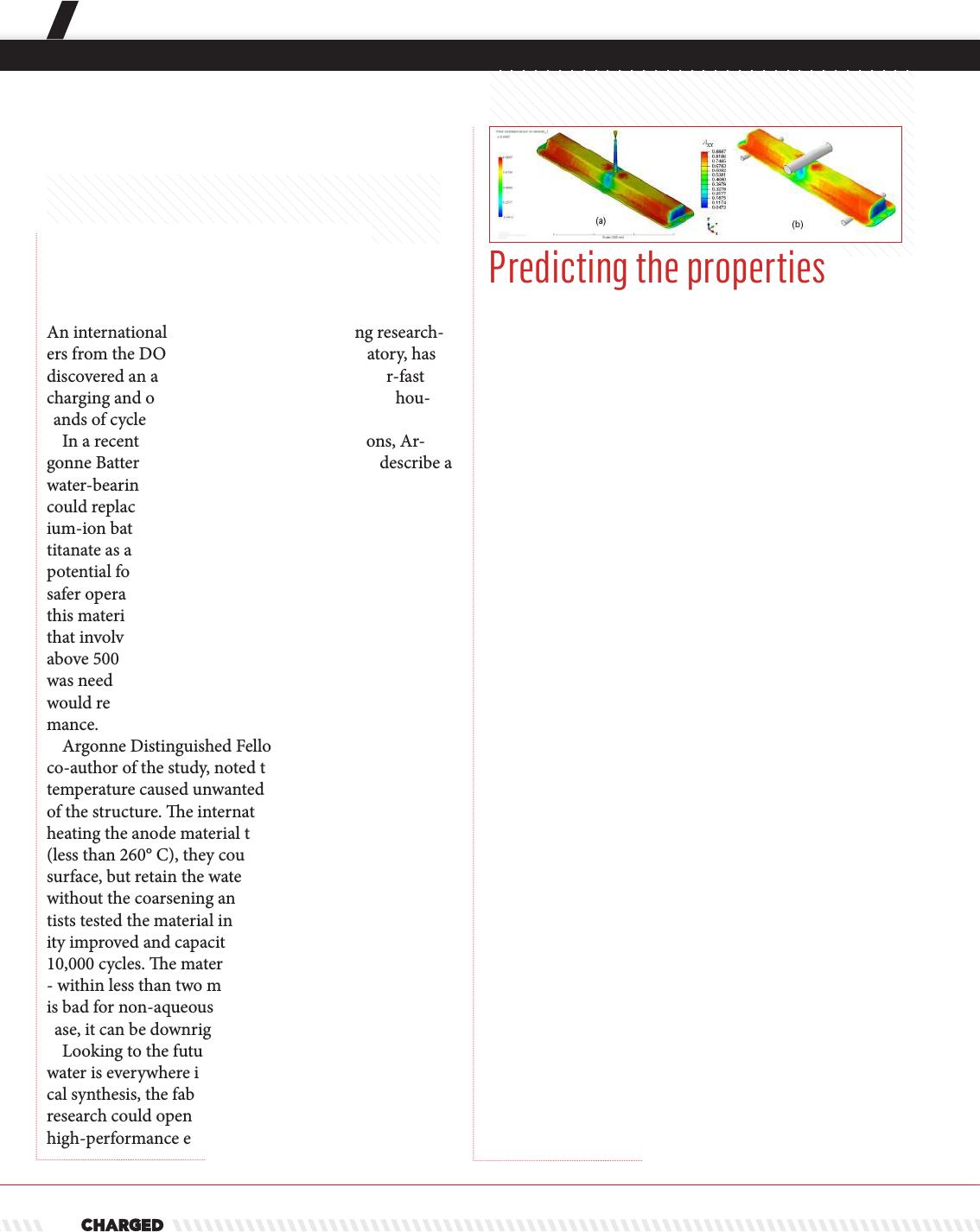
12
THE TECH
An international team of scientists, including research-
ers from the DOE’s Argonne National Laboratory, has
discovered an anode material that enables super-fast
charging and oers stable operation over many thou-
sands of cycles.
In a recent article in Nature Communications, Ar-
gonne Battery Scientist Jun Lu and colleagues describe a
water-bearing compound, lithium titanate hydrate, that
could replace the graphite anode commonly used in lith-
ium-ion batteries. Past research had identied lithium
titanate as a promising anode material, because of its
potential for fast charging and long cycle life, as well as
safer operation compared with graphite. In synthesizing
this material, researchers used a water-based process
that involved a nal step of heating the anode material to
above 500° C to drive out the water completely. is step
was needed because, during battery operation, the water
would react with the electrolyte and degrade perfor-
mance.
Argonne Distinguished Fellow Khalil Amine, a
co-author of the study, noted that heating to such a high
temperature caused unwanted coarsening and clumping
of the structure. e international team found that, by
heating the anode material to a much lower temperature
(less than 260° C), they could remove the water near the
surface, but retain the water in the bulk of the material
without the coarsening and clumping. When the scien-
tists tested the material in the laboratory, cycling stabil-
ity improved and capacity degraded only slightly over
10,000 cycles. e material also charged very quickly
- within less than two minutes. “Most of the time, water
is bad for non-aqueous lithium-ion batteries. But in this
case, it can be downright good,” said Jun Lu.
Looking to the future, Jun Lu observed that, because
water is everywhere in nature and common in chemi-
cal synthesis, the fabrication approach reported in this
research could open the door to discovery of other
high-performance electrode materials.
Aqueous anode enables
super-fast charging
Carbon ber-reinforced plastics represent a promising
lightweight replacement for heavy steel. However, for
carbon ber to be widely adopted, new, more economical
composites need to be developed. Unfortunately, carbon
ber properties are dicult to model, as they depend on
complex features such as ber loading, length distribu-
tion and orientation.
Now researchers at the DOE’s Pacic Northwest Na-
tional Laboratory (PNNL), in partnership with Toyota,
Magna, carbon ber supplier PlastiComp, and soware
provider Autodesk, have developed a set of predictive
engineering tools that could speed the development.
Currently, in order to test new composite components,
carmakers must build molds, mold parts, and test them
- a long and costly process. Using the PNNL-led team’s
engineering soware, manufacturers will be able to
evaluate the structural characteristics of proposed new
carbon ber composites without building molds, allow-
ing designers to experiment much more quickly.
e team used Autodesk Moldow soware to predict
ber orientation and ber length distribution in molded
components. Using materials from PlastiComp, long
carbon ber components were molded and the bers
extracted for measurement. PNNL then compared the
predicted properties from the simulation soware to the
test results of the molded bers, and found that the so-
ware tool successfully predicted ber length distribution
in all cases and ber orientation in 88 percent of cases.
PNNL worked with Magna and Toyota to analyze the
performance gains and costs of long carbon ber com-
ponents versus standard steel and berglass composites.
PNNL found the polymer composite studied could re-
duce the weight of auto components by over 20 percent.
However, production costs can be 10 times higher than
those of steel.
Predicting the properties
of lightweight carbon fiber
composites
Image courtesy of PNNL
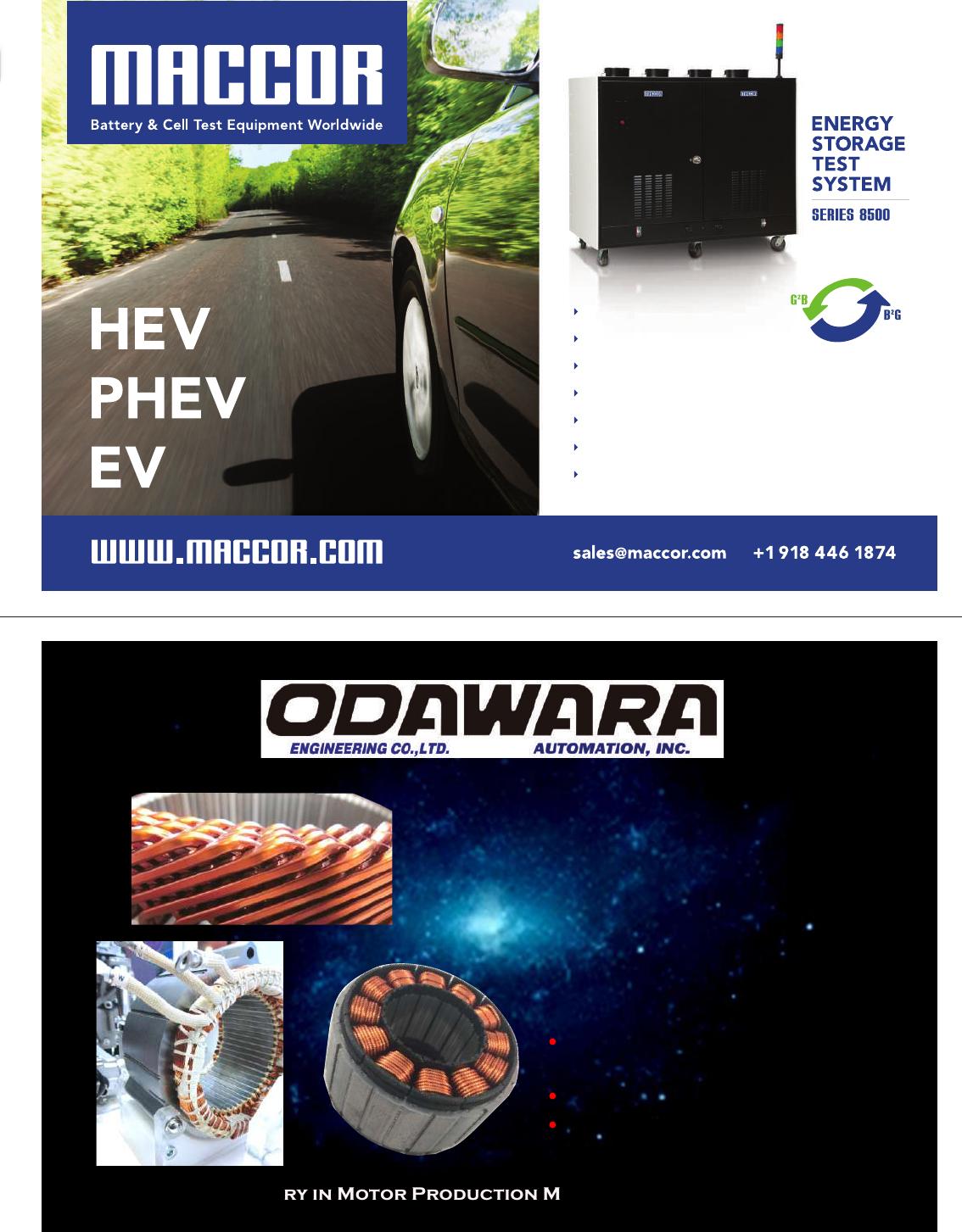
Leading the Industry in Motor Production Methods for The New Millennium.
•Hairpin / Solid
Conductor Winding
•Precision Winding & Insertion
•Segment Winding
www.odawara.com
www.odawara-eng.co.jp
New Year with
Leader in EV & Hybrid
Stator Winding
Looking to The
You in Mind.
Run
Module and pack level testing
CAN, I2C SMBus capable
Drive cycle simulation
Import drive cycle from table of values
Battery power is recycled to AC grid in discharge
Utilizes Maccor’s standard battery test software suite
No system power limit, up to 900KW
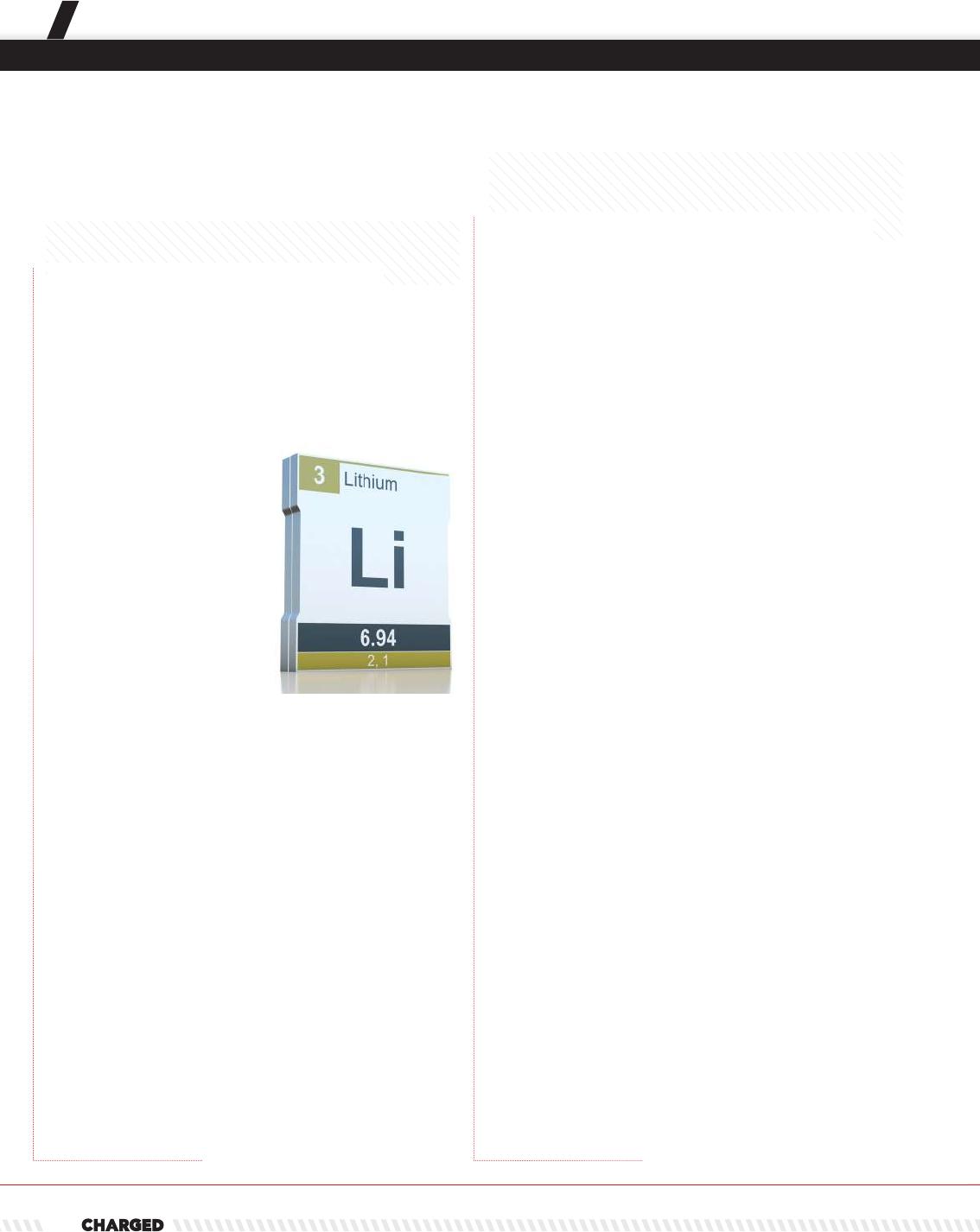
14
THE TECH
Toyota Tsusho, a member
of the Toyota Group, has
signed a share subscription
agreement with Orocobre
to become a 15% share-
holder. e total investment
amount will be about $292
million Australian.
e company expects
lithium demand to contin-
ue growing with the shi
to EVs, in addition to the
steady growth of battery-powered consumer electronics.
Demand growth to date has seen the price of lithium
more than double over the past few years.
Toyota Tsusho and Orocobre have been long-term
partners in the development of the Olaroz Lithium
Facility in Argentina, a lithium brine project, which was
brought into successful production in 2014, and Toyota
Tsusho has established a worldwide sales network for
lithium from Olaroz since the rst production.
e capital from Toyota Tsusho’s strategic investment
will be used primarily for the expansion of the Olaroz
Project (Phase 2), which aims to increase capacity by
25,000 tons per year (lithium carbonate equivalent)
bringing the total capacity of the Olaroz Project to
42,500 tons per year.
e Phase 2 expansion plan is expected to be com-
missioned in the second half of 2019. Toyota Tsusho
will be appointed as the exclusive sales agent for Phase
2 production and will to respond to the growing market
demand.
Toyota Tsusho to acquire
15% stake in Australian
lithium mining company
Orocobre
Five American-based organizations are receiving $2.25
million in technical assistance from Department of En-
ergy national laboratories to further develop lightweight
materials technologies and more ecient vehicles. e
awards are part of the DOE’s LightMAT - the Light-
weight Materials Consortium.
• Sandia National Laboratories, Oak Ridge National
Laboratory, and Pacic Northwest National Laboratory
will partner with Mallinda LLC to characterize micro-
scopic structural defects and evaluate the high-speed
impact on the company’s malleable thermoset carbon
ber-reinforced plastic technology.
• Magna Services of America will team up with PNNL
to fabricate a non-rare earth magnesium bumper beam
using PNNL’s ShAPE technology. ShAPE, or Shear As-
sisted Processing and Extrusion, is a new technology
that fabricates bumper beams with sucient strength,
ductility, and energy absorption properties without
the need for costly rare earth additives and elevated
temperature processing.
• GM will partner with PNNL to develop a predictive
performance model of dissimilar metallic spot-welds
for joining aluminum to steel. Currently, automotive
researchers are unclear about the factors that are most
critical for predicting joint failures when welding alu-
minum and steel together.
• Eck Industries will work with PNNL to lower costs
and address mechanical property issues in aluminum
castings. e additional iron content found in recycled
aluminum limits usability in performance applications
because of reduced overall strength and durability.
• e computational capabilities at Los Alamos National
Laboratory will be used to help the Edison Welding
Institute improve the robustness of a manufacturing
method called magnetic pulse welding which can
eectively join dierent metals together.
DOE awards $2.25 million to
develop lightweight vehicle
materials

Solid Power has grown rapidly since it was established in
2012 as a spin-out company from the University of Col-
orado. e battery developer recently moved into a new
facility in Louisville, Colorado
that will triple its footprint.
Now the company has an-
nounced a partnership with the
BMW Group to develop its sol-
id-state batteries for EV applica-
tions. e new facility will enable
Solid Power to deliver commer-
cial-quality battery prototypes.
The Power in Electrical Safety
©
www.bender.org
Bender’s ground fault detector, the ISOMETER® IR155-3204 and
iso165C, provide safety in hybrid and electric vehicles as well as
in Formula 1.
The IR155-3204 and iso165C monitor the
complete vehicle electrical drive system and
provide effective protection against electric
shocks and fire hazards.
Safety for vehicles
We support
the Formula
Hybrid Teams
The Power in Electrical Safety
©
www.bender.org
Bender’s ground fault detector, the ISOMETER® IR155-3204 and
iso165C, provide safety in hybrid and electric vehicles as well as
in Formula 1.
The IR155-3204 and iso165C monitor the
complete vehicle electrical drive system and
provide effective protection against electric
shocks and fire hazards.
Safety for vehicles
We support
the Formula
Hybrid Teams
The Power in Electrical Safety
©
www.bender.org
Bender’s ground fault detector, the ISOMETER® IR155-3204 and
iso165C, provide safety in hybrid and electric vehicles as well as
in Formula 1.
The IR155-3204 and iso165C monitor the
complete vehicle electrical drive system and
provide effective protection against electric
shocks and fire hazards.
Safety for vehicles
We support
the Formula
Hybrid Teams
ther validation that solid-state battery innovations will
continue to improve electric vehicles.”
BMW partners with Solid Power to develop solid-state batteries
Solid Power’s solid-state batter-
ies are comprised of proprietary
inorganic materials, and contain
no volatile or ammable compo-
nents. According to the company,
the technology has great poten-
tial to provide BMW’s EVs with
increased driving range and a
battery with a longer shelf life that
can withstand high temperatures.
“Since the company’s inception,
the Solid Power team has worked
to develop and scale a competitive
solid-state battery, paying special
attention to safety, performance,
and cost,” said Doug Campbell,
founder and CEO of Solid Power.
“Collaborating with BMW is fur-
????
Photo courtesy of BMW
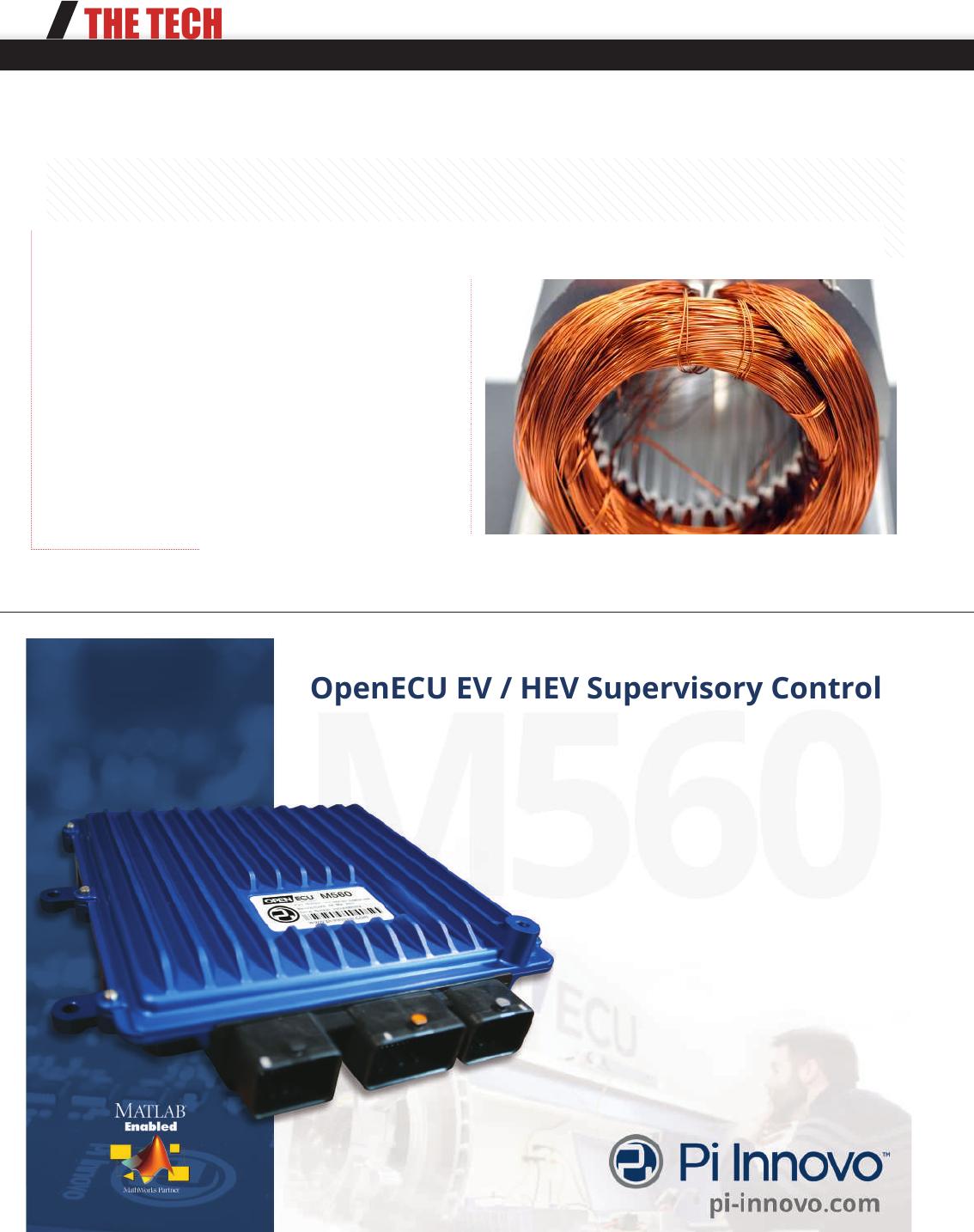
THE TECH
OpenECU EV / HEV Supervisory Control
The OpenECU M560
• Designed for complex hybrid and EV applications
• Meets ISO26262 ASIL D functional
safety requirements
• 112 pins of exible I/O
including 4 CAN buses
• Comprehensive fault diagnosis
supporting functional safety as
well as OBD requirements
Contact Pi Innovo today and see how the
M560 can support your Hybrid/EV program.
????
Groupe PSA, owner of the Peugeot, Citroën, DS, Opel
and Vauxhall brands, and Nidec Leroy-Somer, a French
manufacturer of small precision motors, plan to form a
joint venture to develop a range of traction motors for
electried vehicles. e 50/50 JV will receive an initial
investment of €220 million ($262 million).
e main components of the electric powertrain will
be designed and produced in France. e JV will supply
traction motors to Groupe PSA’s vehicles, and possibly to
other OEMs as well.
Groupe PSA expects the market for automotive elec-
tric motors to double to $53.5 billion by 2030.
Groupe PSA and Nidec form JV for automotive traction motors
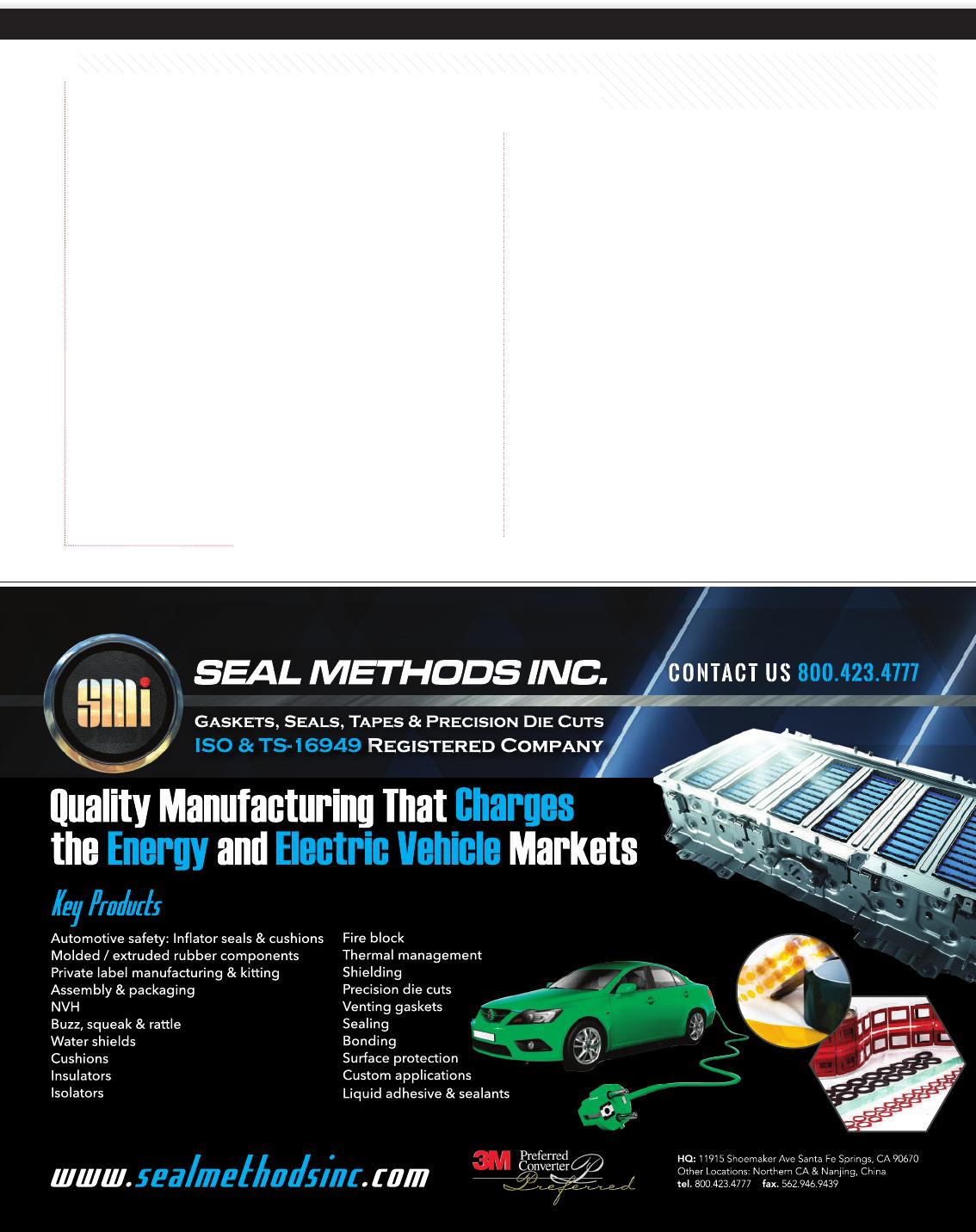
Run
Reducing charging time by increasing charging current
can have a negative eect on battery lifetime and safe-
ty. One reason for this is a phenomenon called lithium
plating.
“e rate at which lithium ions can be reversibly
intercalated into the graphite anode, just before lithium
plating sets in, limits the charging current,” explains
Johannes Wandt of Munich Technical University.
Wandt is one of a team of researchers at Munich and
two other German universities who have developed an
analytical technique that provides new insights into lithi-
um plating and how it aects charging rates.
In a paper published in Elsevier’s Materials Today, the
researchers explain that if the charging rate is too high,
lithium ions deposit as a metallic layer on the surface
of the anode rather than inserting themselves into the
graphite. “is undesired lithium plating side reaction
causes rapid cell degradation and poses a safety hazard,”
Dr. Wandt said.
New insight into lithium metal plating
Dr. Wandt and his colleagues set out to develop a new
tool to detect the actual amount of lithium plating on a
graphite anode in real time. e result is a technique the
researchers call operando electron paramagnetic reso-
nance (EPR).
EPR detects the magnetic moment associated with
unpaired conduction electrons in metallic lithium with
very high sensitivity and time resolution.
“In its present form, this technique is mainly limited to
laboratory-scale cells, but there are a number of possible
applications,” explains researcher Dr. Josef Granwehr.
“So far, the development of advanced fast charging
procedures has been based mainly on simulations, but
an analytical technique to experimentally validate these
results has been missing. e technique will also be very
interesting for testing battery materials and their inu-
ence on lithium metal plating - in particular, electrolyte
additives that could suppress or reduce lithium metal
plating.”
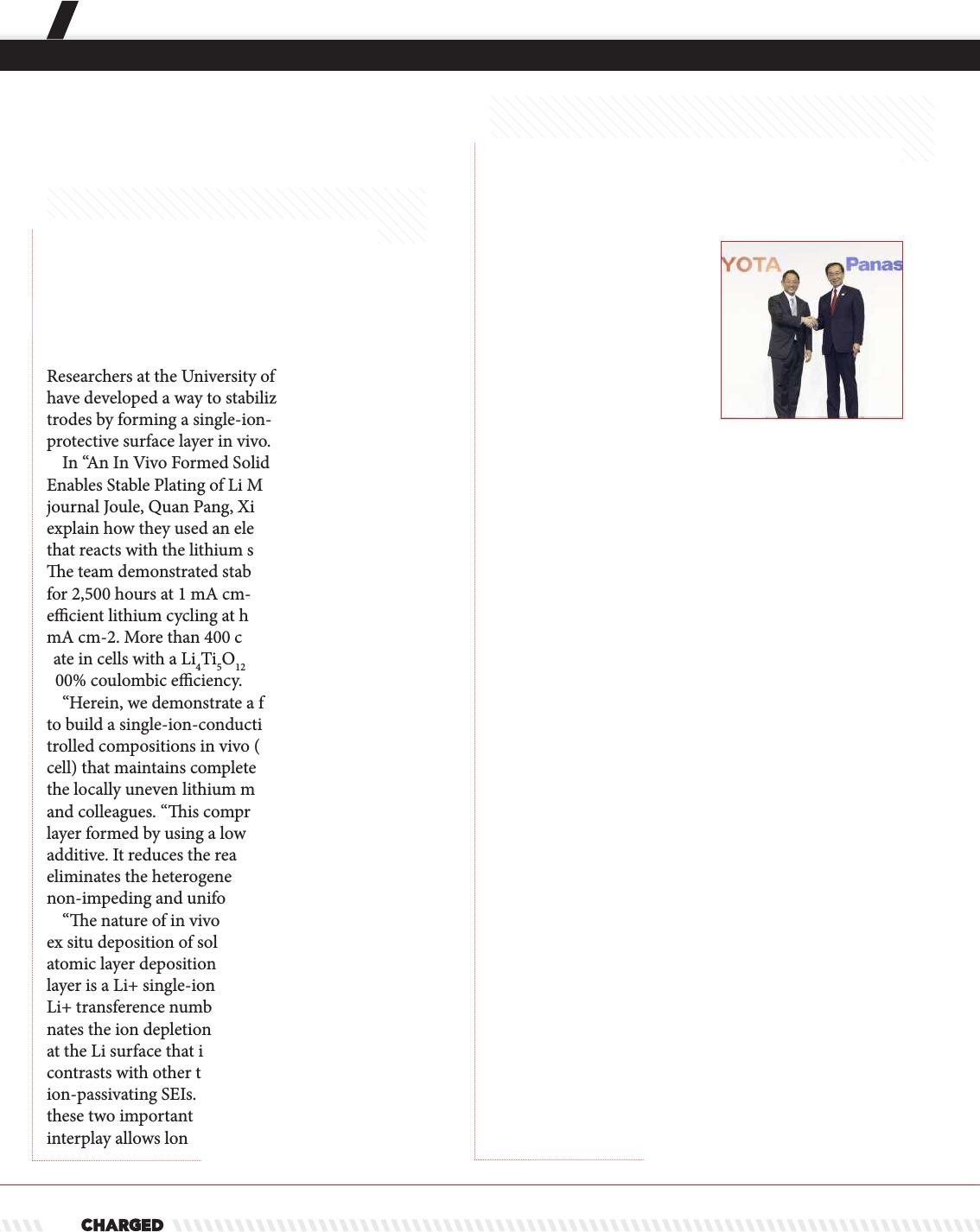
18
THE TECH
Researchers at the University of Waterloo in Canada
have developed a way to stabilize lithium metal elec-
trodes by forming a single-ion-conducting and stable
protective surface layer in vivo.
In “An In Vivo Formed Solid Electrolyte Surface Layer
Enables Stable Plating of Li Metal,” published in the
journal Joule, Quan Pang, Xiao Liang and colleagues
explain how they used an electrolyte additive complex
that reacts with the lithium surface to form a membrane.
e team demonstrated stable lithium plating/stripping
for 2,500 hours at 1 mA cm-2 in symmetric cells, and
ecient lithium cycling at high current densities up to 8
mA cm-2. More than 400 cycles were achieved at a 5-C
rate in cells with a Li
4
Ti
5
O
12
counter electrode at close to
100% coulombic eciency.
“Herein, we demonstrate a facile and scalable approach
to build a single-ion-conducting SEI layer with con-
trolled compositions in vivo (i.e., inside the assembled
cell) that maintains complete and intimate contact with
the locally uneven lithium metal surface,” write Pang
and colleagues. “is comprises a thin amorphous Li
3
PS
4
layer formed by using a low-concentration electrolyte
additive. It reduces the reactions with the electrolyte and
eliminates the heterogeneity of the SEI, thus allowing a
non-impeding and uniform Li+ ux.”
“e nature of in vivo formation distinguishes it from
ex situ deposition of solid electrolytes (SE), such as
atomic layer deposition. More importantly, the Li
3
PS
4
layer is a Li+ single-ion conductor with a theoretical
Li+ transference number of unity, which ideally elimi-
nates the ion depletion and strong electric eld buildup
at the Li surface that inspire dendrite growth. is also
contrasts with other types of articial or additive-driven
ion-passivating SEIs. We show experimental evidence of
these two important aspects and demonstrate that their
interplay allows long-life dendrite-free lithium plating.”
Waterloo team develops a
low-cost way to stabilize
lithium metal anodes
Toyota and Panasonic have
agreed to begin studying the
feasibility of a joint auto-
motive prismatic battery
business.
Panasonic has positioned
lithium-ion batteries as one
of its key businesses, and its automotive batteries are
used by many automakers worldwide. Toyota, maker of
the Prius hybrid and the Mirai fuel cell vehicle, has been
a holdout when it comes to developing pure EVs, but
there are signs that this policy is changing. Now the two
companies say they aim to develop the best automotive
prismatic battery in the industry.
“To solve issues currently confronting us worldwide,
such as global warming, air pollution, the depletion of
natural resources and energy security, it will be necessary
to further the popularization of electried vehicles,” said
Toyota President Akio Toyoda. “e automotive indus-
try is now facing an era of profound transformation, the
likes of which come only once every 100 years. No longer
can we expect a future by adhering to our current path.
Panasonic has accumulated its industry-leading capabil-
ity to develop automotive batteries over many years, and
Toyota has accumulated vehicle electrication technolo-
gies through the development of hybrid vehicles. Toyota
also loves cars and is determined to never let them
become commodities.”
“Today, the surging demand for electried vehicles is
changing the landscape of the automobile industry and,
moreover, drastically transforming its entire structure,”
said Panasonic President Kazuhiro Tsuga. “e battery is
a key device in promoting the widespread use of elec-
tried vehicles, and thus toward achieving a sustainable
society. Panasonic can never survive if we simply cling to
our current business models. erefore, always hav-
ing the mindset of a challenger, we will strive to create
contributions toward the widespread use of electried
vehicles, fully utilizing our assets and strengths nurtured
over the past 100 years.”
Toyota and Panasonic explore
joint prismatic battery
development
Photo courtesy of Toyota

Advanced energy solutions
to meet your growing needs
for testing, conditioning,
simulation and lifecycling.
Expanding the FTF-HP
power
to
you!
MEGA
Expanding the FTF-HP
4MW
· EV / HEV/ PHEV Pack Testing
· Inverter, UPS, Generator and
Flywheel Testing
· Microgrid Battery Conditioning
· Drive Cycle Simulation
· Bidirectional DC Power Supply
· Super and Ultra-Capacitor Testing
Advanced Energy
Technology Applications
2017 Bitrode Corporation ™
info@bitrode.com www.bitrode.com
1 MW
is an operating unit of
•Single or dual circuit models
available
• Over-current, under-
current, over voltage and
under-voltage protection
standard on all models
• Innite number of
program steps when used in
conjunction with VisuaLCN
software
• Remote Binary Protocol
available for control via 3rd
party software
• Battery simulator option
• Discharge power recycled to
AC line for cooler, more energy
ecient operation
• Current Rise Time (10-90%)
less than 4ms with zero
overshoot
• Optional Zero Volt testing
capability
• Other FTF options and custom
hardware/software capabilities
available.
Contact Bitrode to discuss your
requirements.
• Up to 1MW with available option for parallel
testing up to 2MW
www.sovemagroup.com
Spark EV is a new AI-based journey prediction telemat-
ics solution designed to help eet EVs complete more
journeys between charges, enabling greater eet utiliza-
tion.
A combination of sensor technology, cloud-based
analysis soware and a smartphone app, Spark EV ana-
lyzes live driver, vehicle and other data sources, such as
weather and congestion, then uses soware algorithms to
increase the accuracy of journey predictions. Using ma-
chine learning, the system automatically updates predic-
tions aer each journey, continually improving eciency.
Drivers and eet managers enter their journey through
the app, Spark EV’s web interface, or their existing eet
management soware, and the system advises whether
they will be able to complete it, based on live data, previ-
ous trips and charging locations.
Spark EV telematics solution aims to increase productivity for
EV fleets
Sold as a monthly subscription, Spark EV is designed
to easily integrate with existing eet management/sched-
uling systems through its open API, and can also be
used as a standalone solution for smaller eets. It can be
installed with all current EVs.
“Fleet managers understand that the future increas-
ingly revolves around electric vehicles,” said Spark EV
Technology CEO Justin Ott. “However, existing methods
of predicting range between charges are not accurate
enough for eet use, leading to range anxiety and a
consequent drop in productivity as managers cut back
the number of journeys to avoid potentially running out
of power. Spark EV increases productivity through more
accurate predictions that enable 20% more journeys
between charges.”
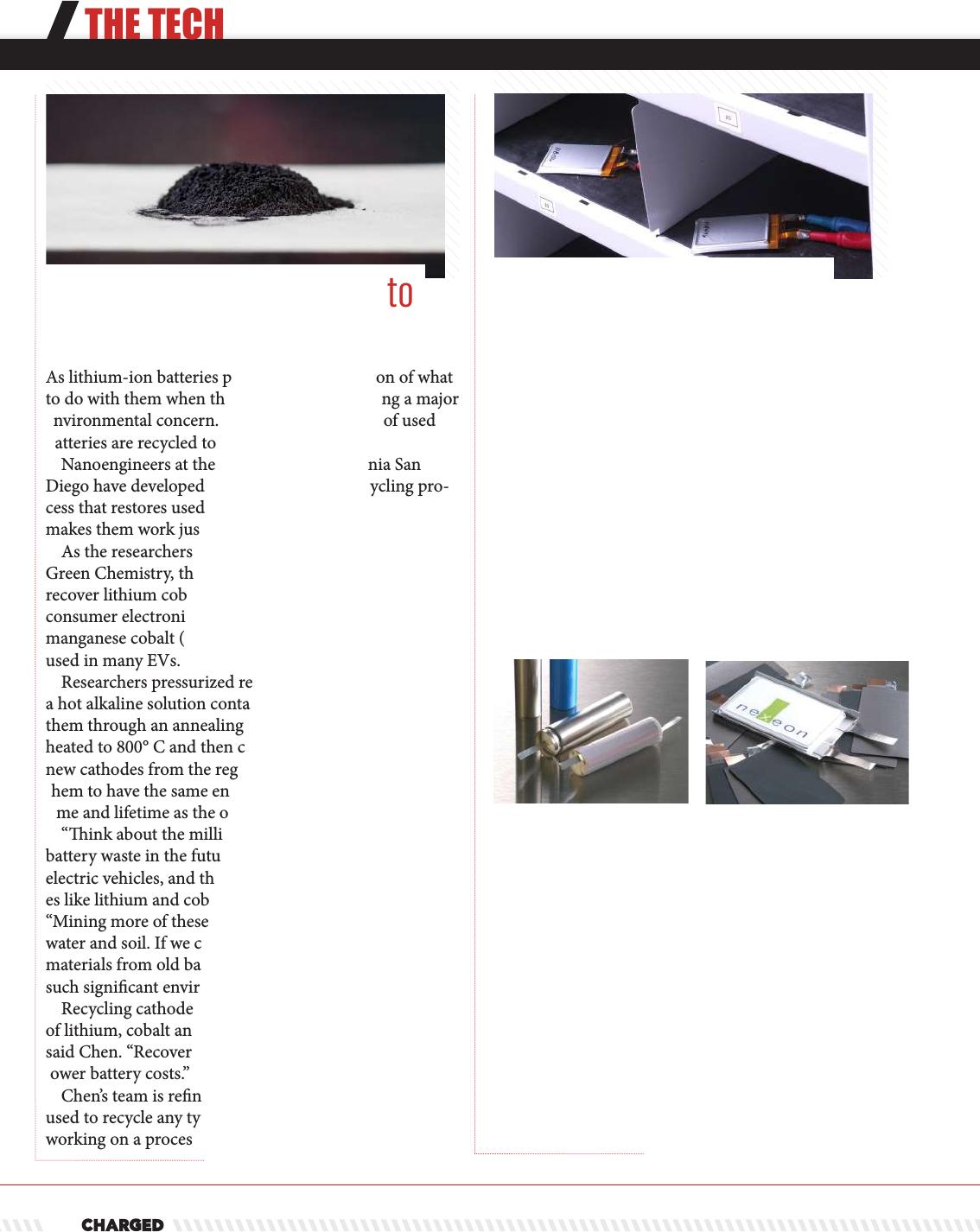
20
THE TECH
As lithium-ion batteries proliferate, the question of what
to do with them when they wear out is becoming a major
environmental concern. Less than ve percent of used
batteries are recycled today.
Nanoengineers at the University of California San
Diego have developed an energy-ecient recycling pro-
cess that restores used cathodes from spent batteries and
makes them work just as good as new.
As the researchers explain in a paper published in
Green Chemistry, the new method can be used to
recover lithium cobalt oxide, which is widely used in
consumer electronics. e method also works on nickel
manganese cobalt (NMC), a cathode material which is
used in many EVs.
Researchers pressurized recovered cathode particles in
a hot alkaline solution containing lithium salt, then put
them through an annealing process in which they were
heated to 800° C and then cooled very slowly. ey made
new cathodes from the regenerated particles and found
them to have the same energy storage capacity, charging
time and lifetime as the originals.
“ink about the millions of tons of lithium-ion
battery waste in the future, especially with the rise of
electric vehicles, and the depletion of precious resourc-
es like lithium and cobalt,” said Professor Zheng Chen.
“Mining more of these resources will contaminate our
water and soil. If we can sustainably harvest and reuse
materials from old batteries, we can potentially prevent
such signicant environmental damage and waste.”
Recycling cathodes would also save money. “e price
of lithium, cobalt and nickel has increased signicantly,”
said Chen. “Recovering these expensive materials could
lower battery costs.”
Chen’s team is rening the process so that it can be
used to recycle any type of cathode material, and is also
working on a process to recycle used anodes.
Recycling worn cathodes to
make new batteries
Silicon anode specialist Nexeon, along with a couple of
partners, has been awarded £7 million in Innovate UK
funding for the SUNRISE project, which will develop
battery materials based on silicon as a replacement for
carbon in the cell anode.
Nexeon will lead the silicon material development and
scale-up stages of the project, while polymer provider
Synthomer will lead the development of a next-gener-
ation polymer binder optimized to work with silicon,
and ensure anode/binder cohesion during a lifetime of
charges.
Nexeon and partners win
£7 million in funding to
develop silicon anode tech
Photos courtesy of Nexeon
Silicon is currently being adopted as a partial re-
placement for carbon - typically up to 10% - in battery
anodes, but problems caused by expansion when the
cells are charged and discharged remain a hurdle. Project
SUNRISE addresses the silicon expansion and binder
system issues, and allows more silicon to be used, further
increasing energy density.
“e biggest problems facing EVs - range anxiety, cost,
charge time or charging station availability - are almost
all related to limitations of the batteries,” says Nexeon
CEO Dr. Scott Brown. “Silicon anodes are now well
established on the technology road maps of major auto-
motive OEMs and cell makers, and Nexeon has received
support from UK and global OEMs, several of whom
will be involved in this project as it develops.”
Photo courtesy of David Baillot/UC San Diego Jacobs School of Engineering

YASA, a manufacturer of axial-ux electric motors and
controllers, has raised £15 million in growth funding,
bringing the total raised by the company to £35 million.
e new investment follows YASA’s signing of long-
term development and supply agreements with custom-
ers in the automotive sector. e company has recently
opened a new 100,000-unit capacity production facility
in Oxford, UK to meet the growing demand for its
products. YASA says that 80% of production is destined
for export to automotive manufacturers across the world,
including China.
In addition to automotive, YASA motors are used in
marine applications and in aerospace, elds in which
high power density and torque density are critical.
YASA secures £15m growth
funding, opens new Oxford
production facility
Dr. Chris Harris, YASA’s CEO, said, “Our customers
are looking to adopt innovative new technologies such as
YASA’s axial-ux electric motors and controllers in order
to meet the needs of the rapidly expanding hybrid and
pure electric automotive market. is additional £15 mil-
lion in growth funding will enable YASA to further in-
vest in the volume production capacity necessary to meet
our customers’ requirements, and to address markets
beyond automotive including aerospace and marine.”
Photo courtesy of YASA
Sales, Service, & Logistics
provided by Local Hongfa America Team
(714) 669-2888 | sales@hongfaamerica.com
www.hongfa.com
Charging Station
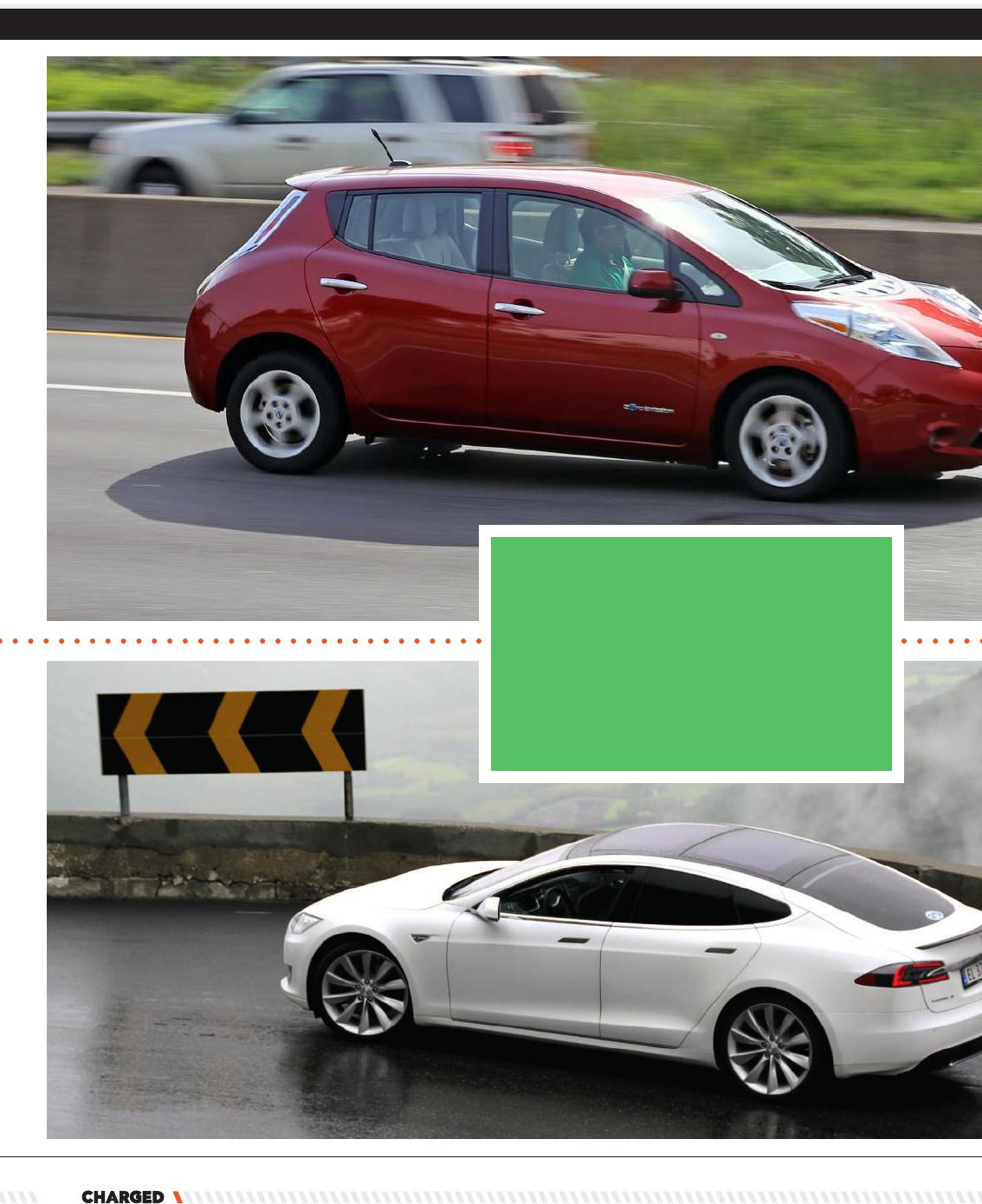
22
Photo courtesy of Norsk Elbilforening - CC BY 2.0
There are five primary factors
that go into determining how
much power is required to propel
a vehicle: velocity, mass, rolling
resistance, wind resistance and
the gradient of the road.
Photo courtesy of Vetatur Fumare - CC BY-SA 2.0
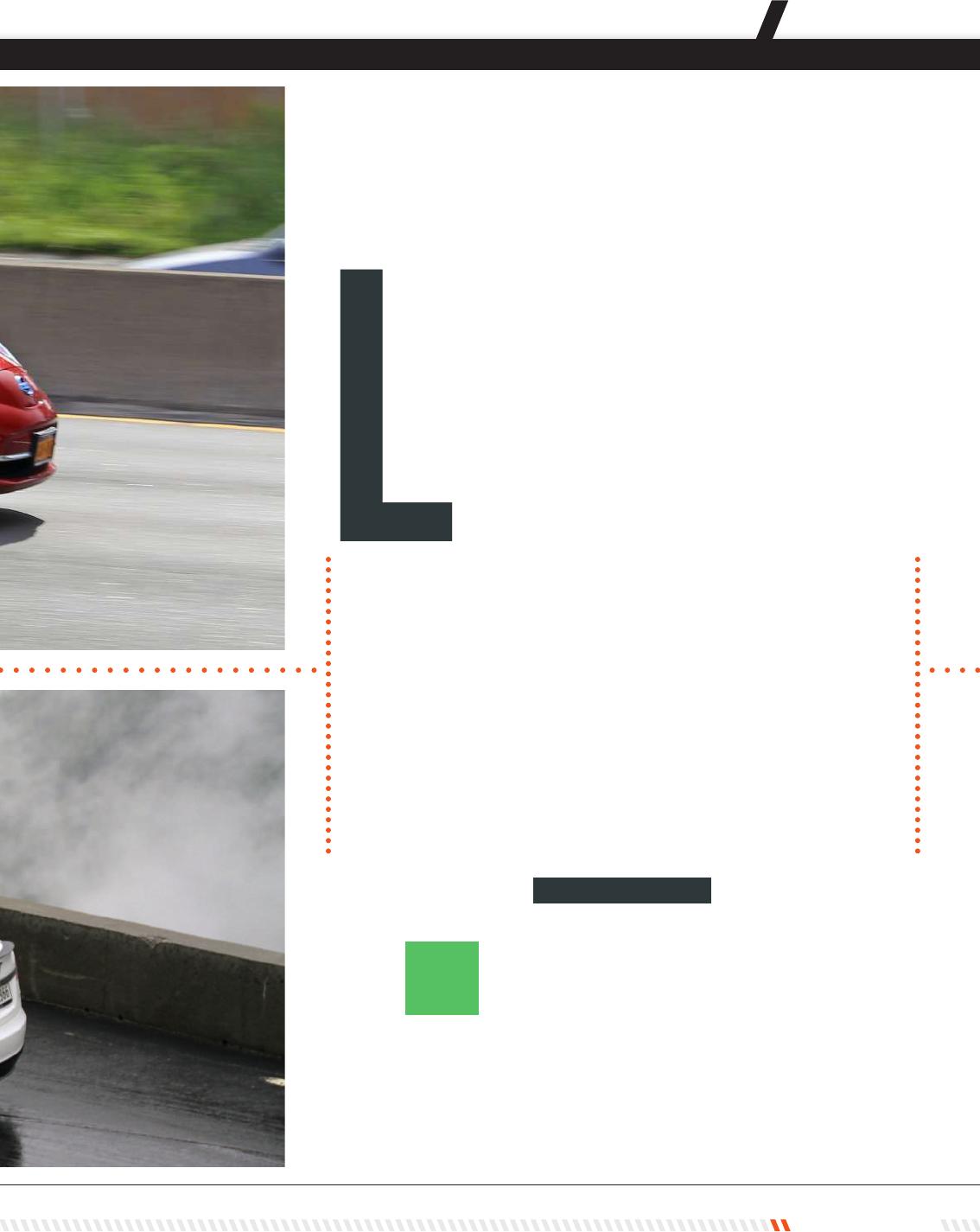
JAN/FEB 2018 23
THE TECH
LOOK
By Jeffrey Jenkins
hen it comes to factors that aect energy con-
sumption in EVs, the big kahunas are weight and
wind resistance (aka CdA), but there are other
factors that can have a surprisingly outsized
eect and that tend to be overlooked, such as the use of cli-
mate control (AC, of course, but especially heat). Conversely,
one factor which does not seem to aect energy consump-
tion all that much is the use of regenerative braking.
First, though, two terms that are confused or even used
interchangeably way too oen are power and energy. Power is
W
AT ENERGY
CONSUMPTION
IN EVS
A CLOSER

24
the reduced tire life and increased risk of a blowout.
Next is the contribution from wind resistance, which is
proportional to the square of speed, v (in m/s), air density,
ρ (1.2 kg/m³ for air at 20° C at sea level), drag coecient,
Cd (typically in the range of 0.3 to 0.4), and the frontal
area of the vehicle, A (in m²). e relevant equation to
nd the drag force from wind resistance is:
Fw = 0.5 * v² * ρ * Cd * A
For example, a vehicle traveling at 90 kph (25 m/s)
with a Cd of 0.35 and a frontal area of 2.2 m² requires
a force of 288.75 N to overcome wind resistance; at 120
kph that force increases to 513.33 N, or nearly double!
e last drag force is from a change in elevation, which
is the only one which can actually assist the vehicle (aside
from the unlikely scenario in which a tailwind is strong
enough to propel the vehicle all on its own). is equation
is a little less straightforward and requires some trigo-
nometry. If the incline of the road is not given in degrees,
then converting to such is the rst step. In the US, grade
is given as a percentage rise vs. a horizontal run, and
these gures correspond to the opposite and adjacent
sides of a right triangle (the vehicle itself drives along the
hypotenuse) so to convert percentage grade into degrees
a measure of the rate at which work can be done while en-
ergy is a measure of the amount of work done. Ignoring the
eect of wind resistance (which would otherwise disprove
what comes next), it will take the same amount of energy
to drive a 2,000 kg vehicle a distance of 1 km whether it is
going 1 kph or 2 kph or even 10 kph. Yes, the higher speed
requires more power, but it is applied for an inversely lower
amount of time, and energy is power * time.
Power
ere are ve primary factors that go into determining
how much power is required to propel a vehicle: veloc-
ity (aka speed), mass (aka weight, at least as long as the
vehicle remains on planet Earth), rolling resistance,
wind resistance and the gradient of the road. e latter
four components are used to determine the total drag
force opposing the vehicle’s motion, and speed should
be self-explanatory. e relevant physics equation that
combines all these factors together is deceptively simple:
P = F * v
Where P is power (in watts, W), F is the total drag
force acting on the vehicle (in Newtons, N), and v is the
velocity (in meters per second, m/s). e components that
make up the total drag force need to be evaluated for the
above equation to be useful, however. Also note that the
power required actually increases with the cube of the
speed of the vehicle, because speed is present in the power
equation above as well as speed squared in the equation
for wind resistance. Speed really does kill…eciency,
anyway.
Drag forces
e easiest drag force to evaluate is rolling resistance, Fr,
which is simply vehicle mass (in kilograms, kg) * gravita-
tional acceleration of your particular planet (9.81 m/s² for
Earth) * coecient of friction, Cf (a dimensionless number,
usually between 0.01 and 0.02 for most tires and roads):
Fr = m * 9.81 m/s² * Cf
For example, a 2,000 kg vehicle and a coecient of
friction between tires and road of 0.015 results in a drag
force from rolling resistance of 294 N, or a mere 30 kg of
force (1 N = 0.102 kg-f). is isn’t much force to over-
come, though rolling resistance does increase dramati-
cally if tires are underinated. Conversely, overinating
the tires to reduce rolling resistance isn’t really worth
Note that the power required
actually increases with the cube
of the speed, because speed is
present in power equation as well
as speed squared in the equation
for wind resistance. Speed really
does kill… efficiency, anyway.
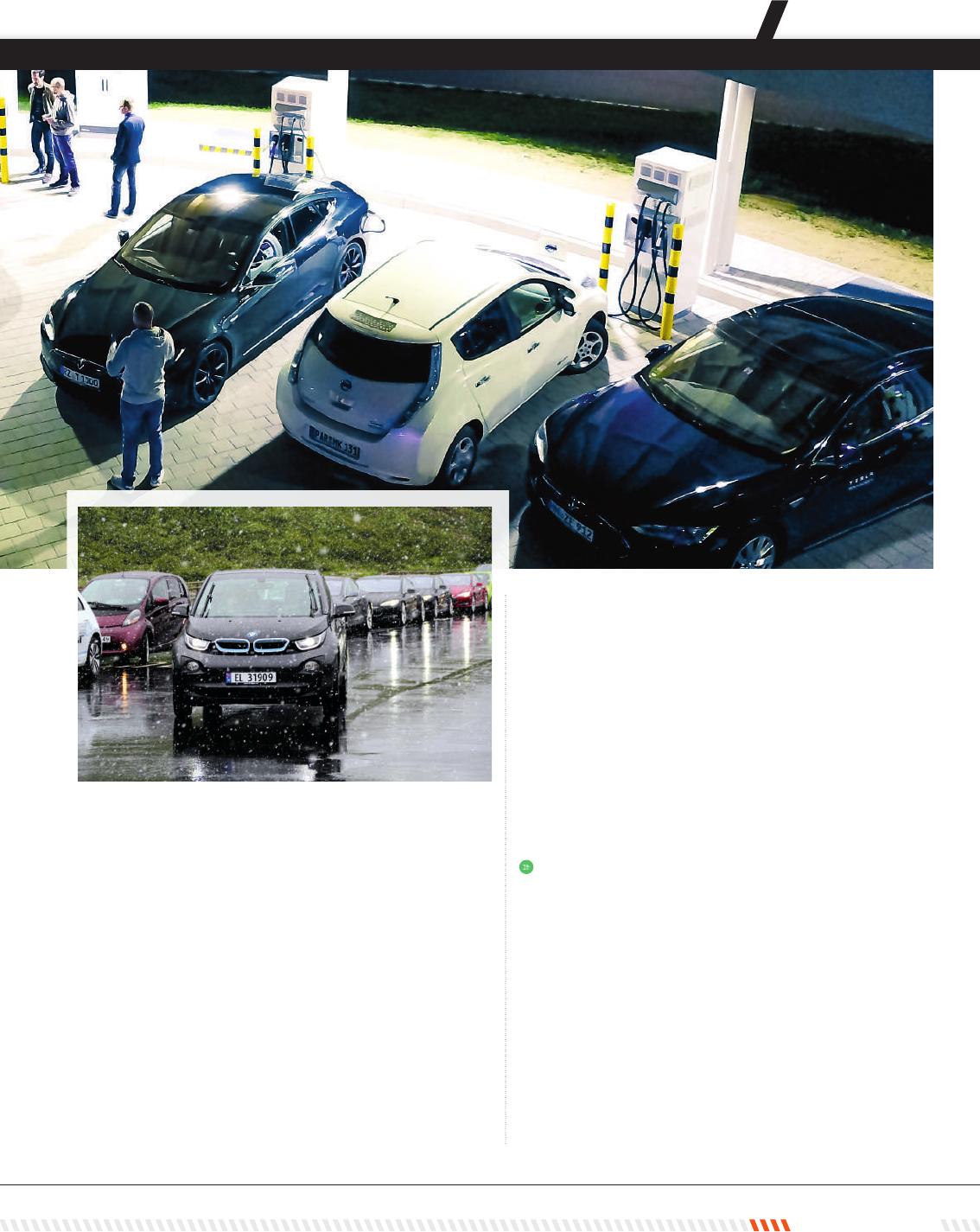
JAN/FEB 2018 25
Example: a 2,175 kg vehicle with 2.34 m² of frontal
area and a Cd of 0.24 traveling at 110 kph on a road with
a 5% grade:
Fr = 2,175 * 9.81 * 0.015 = 320.0 N
Fw = 0.5 * (110 / 3.6)² * 1.2 * 0.24 * 2.34 = 314.6 N
Fs = 2,175 * 9.81 * sin(2.86°) = 1,064.6 N
P = (320.0 + 314.6 + 1064.6) * (110 / 3.6) = 51,920 W
And if the road is at? Now the power required is
19,390 W. Slope is no joke!
Weight
Weight also has a direct impact on the amount of energy
it takes to change speed. It probably goes without say-
ing, but the heavier the vehicle the more energy will be
expended to increase its speed. e relevant formula for
determining such is:
K = 0.5 * m * v²
Where K is energy (in Joules, J, aka W-s), m is mass
(aka weight, in kg) and v is velocity (aka speed, in m/s).
For example, to increase the speed of a 2,000 kg vehicle
by 72 kph requires 400 kJ (or 0.111 kWh). at might not
seem like much, but it can add up surprisingly quickly
rst change percentage into decimal format (e.g., 10% =
0.1) then take the arctangent of the resulting number to
get the slope in degrees (e.g., arctan(0.1) = 5.71°).
With the slope in degrees the following equation can be
used to nd the drag force from a change in elevation:
Fs = m * 9.81 m/s² * sin(Θ)
Where Fs is the drag force from a slope in N (Fs is a
positive number if going up the slope and a negative num-
ber if going down), m is the vehicle mass in kg, 9.81 m/s² is
the gravitational acceleration of Earth, and Θ is the slope
in degrees. For example, a 2,000 kg vehicle going up a 10%
grade experiences a drag force of 1,952 N (or 199 kg-f).
Putting all the above together in another example
should help solidify an understanding of the concepts:
THE TECH
Photo courtesy of Jakob Härter - CC BY-SA 2.0
Photo courtesy of Norsk Elbilforening - CC BY 2.0

in stop-and-go trac, and the ability of EVs to recap-
ture some of this energy via regenerative braking is one
reason why they deliver superior “fuel” eciency in city
driving compared to their ICE counterparts.
Regen
While regenerative braking can recapture some of every
positive change in speed, keep in mind that energy must
be fully converted twice when regen is used, so it incurs
twice the losses.
Using the above equation for kinetic energy for a 1,000
kg vehicle decelerating from a speed of 100 kph gives a
result of 384 kW-s (kilowatt-seconds). Divide by 3,600 to
convert seconds to hours and that gives us a rather paltry
0.11 kWh of recovered energy - assuming 100% eciency.
Multiply 0.11 kWh by the price for electricity ($0.11
per kWh) and the resulting savings is $0.0121. Still, you
can’t make gasoline by braking in an ICE vehicle so any
energy recaptured by regen is better than nothing.
It bears mentioning that along with regen, the two
other reasons EVs excel in city driving are that they
don’t need to idle their motor while stopped, nor do
they need to use energy over and above what is required
to deliver good acceleration performance. In the bad
old days of carburetors and the rst port fuel injection
systems, there was a pump that literally sprayed a dollop
of fuel every time the accelerator pedal was pressed, just
to make sure the engine didn’t run too lean and stumble
(of course, the engine could also stumble from running
too rich).
Climate control
e nal factor that can aect energy consumption -
sometimes dramatically so - is cooling or heating the
cabin. Many rst-generation EVs used a conventional
automotive AC system, except that the compressor was
driven by its own electric motor, rather than by a belt to
the traction motor. Using a dedicated motor is a more
costly solution, but it is far superior, as the compressor
always runs at its optimal speed, allowing it to be more
ecient, and cooling isn’t lost every time the vehicle is
stopped, since the traction motor doesn’t idle in an EV.
One huge disadvantage of the conventional automo-
tive AC system is that it only pumps heat in one direc-
tion; there was no need for it to operate bidirectionally
(i.e., as what is commonly thought of as a “heat pump”)
because the ICE is a proigate producer of waste heat
which comes at no additional burden to the engine or fuel
economy. In contrast, the eciency of the EV inverter
and motor combination - the only potential sources of
waste heat of any magnitude - is typically in the high 90s
and the losses directly scale with power output, so you
might get a reasonable amount of waste heat climbing
hills all day, but very little driving the speed limit on any
limited-access highway in the US.
So, heating the cabin in an EV requires an additional
source of heat. Many early designs used resistance heat-
ing, as it is cheap, simple and 100% ecient at converting
electricity into heat. at last spec sounds impressive,
except that the typical compressor-type heat pump can
move around 2 - 4 W of heat for every 1 W of electrical
input power; the so-called “Coecient of Performance”
in refrigeration/HVAC parlance. is is also why switch-
ing from almost any kind of furnace to a heat pump tends
to save quite a bit of money heating a home. Another
bonus of the heat pump operating as a heater (rather than
as an AC) is that waste heat produced by the compressor
is useful, so the COP tends to be 1 higher in heating mode
compared to cooling.
For a more concrete example, the average vehicle needs
somewhere in the range of 4-8 kW of heating/cooling ca-
pacity, depending on interior volume, exposed glass area,
insulation R value, outside temperature, etc. If heating is
via electrical resistance then that will be a direct 4-8 kW
of additional drain on the battery, whereas if it is supplied
by a modern heat pump system with a COP of 4.0 in heat-
ing mode, then only 1-2 kW will be drawn (with 1.33-2.67
kW drawn in cooling mode, as COP will then be 3.0).
Using the previously worked example for vehicle power
demand, 19.4 kW was required to travel at 110 kph on
the at, so an additional draw of 2 kW for climate control
would be equivalent to increasing the speed by nearly 6
kph or decreasing the range by 10%. Bumping the draw
up to 8 kW for an electric resistance heater would be
equivalent to increasing speed to 130 kph or cutting range
by 40%!
THE TECH
26
You can’t make gasoline by
braking in an ICE vehicle so any
energy recaptured by regen is
better than nothing.
Photo courtesy of FotoSleuth - CC BY 2.0
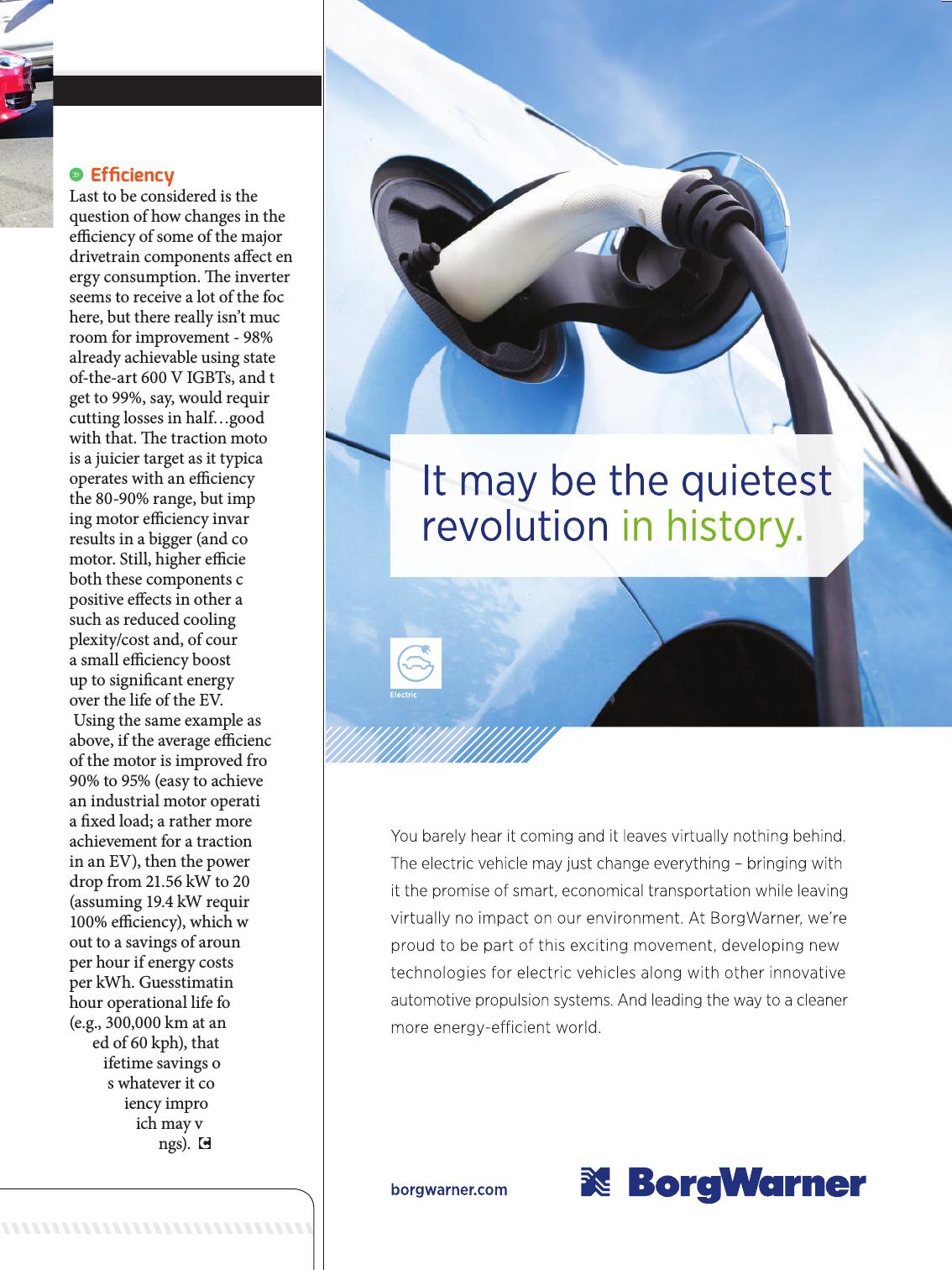
Efficiency
Last to be considered is the
question of how changes in the
eciency of some of the major
drivetrain components aect en-
ergy consumption. e inverter
seems to receive a lot of the focus
here, but there really isn’t much
room for improvement - 98% is
already achievable using state-
of-the-art 600 V IGBTs, and to
get to 99%, say, would require
cutting losses in half…good luck
with that. e traction motor
is a juicier target as it typically
operates with an eciency in
the 80-90% range, but improv-
ing motor eciency invariably
results in a bigger (and costlier)
motor. Still, higher eciency in
both these components can have
positive eects in other areas,
such as reduced cooling com-
plexity/cost and, of course, even
a small eciency boost can add
up to signicant energy savings
over the life of the EV.
Using the same example as
above, if the average eciency
of the motor is improved from
90% to 95% (easy to achieve for
an industrial motor operating at
a xed load; a rather more heroic
achievement for a traction motor
in an EV), then the power would
drop from 21.56 kW to 20.42 kW
(assuming 19.4 kW required at
100% eciency), which works
out to a savings of around $0.125
per hour if energy costs $0.11
per kWh. Guesstimating a 5,000
hour operational life for the EV
(e.g., 300,000 km at an average
speed of 60 kph), that works out
to a lifetime savings of $625,
minus whatever it cost to achieve
the eciency improvement (a
gure which may very well ex-
ceed the savings).

PERMANENT
MAGNET MACHINE
28
ost mainstream EVs from major automak-
ers have used some form of permanent
magnet traction motor technology, with
two high-prole exceptions: Tesla’s Model
S and Model X both use induction motor technology.
Internet engineering forums are full of compelling
arguments for using both technologies in vehicles,
as well as loads of speculation on what drove Tesla to
favor induction machines from day one.
e best explanation I’ve read is one based on
historical factors. By many accounts, the reason Tesla
started developing an induction motor in the rst place
is because it inherited the design from AC Propulsion.
e induction motor used in the Roadster actually
had roots going all the way back to GM’s EV1 motor,
which was designed by Alan Cocconi. Cocconi based
it on existing AC induction motor specs. Tesla ini-
tially licensed the design from Cocconi’s company, AC
Propulsion. However, Marc Tarpenning later said that
Tesla had completely redesigned its induction machine
“a year before we were in production…long before we
were even into the engineering prototypes.” A lot has
changed since those early days in terms of available
R&D technology and material costs.
In any case, Tesla’s exclusive use of induction ma-
chines has been intriguing to motor experts and EV te-
chies. So, it was particularly interesting in August 2017
when Model 3’s EPA certication application revealed
a big change in the powertrain - the document states
that Model 3 uses a 3-phase permanent magnet motor.
Tesla rarely oers ocial comment on technology
decisions, so it can be hard to discern the exact engi-
M
By Christian Ruoff
FOR MODEL 3
TESLA’S TOP MOTOR ENGINEER
TALKS ABOUT DESIGNING A
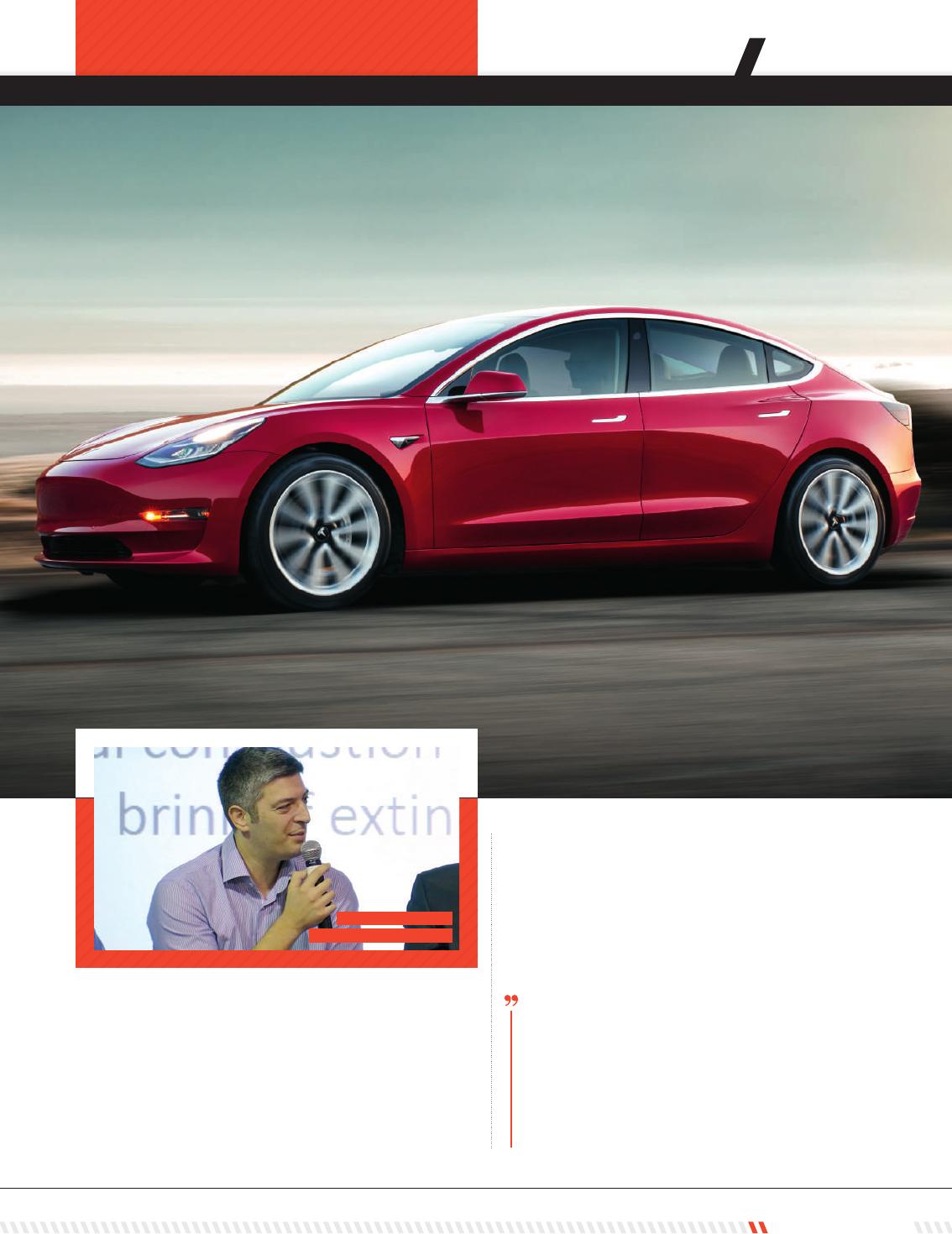
THE TECH
JAN/FEB 2018 29
jor automakers, Laskaris wasn’t at liberty to tell us
all about the specic quantitative analysis that led to
choosing a permanent magnet motor. However, he did
oer some interesting insights into the engineering
processes the company employed in the analysis.
e following is a transcript of our on-stage conver-
sation, edited slightly for clarity.
Konstantinos Laskaris: It’s well known that
permanent magnet machines have the benefit of
pre-excitation from the magnets, and therefore
you have some efficiency benefit for that. Induc-
tion machines have perfect flux regulation and
therefore you can optimize your efficiency. Both
make sense for variable-speed drive single-gear
transmission as the drive units of the cars.
neering thought process. Luckily, I recently moderated
a keynote panel discussion of EV tech experts at the
Coil Winding, Insulation & Electrical Manufacturing
Exhibition (CWIEME) in Chicago. e panel included
Konstantinos Laskaris, Tesla’s Chief Motor Designer,
so I had the chance to pry a few more details from the
world-class motor engineer.
As usual when interviewing engineers from ma-
Konstantinos Laskaris,
Tesla’s Chief Motor Designer
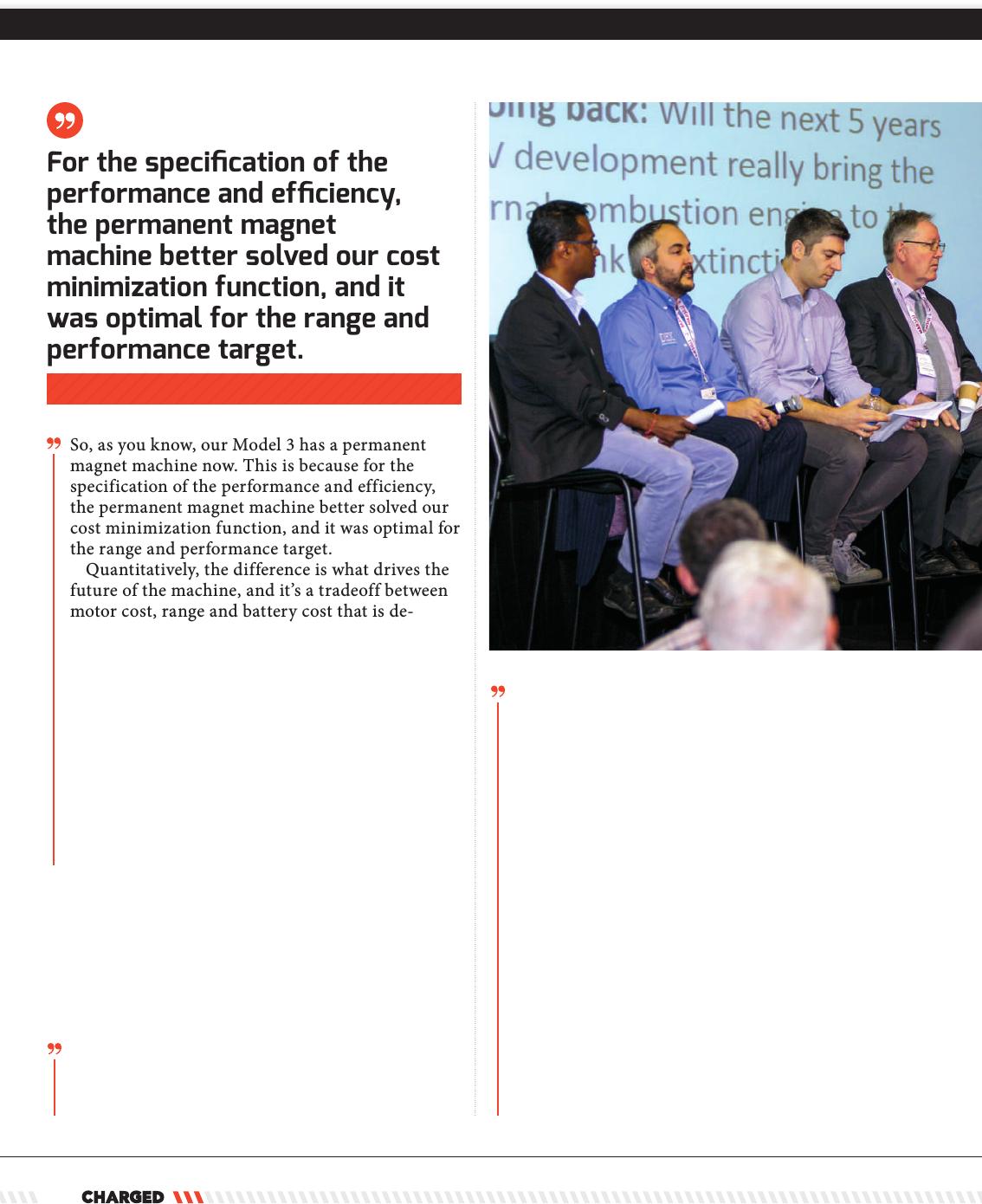
30
So, as you know, our Model 3 has a permanent
magnet machine now. This is because for the
specification of the performance and efficiency,
the permanent magnet machine better solved our
cost minimization function, and it was optimal for
the range and performance target.
Quantitatively, the difference is what drives the
future of the machine, and it’s a tradeoff between
motor cost, range and battery cost that is de-
termining which technology will be used in the
future.
Laskaris later added: When you have a range tar-
get [for example], you can achieve it with battery
size and with efficiency, so it’s in combination.
When your equilibrium of cost changes, then it
directly affects your motor design, so you justify
efficiency in a more expensive battery. Your opti-
mization is going to converge on a different motor,
maybe a different motor technology. And that’s
very interesting.
If you combine these comments with those made
by Laskaris during our 2016 on-stage interview at the
CWIEME event in Berlin, you begin to see a clearer
picture of the sophisticated process Tesla uses to
evaluate different motor designs and optimize them
for the specific desired parameters of each vehicle.
Laskaris: Understanding exactly what you want
a motor to do is the number-one thing for opti-
mizing. You need to know the exact constraints
- precisely what you’re optimizing for. Once you
know that, you can use advanced computer models
to evaluate everything with the same objectives.
This gives you a panoramic view of how each mo-
tor technology will perform. Then you go and pick
the best.
With vehicle design, in general, there is always a
blending of desires and limitations. These param-
eters are related to performance, energy consump-
tion, body design, quality, and costs. All of these
metrics are competing with each other in a way.
Ideally, you want them to coexist, but given cost
constraints, there need to be some compromises.
The electric car has additional challenges in that
battery energy utilization is a very important con-
sideration.
This is the beauty of optimization. You can pick
among all the options to get the best motor for the
constraints. If we model everything properly, you
can find the motor with the high-performance
0-60 constraint and the best possible highway ef-
ficiency.
For the specification of the
performance and efficiency,
the permanent magnet
machine better solved our cost
minimization function, and it
was optimal for the range and
performance target.
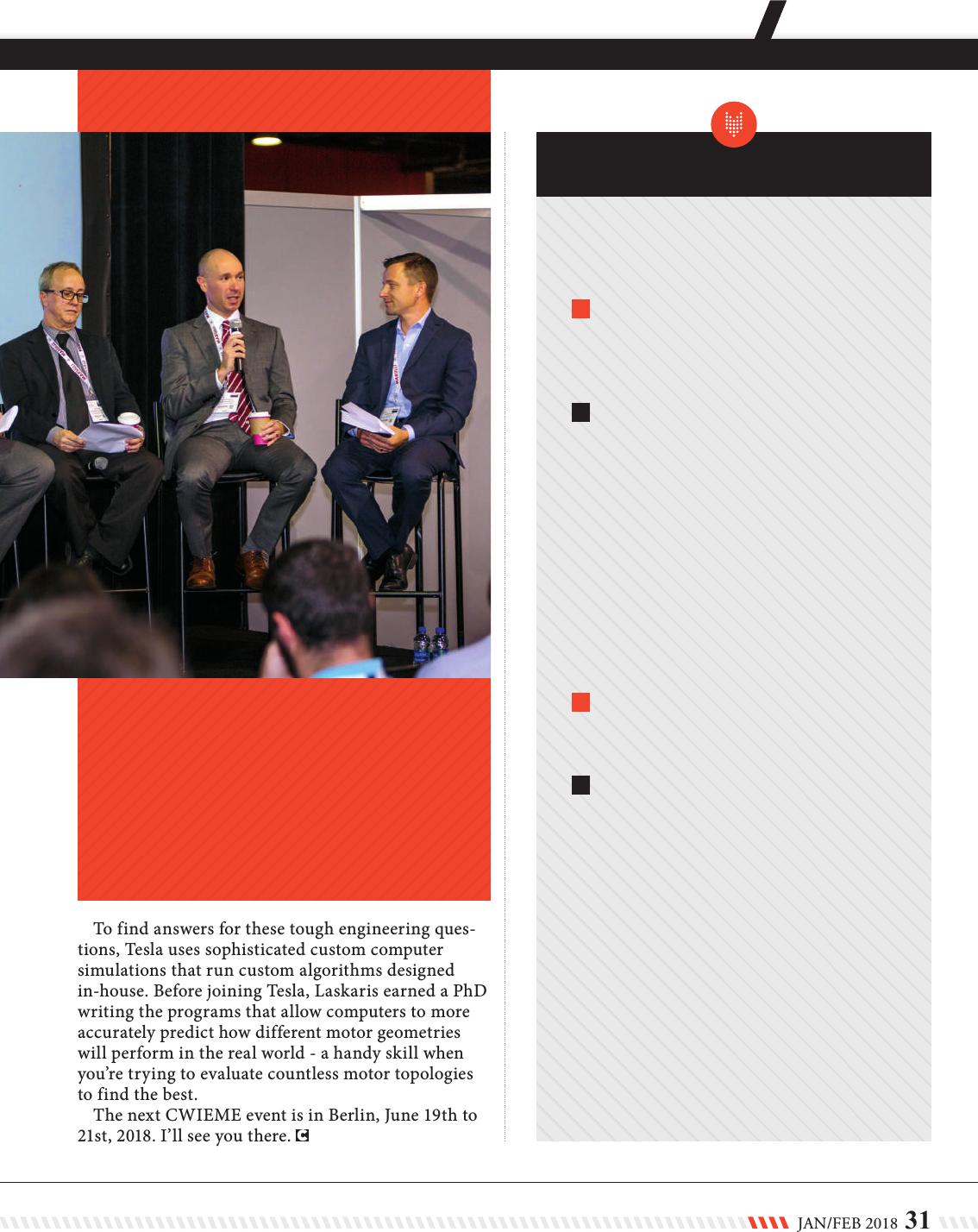
JAN/FEB 2018 31
To find answers for these tough engineering ques-
tions, Tesla uses sophisticated custom computer
simulations that run custom algorithms designed
in-house. Before joining Tesla, Laskaris earned a PhD
writing the programs that allow computers to more
accurately predict how different motor geometries
will perform in the real world - a handy skill when
you’re trying to evaluate countless motor topologies
to find the best.
The next CWIEME event is in Berlin, June 19th to
21st, 2018. I’ll see you there.
During our Chicago panel discussion, Laskaris also
made a few other comments that our motor enthu-
siast readers might nd interesting.
Q
What are the most critical motor design
parameters that EV motor designers care about?
High torque density, high power density, high
speed, size, etc?
A
Laskaris: Power density is a very important
parameter. For electric vehicles you have the gear
that can transform the power density into torque
density. Therefore you can take advantage of a
power-dense machine being compact, and can create
the requested tractive eort to the car. Also, power
density is minimizing the materials cost. So when the
specications allow for a power density increase it
should always be taken. I think that is a rule for motor
design. You can build power density through torque
density and through speed, and you should not be
neglecting one thing for the other when you’re
designing a machine for particular specications.
Q
How is stator and rotor cooling technology
impacting electric machine design - for example,
slot cooling, water jackets, direct coil cooling, etc?
A
Laskaris: The rotor thermals and the stator
thermals are aecting the design of the motor in
dierent operating conditions. Like when you’re at
dierent torque speed points, you’re constraining
the rotor thermals and the stator thermals,
especially when you’re operating in eld weakening
in variable-speed drive single-gear transmissions.
This means that cooling technologies can have
dierent gravity according to what you are designing
for, and dierent eectiveness. Overall, cooling
technology allows you to achieve higher continuous
capability in the machine. And that’s very important
because that drives the size of the machine as well.
So you can cost-eectively design machines that do
the same thing if you can drive them at higher
continuous points.
THE TECH
The EV technology expert panelists at the CWIEME Chicago
event included, from left to right,
• Jaydip Das - Carpenter Technology Corporation,
• J. Rhett Mayor - DHX Machines,
• Konstantinos Laskaris - Tesla,
• Peter B. Littlewood - Argonne National Laboratory,
• Tom Prucha - Protean Electric,
• Matthew Doude - Mississippi State University, and
• Christian Ruoff - Charged Electric Vehicles Magazine.
A broader discussion
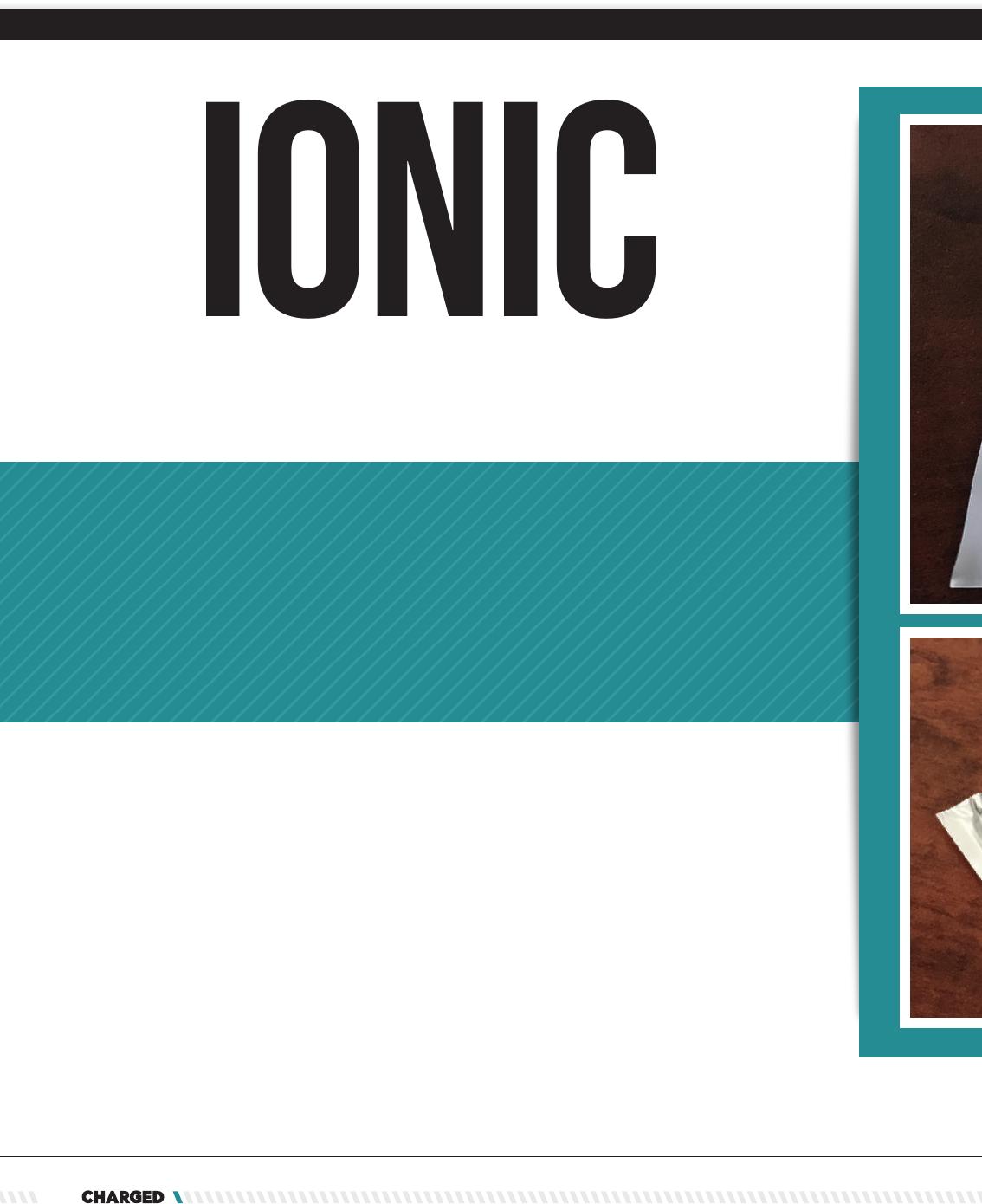
By Paul Beck
IONIC
MATERIALS
IN SOLID-STATE BATTERIES
BY FOCUSING ON
EMERGES AS A LEADER
POLYMER
SCIENCE
32
Photo courtesy of Ionic Materials

THE TECH
ike Zimmerman, CEO and founder of Ionic
Materials, has this to say about his company:
“Ionic will play a major role in the solution
to the world’s energy problems.”
at’s a pretty bold statement. But then again, Mike
Zimmerman is a pretty bold man. An experienced
polymer scientist, Zimmerman has worked on a number
of ground-breaking technologies, from the rst ber-
to-the-home system in electronics to the rst plastic
package for semiconductors. He started and sold a
successful materials science company called Quantum
Leap Packaging, and has spent the last 25 years teaching
materials science at Tus University.
But all that was only the prelude to Ionic Materials.
“For some reason, ve years ago I started thinking
about batteries,” Zimmerman says. “I wasn’t a battery
person, but I started looking at the materials of a bat-
tery. I saw that a lot of the improvements were being
made on the anodes and cathodes, and I noticed that the
electrolyte was a real limiting factor.”
With that one serendipitous observation, Zimmerman
had begun his journey to help solve the world’s energy
problems.
M
JAN/FEB 2018 33
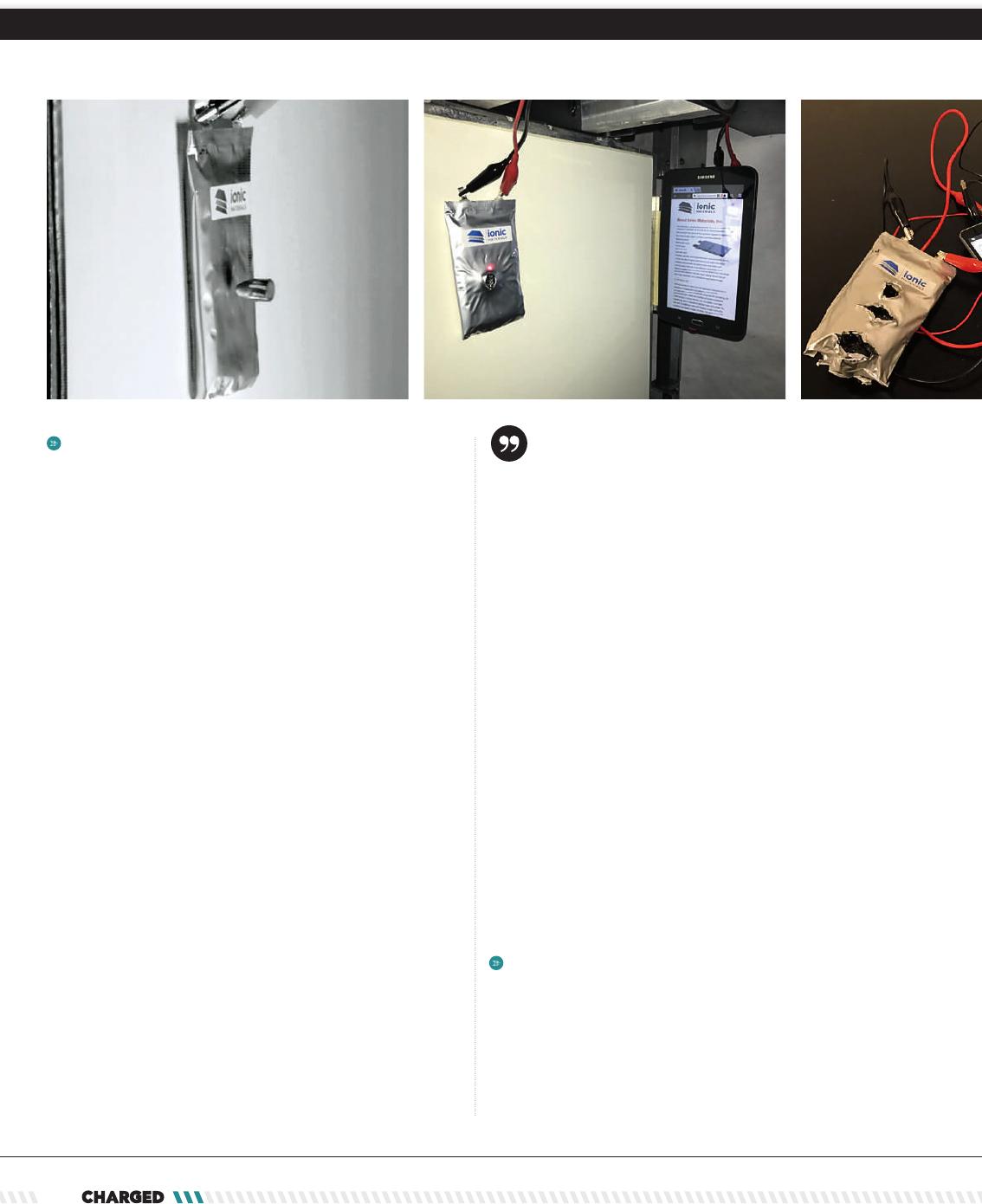
34
oxide. Although this substance can transfer ions, it suers
from two major drawbacks: it’s only conductive at high
temperatures, and it’s not compatible with high voltages.
“So I said, being a polymers person, it would be very
benecial if somebody could develop a polymer that
could be extruded, and used plastics processing technol-
ogy that could actually function appropriately at room
temperature. So I started working on a polymer electro-
lyte that could be as functional as a liquid electrolyte but
would solve a lot of the problems of a liquid electrolyte,
mostly safety and energy density.”
The solid solution
rough his eorts, Zimmerman managed to develop
a solid polymer which addressed the limitations of
polyethylene oxide - and opened the door to a better
type of battery.
“What I did as a polymer scientist was to come up
with a material which has a completely dierent conduc-
tion mechanism,” Zimmerman explains. “It doesn’t re-
The trouble with liquid electrolytes
“Since about 1990, the major rechargeable battery has
been a lithium-ion battery,” Zimmerman told Charged.
“And it had a liquid electrolyte. And I said to myself, you
probably couldn’t put together three worse materials:
reactive anode, cathode, and this very ammable liquid
electrolyte.”
By now, the hazards of liquid-electrolyte lithium-
ion batteries are pretty well known to the public. Even
though they’re ubiquitous in all sorts of devices, from
personal electronics to EVs, they do occasionally short-
circuit and catch re. In 2016, for example, smartphone
manufacturer Samsung was forced to recall 2.5 million
Galaxy Note 7 phones aer reports of res resulting
from manufacturing defects. A quick YouTube search
will also reveal video aer video of what happens if lith-
ium-ion batteries are punctured (spoiler alert: smoke,
smoldering, ames and the occasional rapid release of
gases - i.e. explosion).
One approach to this problem is to swap the am-
mable liquid electrolyte for something more durable: a
solid. And although this is the approach Zimmerman
took, he was not the rst to try it.
“ere’s been two classes of solids, ceramics and
glasses,” he explains. “And they all have their challenges.
One of the big challenges with both is to make them
thin and big. Ceramics are very brittle, so it’s hard to
scale them up. And you can imagine even putting glass
in an electrolyte is a dicult challenge.”
Zimmerman, with his background in polymer sci-
ence, saw the potential advantages of developing a solid
polymer electrolyte. Before he began his work, there was
only one such electrolyte: a polymer called polyethylene
It would be very beneficial if
somebody could develop a
polymer that could be extruded
and used plastics processing
technology that could actually
function appropriately at room
temperature.
Photos courtesy of Ionic Materials
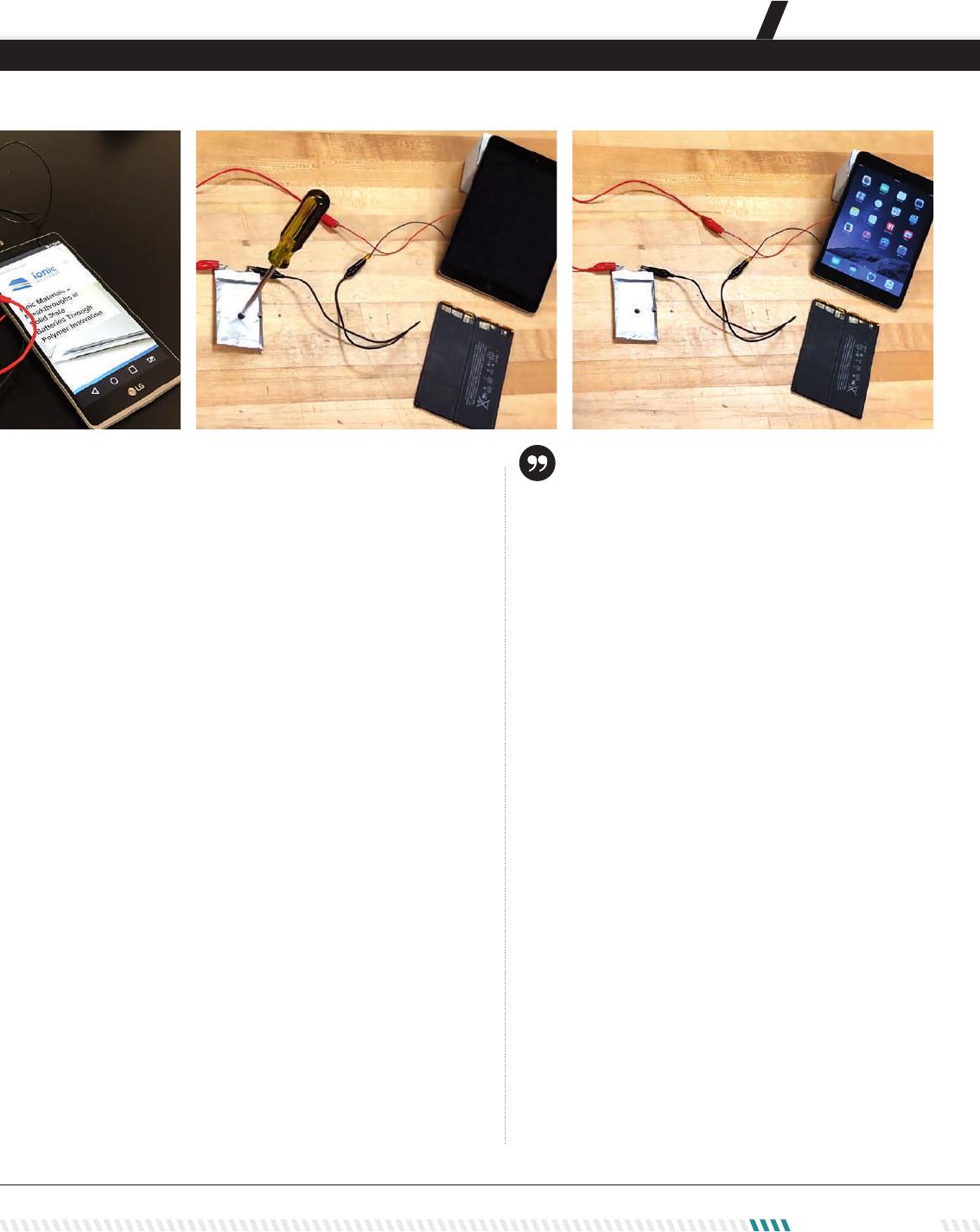
JAN/FEB 2018 35
is that we’re enabling electrodes made of lithium metal,
which has much higher energy density.” One of the
major challenges with lithium metal electrodes comes in
the form of dendrites, ngerlike projections of metal that
build up from one electrode, harming performance and
eventually creating a short circuit. Replacing liquid elec-
trolytes with an aordable and functioning solid creates
a physical barrier that will prevent dendrite formation.
A third benet of Ionic Materials’ approach is that it
has the potential to lower the cost of batteries. For one
thing, there are some cost savings that can be attained by
using plastics manufacturing and eliminating the liquid
electrolyte. For another, the new polymer can enable
certain alternatives to lithium-ion chemistries, such as
rechargeable alkaline, which uses cheaper electrodes
than lithium-based batteries do.
All of this has the potential to make a big impact in the
world of EVs, as Zimmerman points out.
“What’s going on is the automobile industry is really
in a push to turn cars from internal combustion to bat-
teries,” he says. “And in order to do that, they’re work-
ing on several things: range, cost, and safety. And our
polymer has a great chance to solve the range, the cost,
and the safety issues with traditional lithium-ion.”
quire movement of the chains. e conductivity at room
temperature is equivalent to that of a liquid electrolyte
with a separator. And the polymer is processable like in
roll-to-roll, so it’s highly manufacturable. at’s what
separates us from everybody else.”
In a conventional lithium-ion battery, two electrodes
- the anode and cathode - are on either side of a separa-
tor, which prevents a short circuit while allowing ion
transfer. e liquid electrolyte, which conducts the ions,
surrounds each electrode.
Zimmerman’s new material allows for a unique bat-
tery architecture. “We’re replacing both the separator
and liquid electrolyte with polymer,” he says. “So the
ionic polymer does two functions: it’s electrically insula-
tive, so it acts as the separator, and it’s ionically conduc-
tive, and acts as the electrolyte.”
is approach creates a completely solid-state lithium-
ion battery, which unlocks a number of benets. Chief
among them: safety.
“You can shoot bullets through a battery made with
our material and it won’t explode, it won’t burn, and it
still works aerwards,” claims Zimmerman. But don’t
take his word for it - you can actually go to the Ionic
Materials website and watch a video of exactly that. e
technology was also featured on a recent Nova docu-
mentary, Search for the Super Battery, in which you can
see Zimmerman’s battery get cut, stabbed, and burned
without giving o so much as a single spark (and while
remaining completely functional).
But the advantages don’t end there, according to Zim-
merman.
“People are trying to go to higher energy density an-
odes and cathodes,” he says. “And another major benet
You can shoot bullets through
a battery made with our
material and it won’t explode,
it won’t burn, and it still works
afterwards.
THE TECH
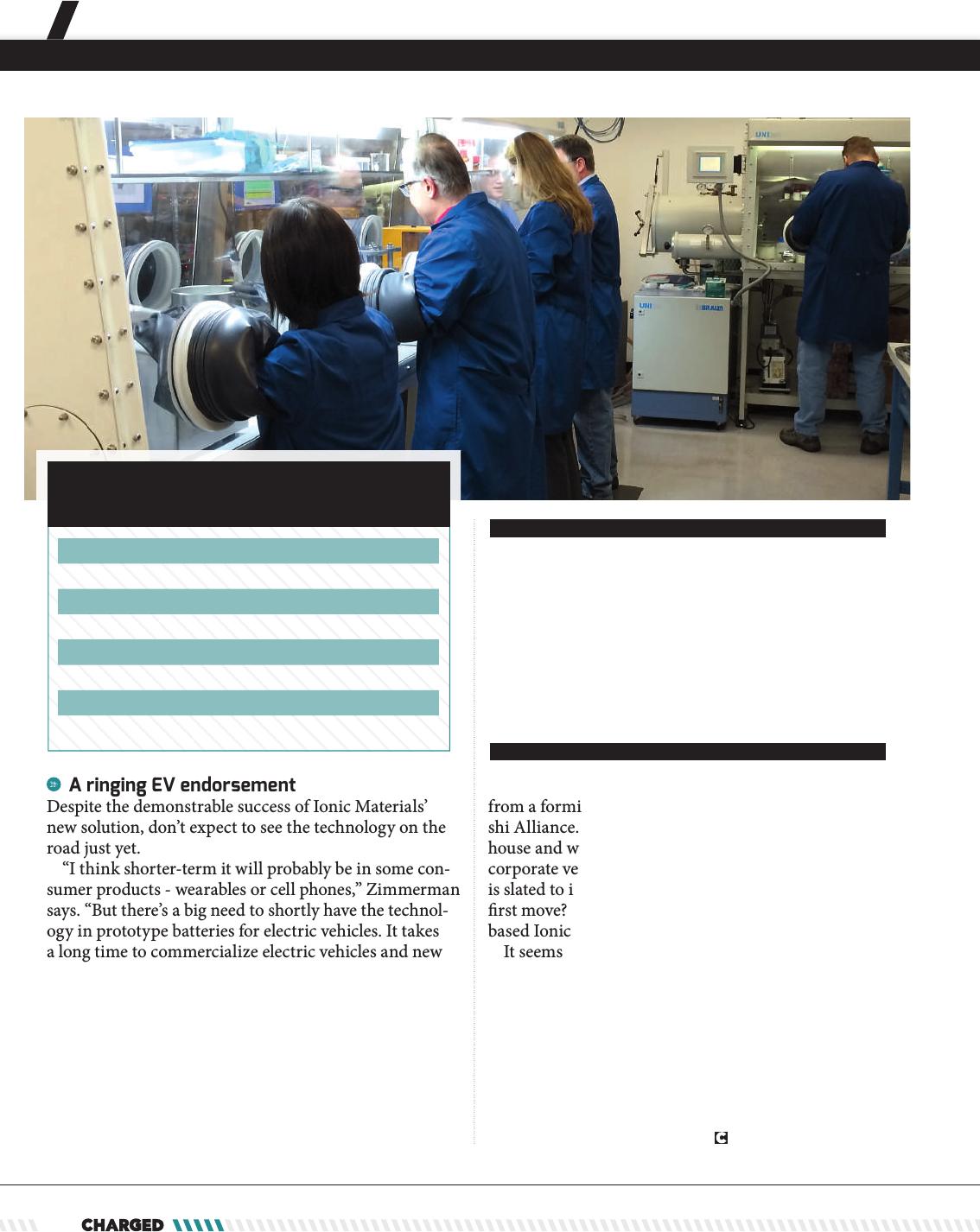
36
from a formidable source: the Renault-Nissan-Mitsubi-
shi Alliance. Earlier this year, the automotive power-
house and worldwide leader in EV sales launched a new
corporate venture capital fund, Alliance Ventures, which
is slated to invest up to $1 billion over ve years. Its very
rst move? To invest in none other than Massachusetts-
based Ionic Materials.
It seems that Zimmerman has got some big players in
his corner, even if he and his company still have a lot of
work to do. He explains that development for this type
of battery material is never really done. e next steps
include a lot of reliability testing and scaling-up eorts.
But as Zimmerman says, he isn’t one to back down from
a challenge.
“e technical hurdles Ionic proposes to overcome are
signicant, but such challenges we choose to accept, as
the world needs our solution.”
A ringing EV endorsement
Despite the demonstrable success of Ionic Materials’
new solution, don’t expect to see the technology on the
road just yet.
“I think shorter-term it will probably be in some con-
sumer products - wearables or cell phones,” Zimmerman
says. “But there’s a big need to shortly have the technol-
ogy in prototype batteries for electric vehicles. It takes
a long time to commercialize electric vehicles and new
batteries. We’re working with battery companies to pro-
vide initial prototypes in 2018, but there’s a long quali-
cation cycle before it actually gets into production.”
Ionic Materials does not plan to be a battery manufac-
turer itself, but rather to partner and license its technolo-
gies to the full-scale production experts. It’s currently
connecting with cell manufacturers and end users that
are interesting in using its technology.
e company recently got a boost in this endeavor
THE TECH
KEY PROPERTIES OF IONIC MATERIALS’ POLYMER
Up to 1.3 mS/cm at room temperature
Lithium transference number of 0.7
High voltage capability (5 volts)
Can accommodate high loadings in the cathode
High elastic modulus
Low cost precursors
Stable against lithium
Conducts multiple ions
Ionic Materials recently got a
boost from a formidable source,
it was the very first investment
of the Renault-Nissan-Mitsubishi
Alliance's new corporate
venture capital fund.
Photo courtesy of Ionic Materials
Be
4
Te
52
Te
52
Ra
88
Ba
56
Te
52
Te
52
Er
68
I
53
Es
99
Ac
89
C
6
Eu
63
Er
68
At
85
Er
68
Li
3
Dy
66
I
53
Sc
21
O
8
V
23
Er
68
Y
39
H
1
I
53
Ga
31
Th
90
Ra
88
O
8
H
1
U
92
Ga
31
H
1
Pu
94
Te
52
W I LDCA T ’ S C USTOM E R S
OUR CUSTOM E R S ’ MARKETS
W I LDCA T ’ S BUSINESS M O D E L
AUTOMOTIVE CONSUMER
ELECTRONICS
BATTERY
MANUFACTURERS
MILITARY
MATERIAL
SUPPLIERS
IDEA
OEMS
GRID STORAGE POWER TOOLS MEDICAL
W I LDCA T ’ S V ALU E
$
SYNTHESIS
COMMERCIALIZATION
SLURRY
TESTING
ANALYSIS
ELECTROLYTES
CELLS
1 experiment at
a time
+
–
+
–
+
–
+
–
+
–
+
–
• Faster time to market for new battery materials and cells
• Reduced research and development costs
• World-class scientific team
• Bulk synthesis and testing in actual batteries
• Immediate scale up capability for pilot studies
P R OJEC T TOPIC S
• High voltage cathodes
• High nickel cathodes
• Over-lithiated materials
• Olivines
• Solid-state electrolyte
• Conversion electrodes
• Electrode optimization
• High voltage electrolytes
• Reduced gas electrolytes
• Thermal stability electrolytes
• Silicon anodes
• Alloy anodes
• Lithium metal
• Primary battery materials
F AST :1-3YE ARS
S L O W: 5-10 Y E ARS
Conventional
Battery R&D
100s
of experiments
at a time
• Accelerated battery materials development
• Licensing of battery materials IP
Accel erating Battery Materials Development Worldwide
WWW.WI LDCA T D ISC O V E R Y.CO M
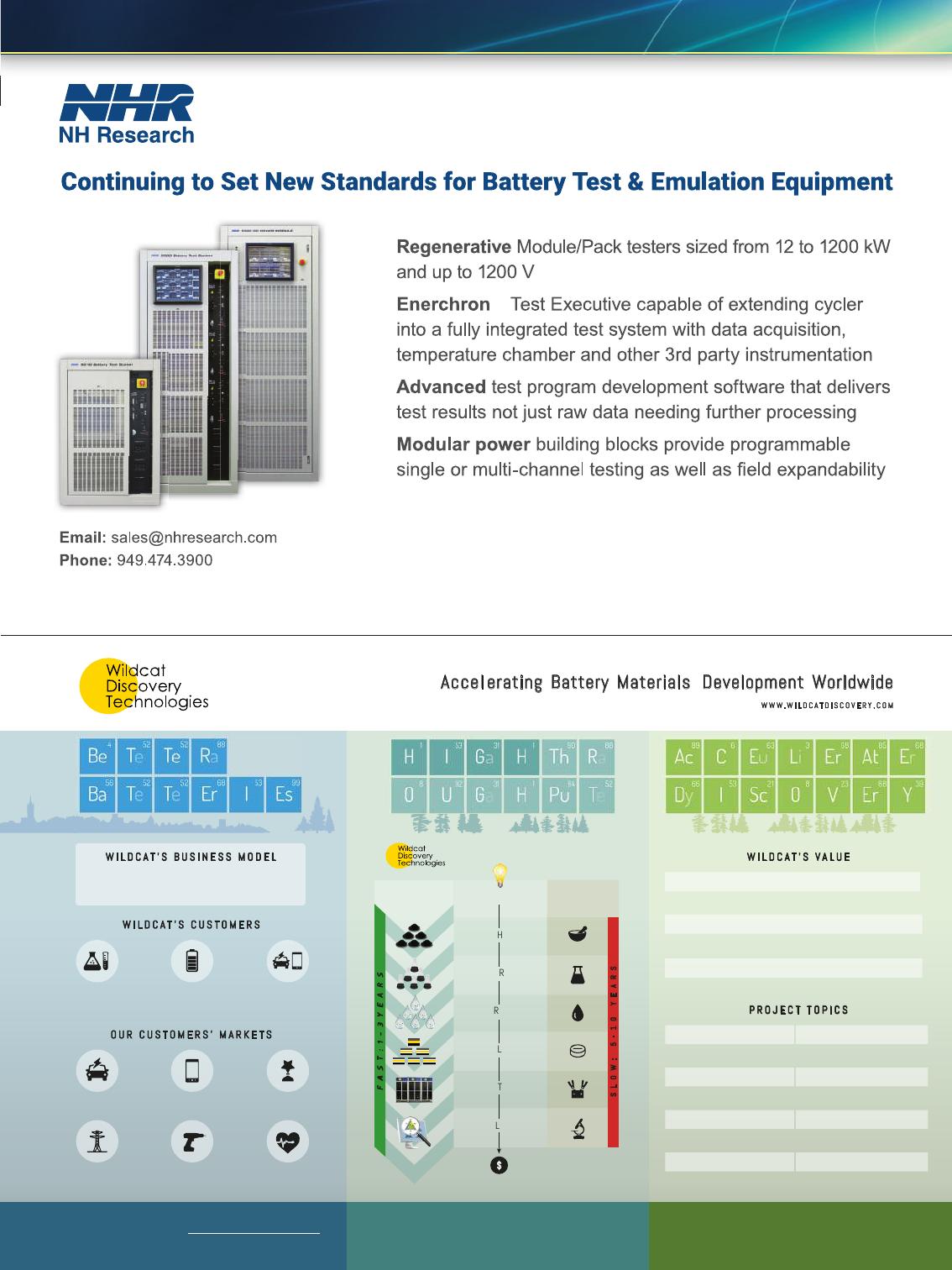
§
§
TM
§
§
Be
4
Te
52
Te
52
Ra
88
Ba
56
Te
52
Te
52
Er
68
I
53
Es
99
Ac
89
C
6
Eu
63
Er
68
At
85
Er
68
Li
3
Dy
66
I
53
Sc
21
O
8
V
23
Er
68
Y
39
H
1
I
53
Ga
31
Th
90
Ra
88
O
8
H
1
U
92
Ga
31
H
1
Pu
94
Te
52
W I LDCA T ’ S C USTOM E R S
OUR CUSTOM E R S ’ MARKETS
W I LDCA T ’ S BUSINESS M O D E L
AUTOMOTIVE CONSUMER
ELECTRONICS
BATTERY
MANUFACTURERS
MILITARY
MATERIAL
SUPPLIERS
IDEA
OEMS
GRID STORAGE POWER TOOLS MEDICAL
W I LDCA T ’ S V ALU E
$
SYNTHESIS
COMMERCIALIZATION
SLURRY
TESTING
ANALYSIS
ELECTROLYTES
CELLS
1 experiment at
a time
+
–
+
–
+
–
+
–
+
–
+
–
• Faster time to market for new battery materials and cells
• Reduced research and development costs
• World-class scientific team
• Bulk synthesis and testing in actual batteries
• Immediate scale up capability for pilot studies
P R OJEC T TOPIC S
• High voltage cathodes
• High nickel cathodes
• Over-lithiated materials
• Olivines
• Solid-state electrolyte
• Conversion electrodes
• Electrode optimization
• High voltage electrolytes
• Reduced gas electrolytes
• Thermal stability electrolytes
• Silicon anodes
• Alloy anodes
• Lithium metal
• Primary battery materials
F AST :1-3YE ARS
S L O W: 5-10 Y E ARS
Conventional
Battery R&D
100s
of experiments
at a time
• Accelerated battery materials development
• Licensing of battery materials IP
Accel erating Battery Materials Development Worldwide
WWW.WI LDCA T D ISC O V E R Y.CO M
Be
4
Te
52
Te
52
Ra
88
Ba
56
Te
52
Te
52
Er
68
I
53
Es
99
Ac
89
C
6
Eu
63
Er
68
At
85
Er
68
Li
3
Dy
66
I
53
Sc
21
O
8
V
23
Er
68
Y
39
H
1
I
53
Ga
31
Th
90
Ra
88
O
8
H
1
U
92
Ga
31
H
1
Pu
94
Te
52
W I LDCA T ’ S C USTOM E R S
OUR CUSTOM E R S ’ MARKETS
W I LDCA T ’ S BUSINESS M O D E L
AUTOMOTIVE CONSUMER
ELECTRONICS
BATTERY
MANUFACTURERS
MILITARY
MATERIAL
SUPPLIERS
IDEA
OEMS
GRID STORAGE POWER TOOLS MEDICAL
W I LDCA T ’ S V ALU E
$
SYNTHESIS
COMMERCIALIZATION
SLURRY
TESTING
ANALYSIS
ELECTROLYTES
CELLS
1 experiment at
a time
+
–
+
–
+
–
+
–
+
–
+
–
• Faster time to market for new battery materials and cells
• Reduced research and development costs
• World-class scientific team
• Bulk synthesis and testing in actual batteries
• Immediate scale up capability for pilot studies
P R OJEC T TOPIC S
• High voltage cathodes
• High nickel cathodes
• Over-lithiated materials
• Olivines
• Solid-state electrolyte
• Conversion electrodes
• Electrode optimization
• High voltage electrolytes
• Reduced gas electrolytes
• Thermal stability electrolytes
• Silicon anodes
• Alloy anodes
• Lithium metal
• Primary battery materials
F AST :1-3YE ARS
S L O W: 5-10 Y E ARS
Conventional
Battery R&D
100s
of experiments
at a time
• Accelerated battery materials development
• Licensing of battery materials IP
Accel erating Battery Materials Development Worldwide
WWW.WI LDCA T D ISC O V E R Y.CO M
Be
4
Te
52
Te
52
Ra
88
Ba
56
Te
52
Te
52
Er
68
I
53
Es
99
Ac
89
C
6
Eu
63
Er
68
At
85
Er
68
Li
3
Dy
66
I
53
Sc
21
O
8
V
23
Er
68
Y
39
H
1
I
53
Ga
31
Th
90
Ra
88
O
8
H
1
U
92
Ga
31
H
1
Pu
94
Te
52
W I LDCA T ’ S C USTOM E R S
OUR CUSTOM E R S ’ MARKETS
W I LDCA T ’ S BUSINESS M O D E L
AUTOMOTIVE CONSUMER
ELECTRONICS
BATTERY
MANUFACTURERS
MILITARY
MATERIAL
SUPPLIERS
IDEA
OEMS
GRID STORAGE POWER TOOLS MEDICAL
W I LDCA T ’ S V ALU E
$
SYNTHESIS
COMMERCIALIZATION
SLURRY
TESTING
ANALYSIS
ELECTROLYTES
CELLS
1 experiment at
a time
+
–
+
–
+
–
+
–
+
–
+
–
• Faster time to market for new battery materials and cells
• Reduced research and development costs
• World-class scientific team
• Bulk synthesis and testing in actual batteries
• Immediate scale up capability for pilot studies
P R OJEC T TOPIC S
• High voltage cathodes
• High nickel cathodes
• Over-lithiated materials
• Olivines
• Solid-state electrolyte
• Conversion electrodes
• Electrode optimization
• High voltage electrolytes
• Reduced gas electrolytes
• Thermal stability electrolytes
• Silicon anodes
• Alloy anodes
• Lithium metal
• Primary battery materials
F AST :1-3YE ARS
S L O W: 5-10 Y E ARS
Conventional
Battery R&D
100s
of experiments
at a time
• Accelerated battery materials development
• Licensing of battery materials IP
Accel erating Battery Materials Development Worldwide
WWW.WI LDCA T D ISC O V E R Y.CO M
Be
4
Te
52
Te
52
Ra
88
Ba
56
Te
52
Te
52
Er
68
I
53
Es
99
Ac
89
C
6
Eu
63
Er
68
At
85
Er
68
Li
3
Dy
66
I
53
Sc
21
O
8
V
23
Er
68
Y
39
H
1
I
53
Ga
31
Th
90
Ra
88
O
8
H
1
U
92
Ga
31
H
1
Pu
94
Te
52
W I LDCA T ’ S C USTOM E R S
OUR CUSTOM E R S ’ MARKETS
W I LDCA T ’ S BUSINESS M O D E L
AUTOMOTIVE CONSUMER
ELECTRONICS
BATTERY
MANUFACTURERS
MILITARY
MATERIAL
SUPPLIERS
IDEA
OEMS
GRID STORAGE POWER TOOLS MEDICAL
W I LDCA T ’ S V ALU E
$
SYNTHESIS
COMMERCIALIZATION
SLURRY
TESTING
ANALYSIS
ELECTROLYTES
CELLS
1 experiment at
a time
+
–
+
–
+
–
+
–
+
–
+
–
• Faster time to market for new battery materials and cells
• Reduced research and development costs
• World-class scientific team
• Bulk synthesis and testing in actual batteries
• Immediate scale up capability for pilot studies
P R OJEC T TOPIC S
• High voltage cathodes
• High nickel cathodes
• Over-lithiated materials
• Olivines
• Solid-state electrolyte
• Conversion electrodes
• Electrode optimization
• High voltage electrolytes
• Reduced gas electrolytes
• Thermal stability electrolytes
• Silicon anodes
• Alloy anodes
• Lithium metal
• Primary battery materials
F AST :1-3YE ARS
S L O W: 5-10 Y E ARS
Conventional
Battery R&D
100s
of experiments
at a time
• Accelerated battery materials development
• Licensing of battery materials IP
Accel erating Battery Materials Development Worldwide
WWW.WI LDCA T D ISC O V E R Y.CO M
Be
4
Te
52
Te
52
Ra
88
Ba
56
Te
52
Te
52
Er
68
I
53
Es
99
Ac
89
C
6
Eu
63
Er
68
At
85
Er
68
Li
3
Dy
66
I
53
Sc
21
O
8
V
23
Er
68
Y
39
H
1
I
53
Ga
31
Th
90
Ra
88
O
8
H
1
U
92
Ga
31
H
1
Pu
94
Te
52
W I LDCA T ’ S C USTOM E R S
OUR CUSTOM E R S ’ MARKETS
W I LDCA T ’ S BUSINESS M O D E L
AUTOMOTIVE CONSUMER
ELECTRONICS
BATTERY
MANUFACTURERS
MILITARY
MATERIAL
SUPPLIERS
IDEA
OEMS
GRID STORAGE POWER TOOLS MEDICAL
W I LDCA T ’ S V ALU E
$
SYNTHESIS
COMMERCIALIZATION
SLURRY
TESTING
ANALYSIS
ELECTROLYTES
CELLS
1 experiment at
a time
+
–
+
–
+
–
+
–
+
–
+
–
• Faster time to market for new battery materials and cells
• Reduced research and development costs
• World-class scientific team
• Bulk synthesis and testing in actual batteries
• Immediate scale up capability for pilot studies
P R OJEC T TOPIC S
• High voltage cathodes
• High nickel cathodes
• Over-lithiated materials
• Olivines
• Solid-state electrolyte
• Conversion electrodes
• Electrode optimization
• High voltage electrolytes
• Reduced gas electrolytes
• Thermal stability electrolytes
• Silicon anodes
• Alloy anodes
• Lithium metal
• Primary battery materials
F AST :1-3YE ARS
S L O W: 5-10 Y E ARS
Conventional
Battery R&D
100s
of experiments
at a time
• Accelerated battery materials development
• Licensing of battery materials IP
Accel erating Battery Materials Development Worldwide
WWW.WI LDCA T D ISC O V E R Y.CO M
Come visit Wildcat’s new expanded facility
in June 2018 during AABC in San Diego!
Visit us at the 2018 Int’l Battery Seminar
in Ft. Lauderdale, Booth #417
San Diego, CA USA +1 (858) 550-1980
www.wildcatdiscovery.com
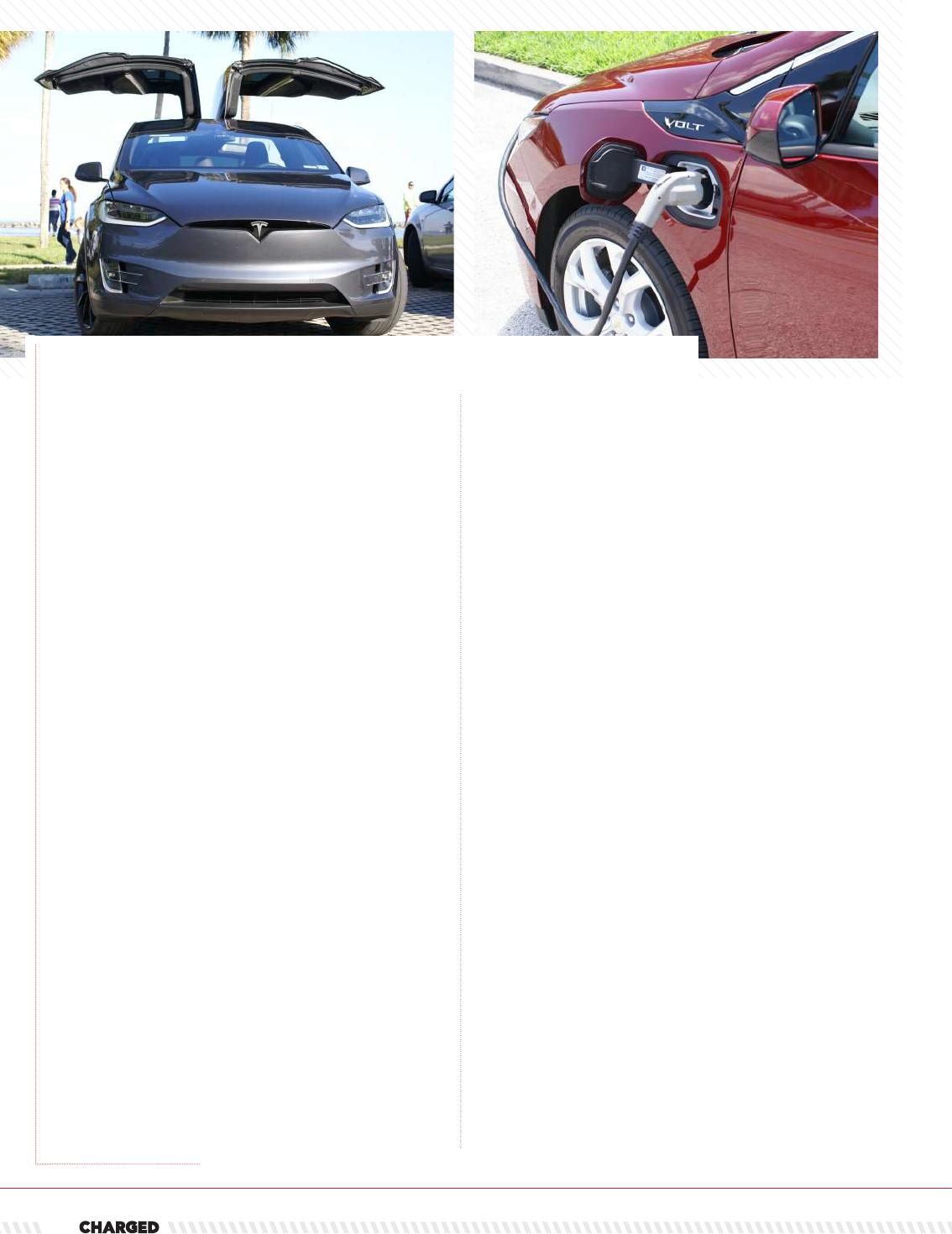
38
2017 plug-in sales up 26%, Tesla and Chevy on top
guidance by delivering 101,312 Model S and X vehicles
in 2017. is was a 33% increase over 2016.”
ese are global gures - according to InsideEVs’
estimates, US Model S and X sales grew by about 3% in
2017.
ere’s also good news on Model 3 deliveries, which
tripled in December. “During Q4, we made major prog-
ress addressing Model 3 production bottlenecks, with
our production rate increasing signicantly towards the
end of the quarter,” says Tesla. “As we continue to focus
on quality and eciency rather than simply pushing
for the highest possible volume in the shortest period
of time, we expect to have a slightly more gradual ramp
through Q1, likely ending the quarter at a weekly rate of
about 2,500 Model 3 vehicles. We intend to achieve the
5,000 per week milestone by the end of Q2.”
e importance of an automaker meeting its projected
sales numbers is debatable - most of us who follow Tesla
long ago accepted the fact that its forecasts are aspira-
tional rather than realistic, and some even argue that
that’s a good thing. What is not in dispute is that Tesla’s
deliveries, of all three vehicles, are steadily growing.
Another heartwarming Christmas tale was represent-
ed by the Chevy Bolt. e sales numbers alone make it
clear that this is no compliance car. Even more suggestive
is the fact that GM has been running a few national,
mass-media ads, a historic rst for any plug-in model.
Reports in mid-2017 that the company planned a sub-
stantial increase in production seem to have been mere
rumors, but there are several reasons to expect steadily
growing Bolt sales in 2018.
Other interesting stories include BMW, which saw
overall increases in November and December, even
though sales of its groundbreaking i3 are stagnant; and
Honda, whose Clarity BEV and PHEV each entered the
market with very respectable sales.
Plug-in sales have failed…to reach the milestone of
200,000 units. Total US sales for 2017 were 199,826
(according to InsideEVs), a 26% increase compared to
2016’s 158,614. Worldwide sales were well over a million.
December saw the biggest US monthly sales in history,
and was the 27th consecutive month that sales were
greater than the previous year.
Tesla leads the pack by a large margin - Model S was
the best-selling plug-in of the year (as it was in 2016 and
2015), with just over 27,000 sales (InsideEVs’ estimate),
and Model X was in third place with just over 21,000.
e Chevrolet Bolt had a stellar rst year on the mar-
ket, coming in second in US sales with 23,297. So did
the Toyota Prius Prime, which earned fourth place with
20,936 US sales.
Chevy’s plug-in hybrid Volt is still a contender, in h
place with 20,349 sales, a modest reduction from 2016.
Long-time champion the Nissan LEAF eked out a sixth-
place nish at 11,230 - monthly sales have dwindled to
almost nothing as the company prepares to deliver the
new, redesigned 2018 LEAF in January.
So much for the gures - now, what’s the story? ere
are several, and one of the happy ones is Tesla. You
wouldn’t know it from reading the mainstream press,
which is obsessed with the fact that Model 3 deliver-
ies have fallen short of Tesla’s wildly overoptimistic
forecasts, but Tesla set a new sales record in the fourth
quarter of 2017.
Tesla reported in a press release: “In Q4, Tesla deliv-
ered 29,870 vehicles, of which 15,200 were Model S,
13,120 were Model X, and 1,550 were Model 3. is was
once again our all-time best quarter for combined Model
S and X deliveries, representing a 27% increase over Q4
2016, and a 9% increase over Q3 2017, our previous best
quarter.
“In total, we exceeded our previously announced
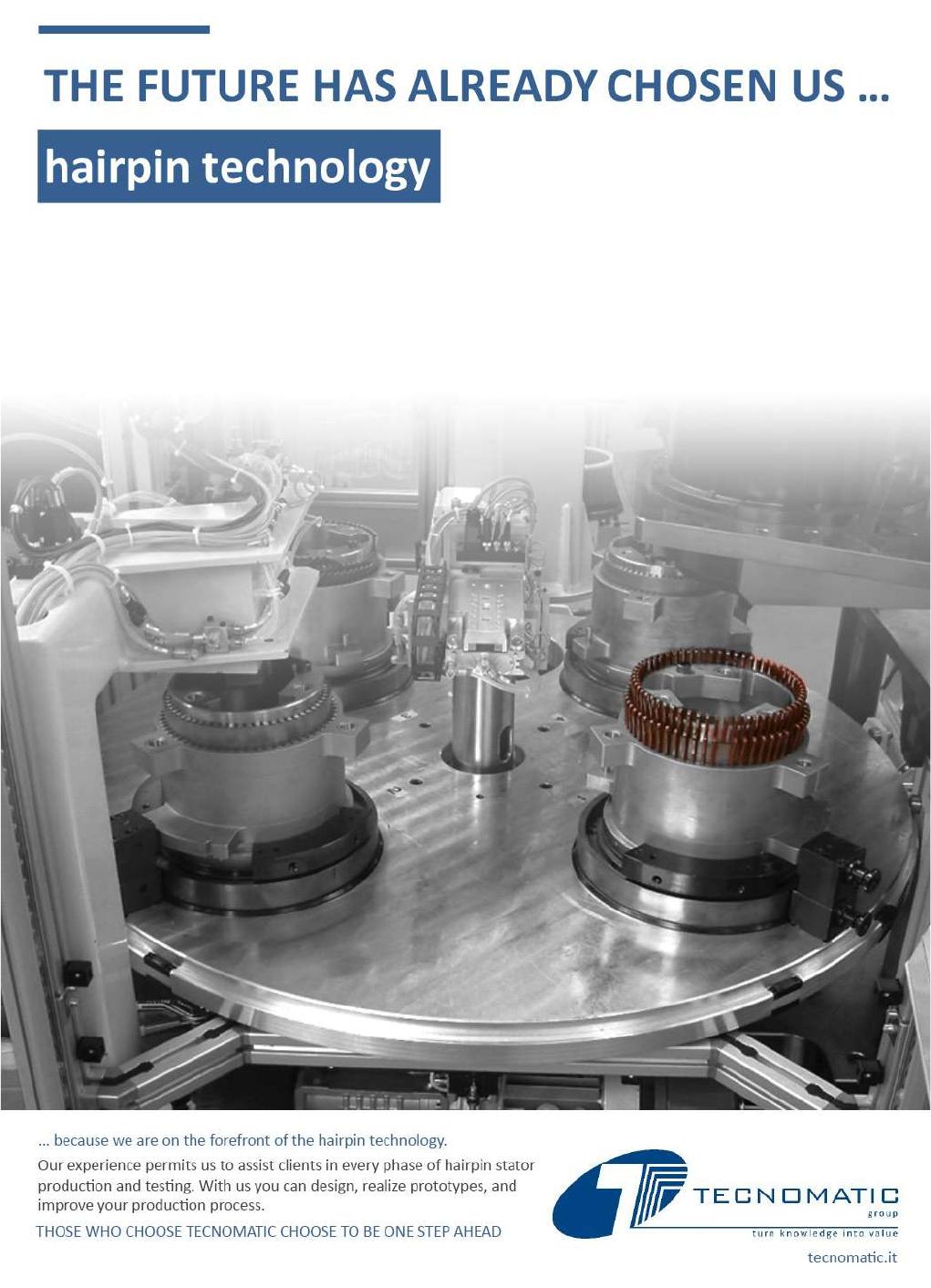
Run
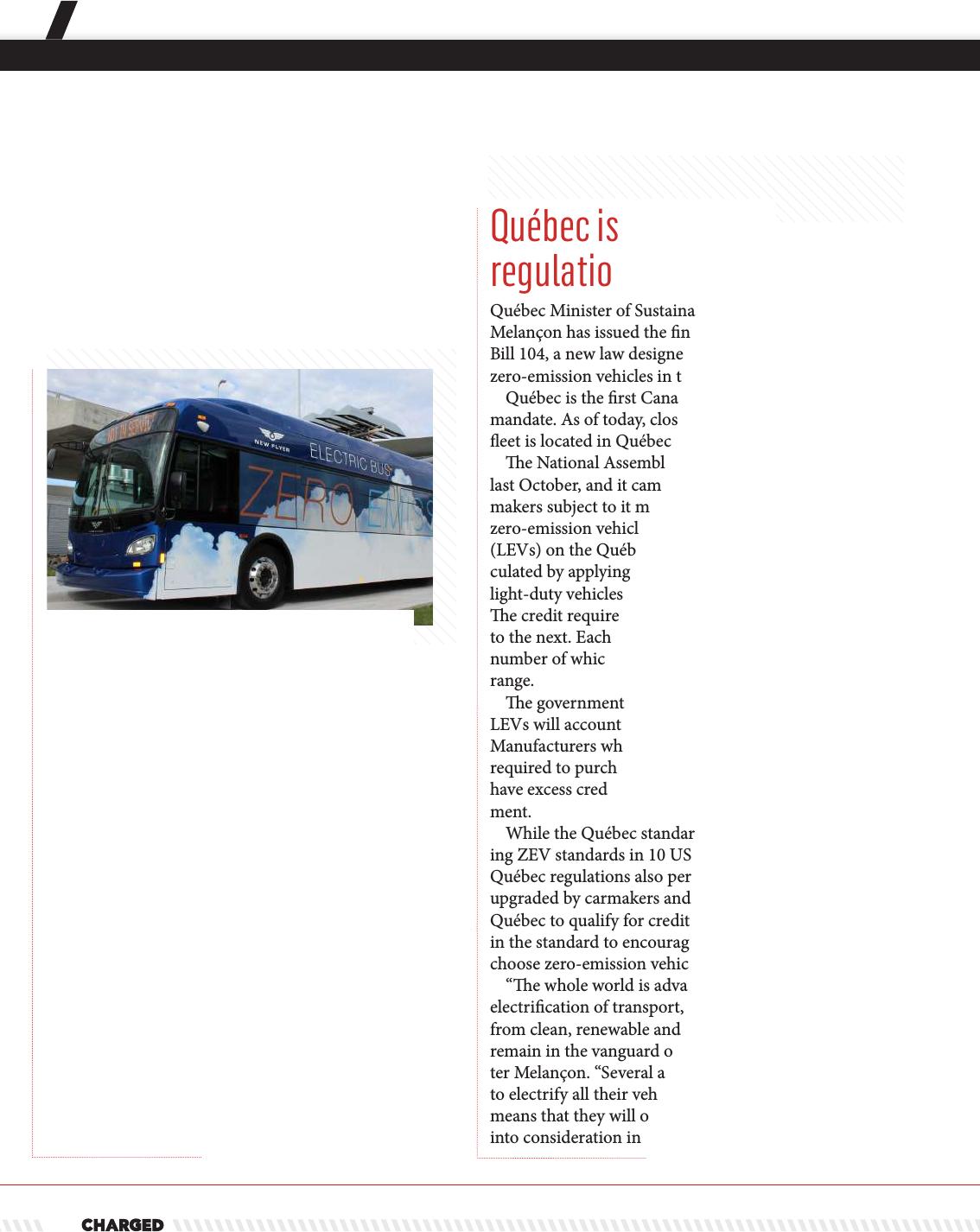
40
THE VEHICLES
Québec Minister of Sustainable Development Isabelle
Melançon has issued the nal regulations in support of
Bill 104, a new law designed to increase the number of
zero-emission vehicles in the province.
Québec is the rst Canadian province to adopt a ZEV
mandate. As of today, close to half the Canadian ZEV
eet is located in Québec.
e National Assembly unanimously adopted the Act
last October, and it came into force this month. e auto-
makers subject to it must accumulate credits by selling
zero-emission vehicles (ZEVs) or low-emission vehicles
(LEVs) on the Québec market. e credit target is cal-
culated by applying a percentage to the total number of
light-duty vehicles that each automaker sells in Québec.
e credit requirement thus varies from one automaker
to the next. Each sale or lease of a ZEV earns credits, the
number of which varies according to the vehicle’s electric
range.
e government anticipates that by 2025, ZEV and
LEVs will account for approximately 10% of the market.
Manufacturers which do not achieve their targets will be
required to purchase credits from other automakers that
have excess credits available, or pay a fee to the govern-
ment.
While the Québec standard largely follows the exist-
ing ZEV standards in 10 US states, one dierence is that
Québec regulations also permit vehicles that have been
upgraded by carmakers and licensed for the rst time in
Québec to qualify for credits. is measure was included
in the standard to encourage low-income households to
choose zero-emission vehicles.
“e whole world is advancing in the eld of the
electrication of transport, and Québec, which benets
from clean, renewable and abundant energy, needs to
remain in the vanguard of this movement,” said Minis-
ter Melançon. “Several automakers have shown the will
to electrify all their vehicle models. e ZEV standard
means that they will of necessity take the Québec market
into consideration in their marketing plans.”
Québec issues final
regulations for ZEV mandate
As transit agencies around the country are going electric,
North America’s largest bus manufacturer is gearing up
for the new market. New Flyer’s (TSX: NFI) Anniston,
Alabama facility has successfully completed its rst full
build of an Xcelsior Charge battery-electric transit bus.
All New Flyer manufacturing locations, including
Winnipeg, Manitoba, and Crookston and St. Cloud,
Minnesota, are now capable of building the Xcelsior
Charge. New Flyer’s Anniston facility is also home to the
new Vehicle Innovation Center, which is dedicated to
advancing bus and coach technology, specically electric
and autonomous powertrains.
“Over the past two years, we invested signicantly to
establish Anniston as a leader in American bus manufac-
turing and advanced vehicle innovation,” said Senior VP
Kevin Wood. “We are proud to bring electrication into
the fold, and look forward to growing our footprint of
zero-emission, innovative transportation.”
All New Flyer facilities now
capable of manufacturing
battery-electric buses
Photo courtesy of New Flyer
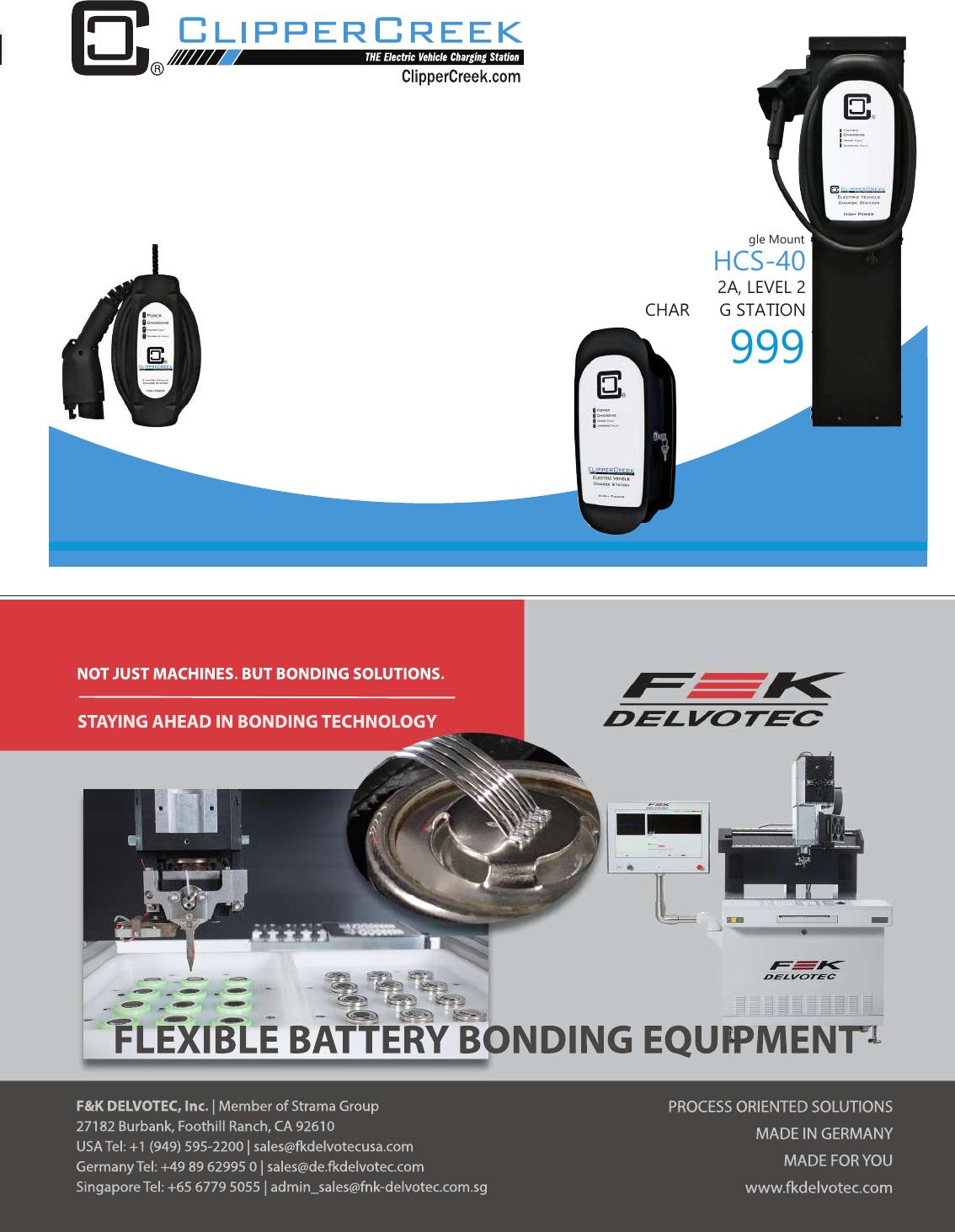
ProMountDuo
TM
Universal Pedestal
Introducing the
ClipperCreek, Inc.
RELIABLE
POWERFUL
MADE IN AMERICA
LEARN MORE CALL (877) 694-4194
LEVEL 2
240 Volt
CHARGING STATION
Starting at
$379
LCS-20 shown
HCS-40
32A, LEVEL 2
CHARGING STATION
$999
Single Mount
RUGGED, ECONOMICAL
Accommodates two stations with no additional hardware necessary
ChargeGuard
TM
HCS key
option
$
78
additional
????
Run
PROCESS ORIENTED SOLUTIONS
MADE IN GERMANY
MADE FOR YOU
www.fkdelvotec.com
F&K DELVOTEC, Inc. | Member of Strama Group
27182 Burbank, Foothill Ranch, CA 92610
USA Tel: +1 (949) 595-2200 | sales@fkdelvotecusa.com
Germany Tel: +49 89 62995 0 | sales@de.fkdelvotec.com
Singapore Tel: +65 6779 5055 | admin_sales@fnk-delvotec.com.sg
STAYING AHEAD IN BONDING TECHNOLOGY
NOT JUST MACHINES. BUT BONDING SOLUTIONS.
FLEXIBLE BATTERY BONDING EQUIPMENT

42
WABCO Holdings (NYSE: WBC), a global supplier of
technologies and services for commercial vehicles, has
made a $10-million strategic investment in Nikola Motor
Company, developer of a Class 8 hydrogen fuel cell
truck.
e two companies also agreed to work together to
develop safety technologies specically designed for elec-
tric commercial vehicles, including electronic braking
systems and traction and stability control technologies.
“As vehicles become increasingly autonomous, electric
and connected, WABCO continues to be at the forefront
of breakthrough technology innovation,” said WABCO
CEO Jacques Esculier. “WABCO’s technologies, notably
industry-leading braking, traction and stability control
systems, continue to advance the transportation indus-
t r y.”
“WABCO is a vital business partner to enable auton-
omous driving, electronic braking, and stability control
for trucks and trailers,” said Nikola founder and CEO
Trevor Milton. “WABCO is recognized as a global leader
in safety and eciency technologies for next-generation
commercial vehicles.”
Nikola plans to begin testing its trucks with commer-
cial eets in late 2018, and launch full production in
2021.
Fuel cell truck maker Nikola
gets investment from safety
specialist WABCO
Electric buses are in service in many North American
and European cities, notably London, which has com-
mitted to eliminating pure diesel (non-hybrid) buses,
and Los Angeles, which plans to make its eet emis-
sions-free by 2030. 12 major cities have pledged to buy
only all-electric buses starting in 2025.
However, these eorts pale in comparison to what’s go-
ing on in Shenzhen. e Chinese megacity of 12 million,
which has been adding electric buses to its eet for years,
has now announced that it has completely electried its
eet, with some 16,359 e-buses in operation.
e city has built 8,000 charge points at 510 bus
charging stations, and can charge roughly half the eet at
any given time. e electric buses are saving an estimat-
ed 345,000 tons of fuel per year, and 1.35 million tons of
carbon dioxide emissions.
Shenzhen also has a plan in place to update its taxi
eet to EVs. A reported 63 percent of the city’s 12,000
taxis already run on electricity.
“We will gradually replace the existing fuel-powered
cabs with electricity-powered ones and complete the
target by 2020, or even ahead of schedule,” said Zheng
Jingyu, head of Shenzhen’s public transport department.
Shenzhen goes fully electric
with over 16,000 electric
buses
Photo courtesy of BYD
THE VEHICLES
Photos courtesy of Nikola
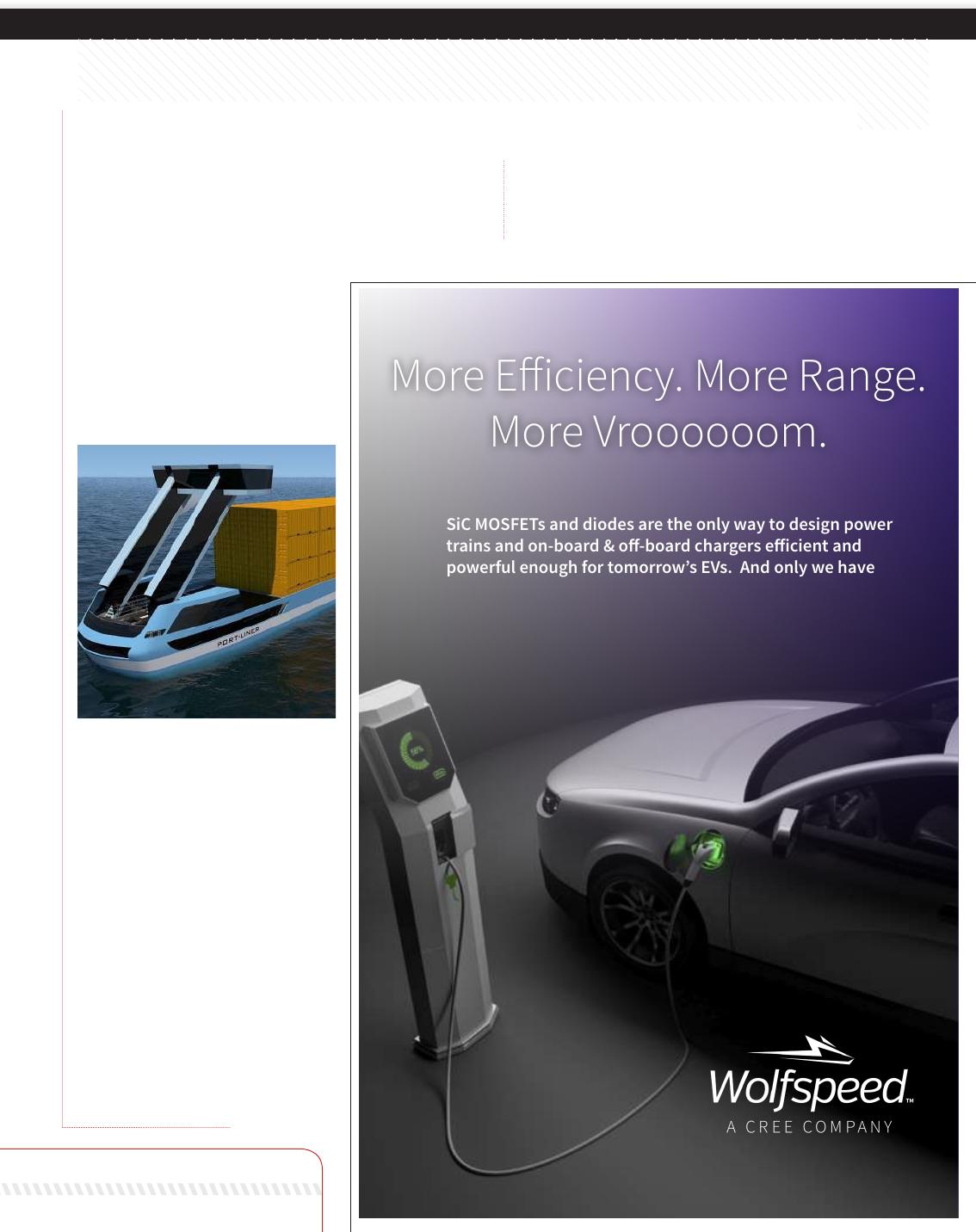
More Eiciency. More Range.
More Vroooooom.
SiC MOSFETs and diodes are the only way to design power
trains and on-board & o-board chargers eicient and
powerful enough for tomorrow’s EVs. And only we have
been singularly focused on driving SiC device technology
forward for nearly 30 years.
wolfspeed.com/power
Dutch manufacturer Port Liner has developed what it
says are the world’s rst fully electric, and potentially
crewless, container barges, which are to begin operating
from the ports of Antwerp, Amsterdam, and Rotterdam
this summer.
e vessels, designed to t
beneath bridges as they transport
goods around the inland water-
ways of Belgium and the Neth-
erlands, are expected to vastly
reduce the use of diesel-powered
trucks for moving freight.
of providing 35 hours of autonomous operation.
According to Eurostat, 75% of freight in the EU is
transported by road, 18.4% by rail, and 6.7% along in-
land waterways, and the use of water routes is on the rise.
Electric container barges to sail from Europe this summer
e barges are designed to op-
erate without any crew, although
the vessels will be manned at rst.
eir electric motors will be driv-
en by 20-foot batteries, oering
15 hours of power, and will be
charged on shore by the car-
bon-free energy provider Eneco.
In August, ve 52-meter barges,
each able to carry 24 20-foot
containers, will begin operations.
According to Port Liner, the lack
of an engine room results in up to
8% extra space.
Later, six 110-meter barges,
each carrying 270 containers, will
run on four battery boxes capable
Photos courtesy of e Loadstar
????
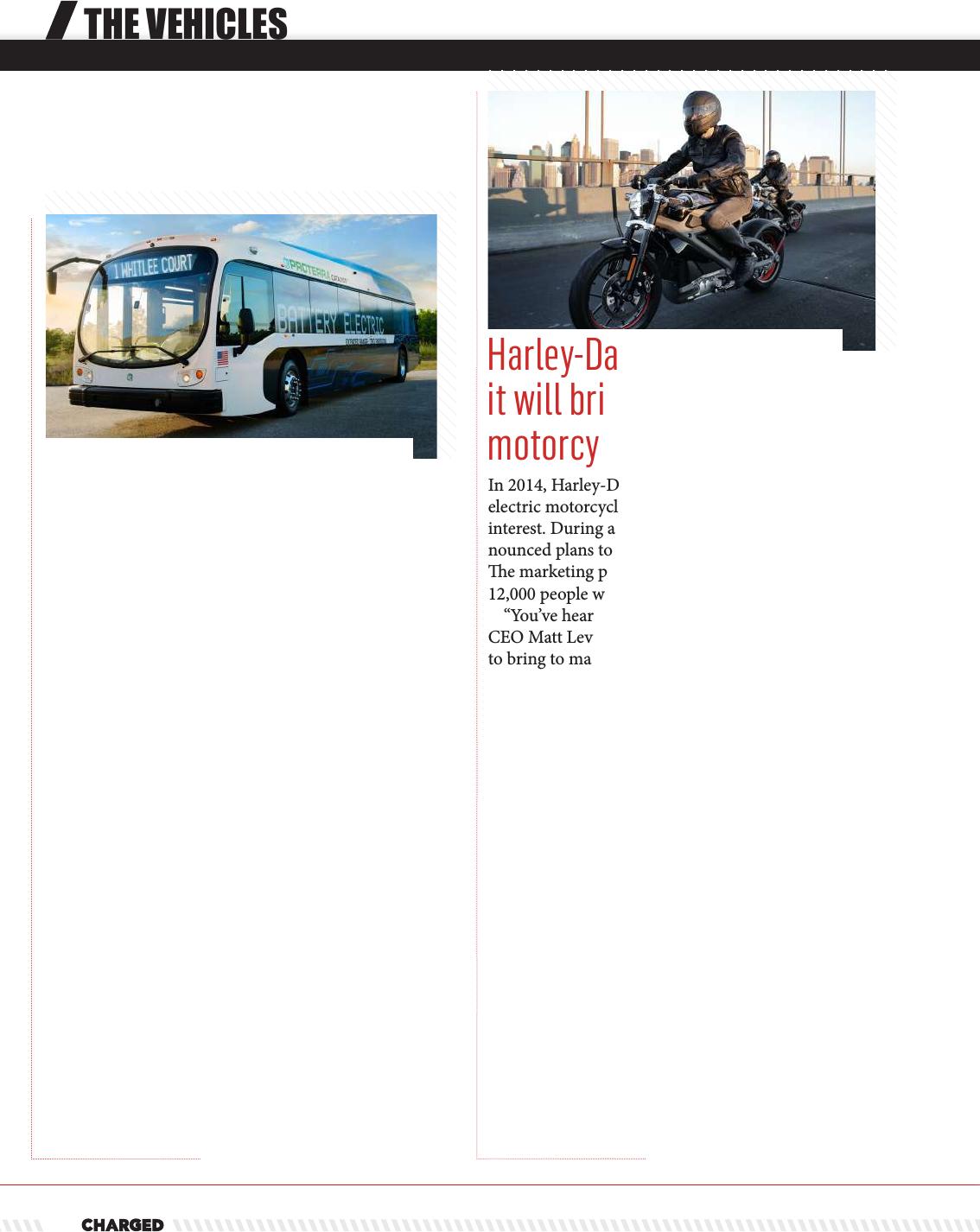
44
THE VEHICLES
In 2014, Harley-Davidson took its LiveWire prototype
electric motorcycle on a road trip to gauge consumer
interest. During a recent earnings call, the company an-
nounced plans to bring an electric motorcycle to market.
e marketing plan will be based on research from the
12,000 people who rode the LiveWire.
“You’ve heard us talk about Project LiveWire,” said
CEO Matt Levatich. “It’s an active project we’re preparing
to bring to market within 18 months. e EV motorcycle
market is in its infancy today, but we believe premium
Harley-Davidson electric motorcycles will help drive
excitement and participation in the sport globally.”
CFO John Olin said Harley aims to be the world leader
in the electric motorcycle market, and will invest $25
million to $50 million per year in electrication technol-
ogy over the next several years.
However, the company’s recent earnings report also
brought bad news: Harley sales fell 11 percent in the
fourth quarter and 8.5 percent for the year. e company
plans job cuts and a plant closure.
US demand for motorcycles in general is falling -
industry retail sales were down 6.5 percent in the fourth
quarter of 2017. Electric motorcycles represent a small
but growing segment. In a 2016 report, market research
rm TechNavio projected 45% growth in the e-cycle
market by 2020.
“e universal appeal of [LiveWire]…gave us a lot of
condence that electric motorcycles have broad-based
appeal,” said Levatich. “ey are going to sit alongside
existing Harleys in garages as much as they’re going to
create new interest in the sport.”
Harley-Davidson confirms
it will bring electric
motorcycle to market
e Los Angeles County Metropolitan Transportation
Authority (LA Metro) has committed to fully electrifying
its eet of 2,200 buses by 2030 - in August it agreed to
buy 95 electric buses from New Flyer and BYD.
Now the Los Angeles Department of Transportation
(LADOT), which operates a eet of 359 buses, has made
the same commitment, and has ordered 25 35-foot
Proterra Catalyst electric buses, to be delivered in 2019.
e procurement will be funded in part by the Federal
Transit Administration’s Low or No Emission Vehicle
Deployment Grants.
e new buses will deliver anticipated cost savings of
$11.2 million over their 12-year lifetime.
“Our goal is a 100 percent electric bus eet - it’s a quiet
ride for our customers and cleaner air for our city,” said
Seleta Reynolds, LADOT’s General Manager. “We know
we can’t achieve our vision without partners like Proter-
ra, and we can’t wait to see these buses on the street!”
Southern California is served by a patchwork of trans-
portation agencies, and most of these, including Foothill
Transit and Antelope Valley Transit Authority, have an-
nounced plans to convert their vehicles to battery-elec-
tric buses.
“Los Angeles County is home to our manufacturing
facility in the City of Industry, where we manufacture the
Catalyst electric buses, so it is tting that our buses will
be deployed in nearby regions,” said Ryan Popple, CEO
of Proterra.
Los Angeles DOT orders 25
Proterra e-buses
Photo courtesy of Proterra
Photo courtesy of Harley-Davidson
Charlie Proofed
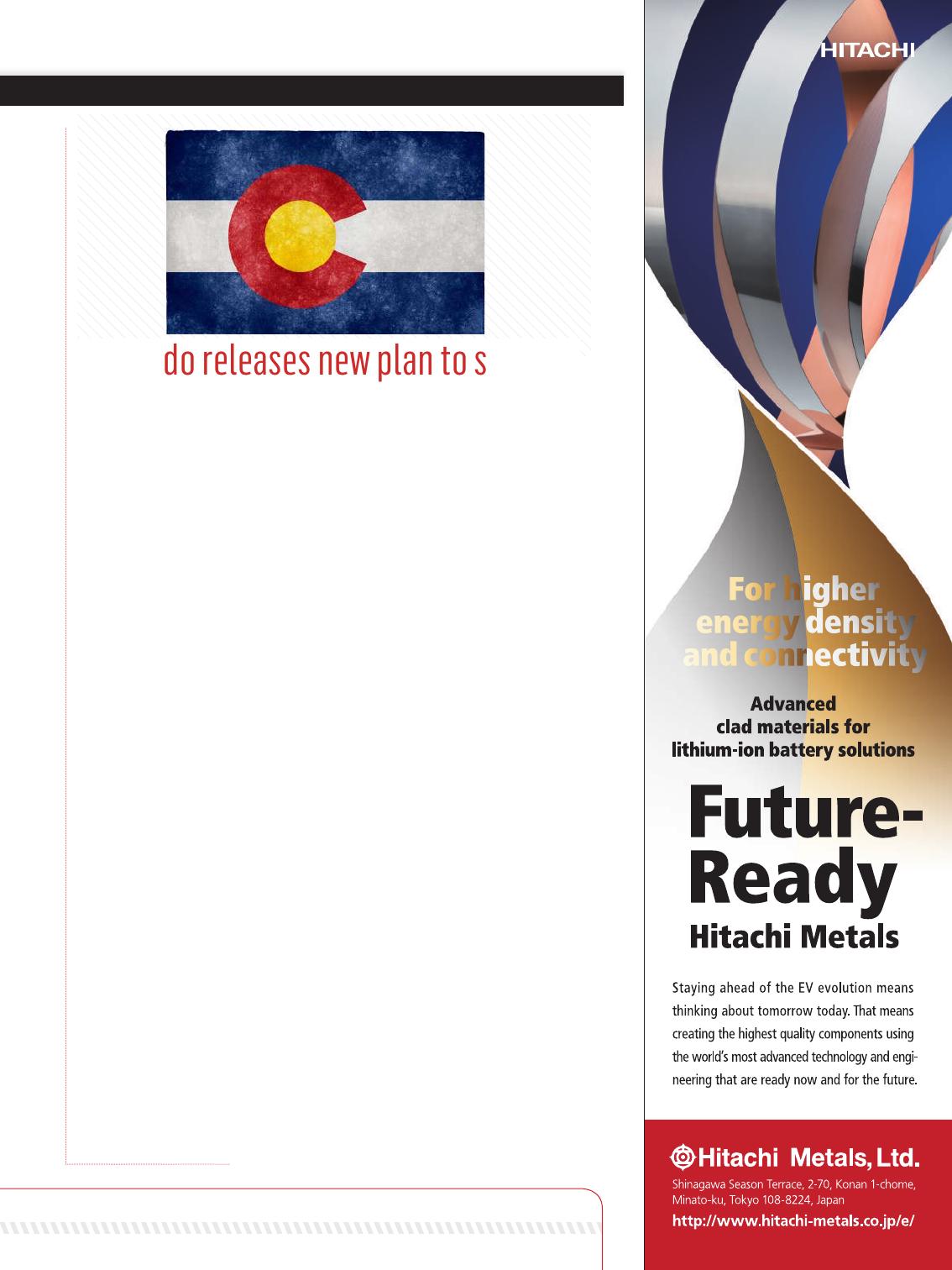
Image courtesy of Nicolas Raymond
Colorado Governor John Hickenlooper has released the Colorado Electric
Vehicle (EV) Plan, which details a series of actions supporting EV infra-
structure, and lays out goals to accelerate adoption of EVs.
Colorado currently ranks 8th in the US in EV market share, and 7th for
number of EVs per capita. As of October 2017, there were almost 12,000
plug-in vehicles in Colorado - over the rst eight months of the year, sales
were up 73%.
Despite the recent growth, lack of public charging, particularly fast
charging along major transportation corridors, remains a major barrier to
greater adoption. In a survey of current and potential EV drivers, respon-
dents indicated that there are numerous locations in Colorado they are less
likely to travel to due to a lack of charging, and half the respondents cited
lack of charging availability as a signicant factor in the decision not to
purchase an EV.
e Colorado Electric Vehicle Plan has ve key action areas:
• Create strategies and partnerships to build out EV fast charging corri-
dors.
• Coordinate with Regional Electric Vehicle West memorandum of un-
derstanding states on Intermountain electric corridor.
• Develop strategic partnerships with utilities, local governments, and
other stakeholders.
• Update signage and waynding requirements to include EV fast
charging.
• Ensure economic and tourism benets and increase access for all Col-
oradans.
“e Colorado EV Plan serves as a roadmap to build out a fast charging
network, giving Coloradans the ability to travel anywhere in the state in an
EV,” said Governor John Hickenlooper. “e plan includes a set of goals and
strategies that ensure Colorado continues leading in adoption of EVs and
leverages the economic development and tourism benets.”
Colorado releases new plan to support
EV infrastructure and accelerate EV
adoption
cm4
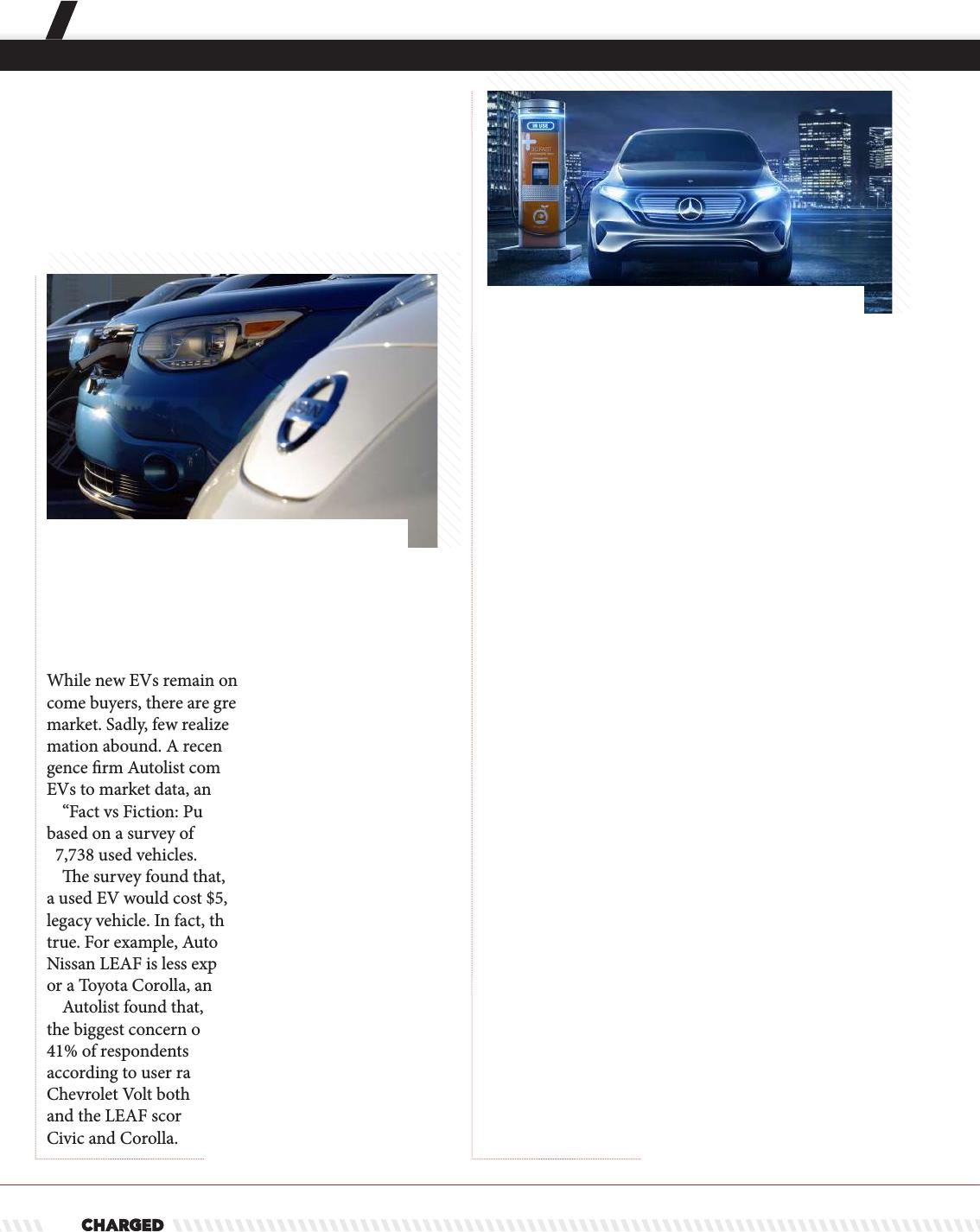
46
THE VEHICLES
While new EVs remain on the pricey side for lower-in-
come buyers, there are great values available on the used
market. Sadly, few realize this, and myths and misinfor-
mation abound. A recent study from the buyer intelli-
gence rm Autolist compared buyer perceptions of used
EVs to market data, and found a major disconnect.
“Fact vs Fiction: Public Perception of Used EVs” is
based on a survey of 1,249 vehicle owners and data on
17,738 used vehicles.
e survey found that, on average, buyers thought
a used EV would cost $5,000 more than an equivalent
legacy vehicle. In fact, the opposite is more likely to be
true. For example, Autolist found that a typical used 2015
Nissan LEAF is less expensive than either a Honda Civic
or a Toyota Corolla, and has lower mileage.
Autolist found that, aer vehicle range, reliability is
the biggest concern of prospective plug-in buyers, with
41% of respondents citing it as their top worry. In fact,
according to user ratings, the 2015 Nissan LEAF and
Chevrolet Volt both have better than average reliability,
and the LEAF scores better than the famously reliable
Civic and Corolla.
User survey shows buyers
misunderstand the used EV
market
Photo courtesy of Mercedes-Benz
Mercedes-Benz is in the process of building out hubs for
the production of EVs and batteries around the globe,
and plans to build its EVs in six plants on three conti-
nents.
By 2022, Daimler plans to have at least one electried
option in every Mercedes model series. e company
will oer more than 50 electried vehicle variants in all
segments, from smart cars to large SUVs, including at
least 10 fully electric models.
e company plans to invest €10 billion ($12.5 billion)
in the expansion of its electried eet and an additional
€1 billion ($1.25 billion) in a global battery production
network.
e smart fortwo coupe and cabrio are already being
produced at the company’s plant in Hambach, France.
In 2018, Daimler will complete a second battery fac-
tory in Kamenz, Germany. e rst EV of the new EQ
sub-brand will be built at the Mercedes-Benz plant in
Bremen. Production of the EQC, an all-electric SUV, will
start in 2019. Shortly aerwards, the EQC will also be
produced at BBAC, Daimler’s joint venture with BAIC in
China. Further locations for EQ model production will
be at Rastatt and Sindelngen in Germany and Tuscaloo-
sa, Alabama.
“As batteries are the heart of our electric vehicles,
we put a great emphasis on building them in our own
factories,” said Mercedes-Benz Board Member Markus
Schäfer. “With our global battery network we are in an
excellent position - as we are close to our vehicle plants
we can ensure the optimal supply of production. In case
of a short-term high demand in another part of the
world our battery factories are also well prepared for
export. e electric initiative of Mercedes-Benz Cars is
right on track. Our global production network is ready
for e-mobility.”
Mercedes to build EVs in six
plants on three continents
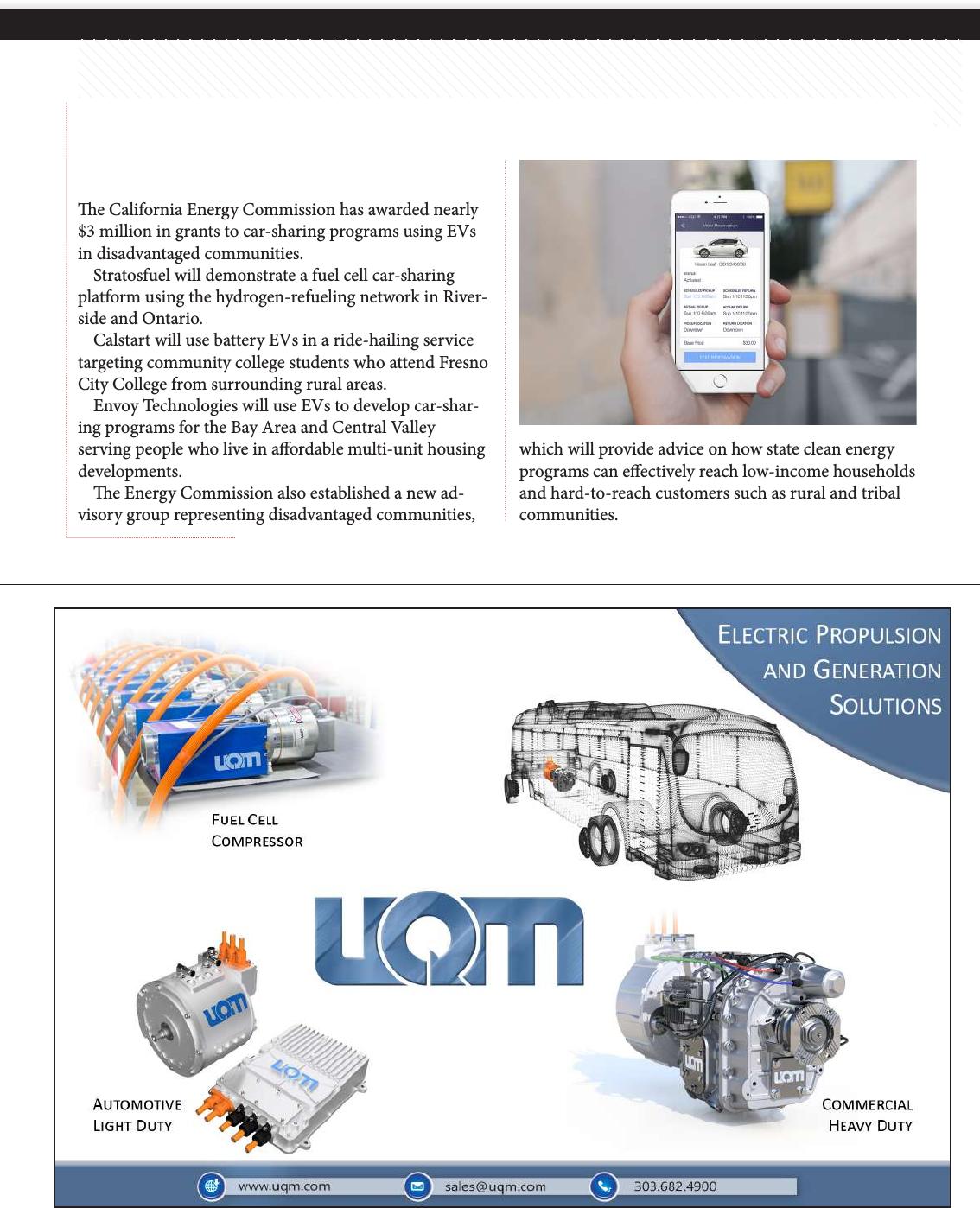
e California Energy Commission has awarded nearly
$3 million in grants to car-sharing programs using EVs
in disadvantaged communities.
Stratosfuel will demonstrate a fuel cell car-sharing
platform using the hydrogen-refueling network in River-
side and Ontario.
Calstart will use battery EVs in a ride-hailing service
targeting community college students who attend Fresno
City College from surrounding rural areas.
Envoy Technologies will use EVs to develop car-shar-
ing programs for the Bay Area and Central Valley
serving people who live in aordable multi-unit housing
developments.
e Energy Commission also established a new ad-
visory group representing disadvantaged communities,
which will provide advice on how state clean energy
programs can eectively reach low-income households
and hard-to-reach customers such as rural and tribal
communities.
California Energy Commission awards $3 million to EV ride-
sharing projects
Photo courtesy of EverCar
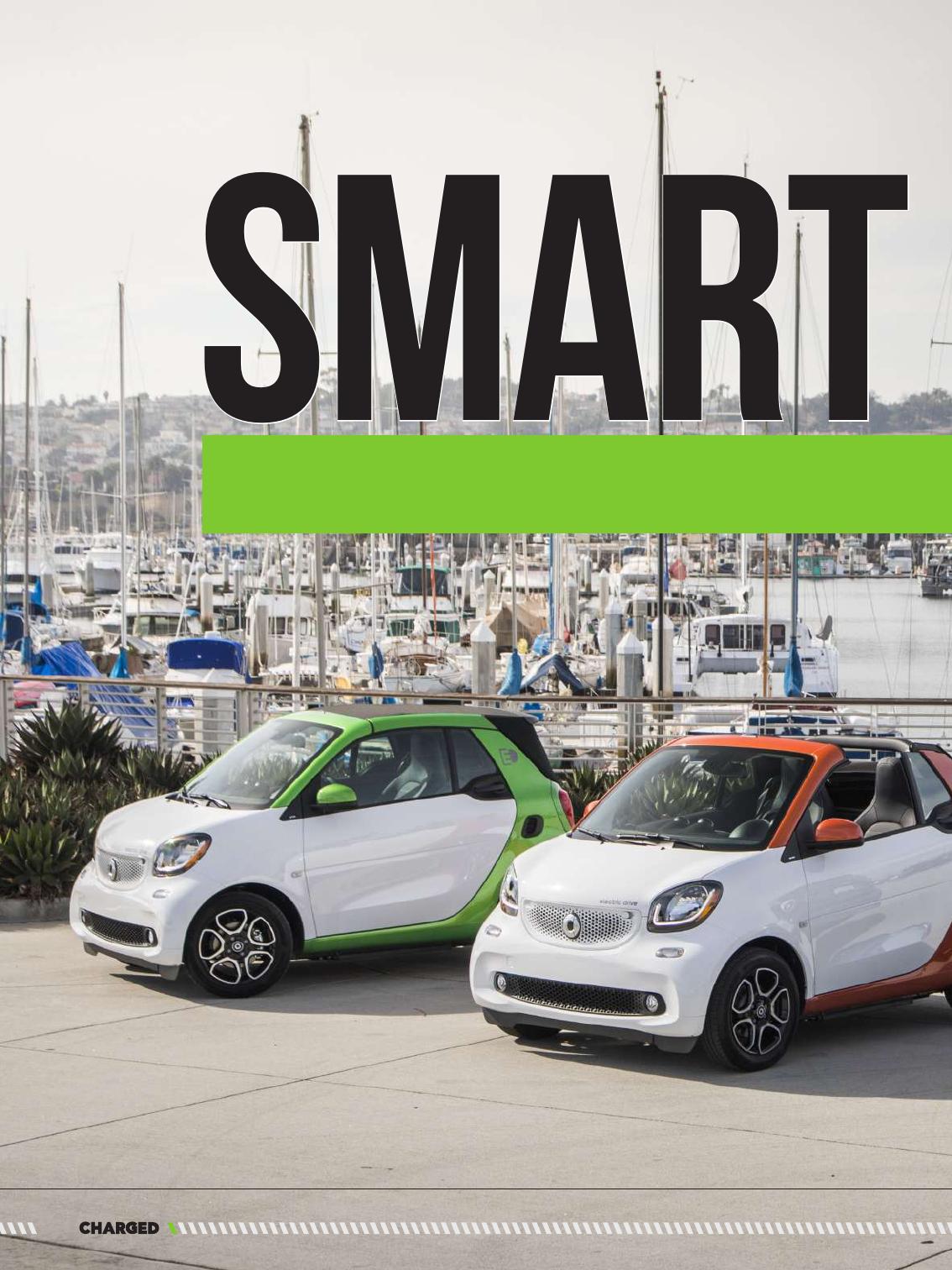
48
smart f ortwo
2018 COUPE AND CABRIO
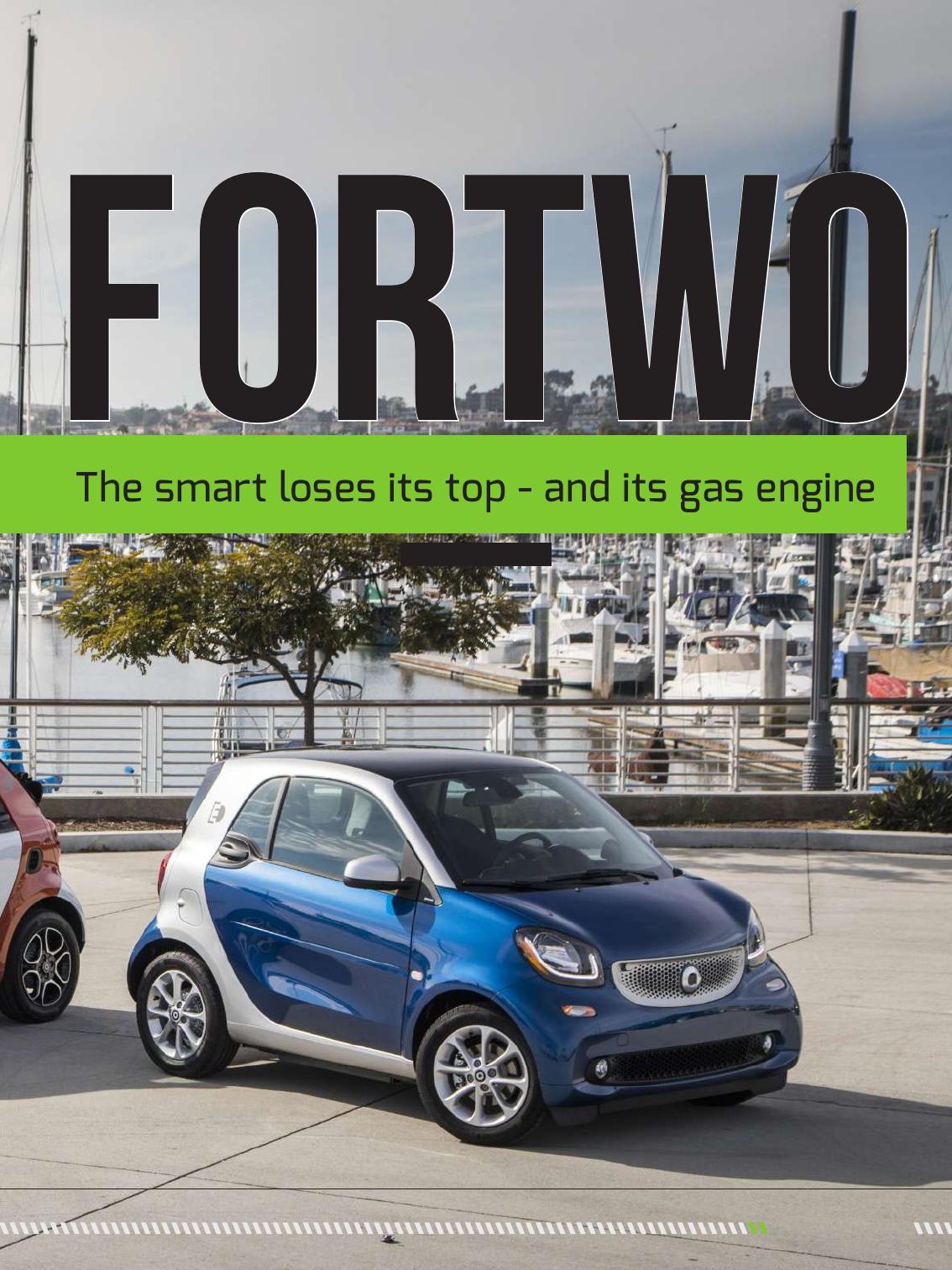
JAN/FEB 2018 49
The smart loses its top - and its gas engine
smart f ortwo
By Charles Morris
Photo courtesy of Mercedes-Benz USA
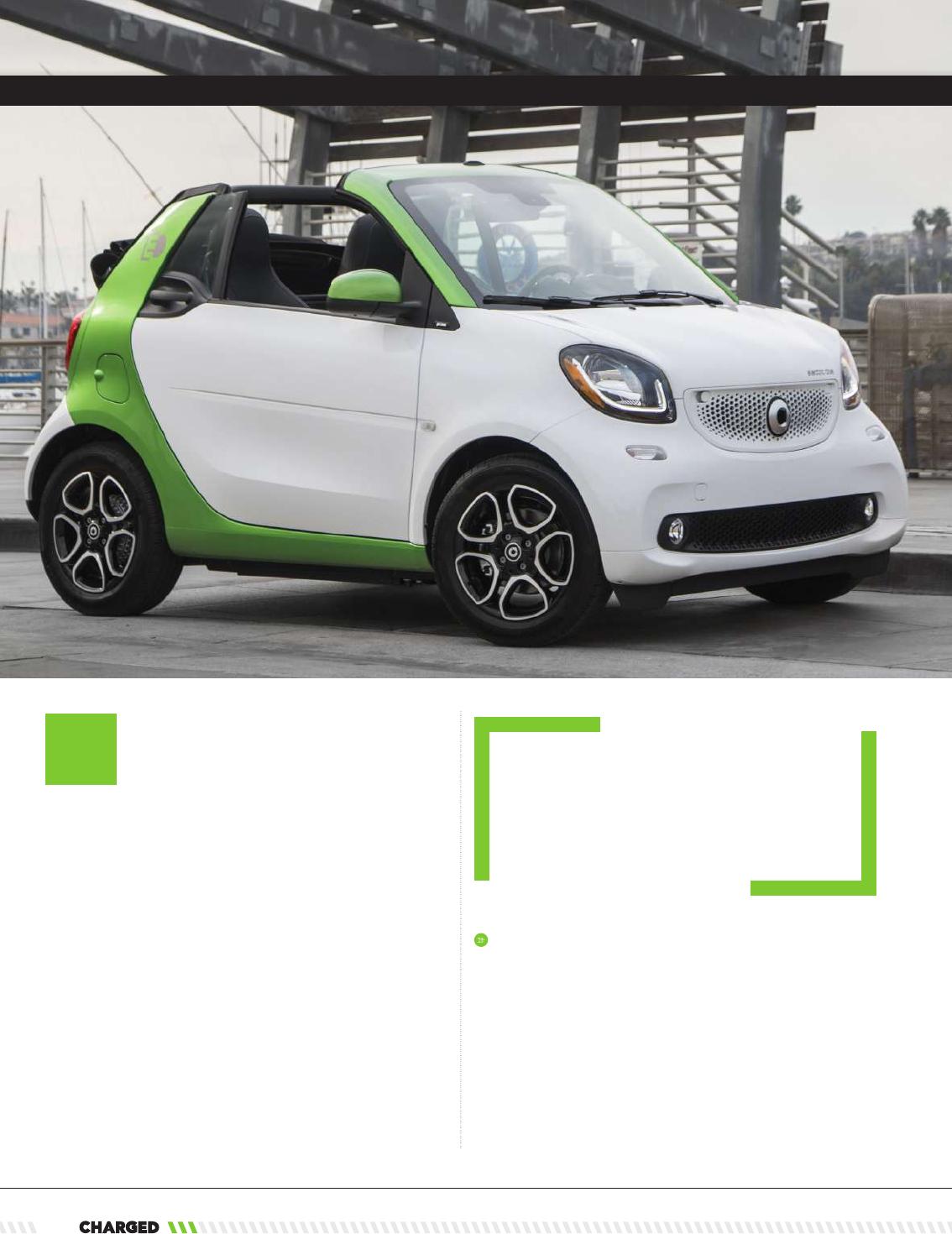
50
Built for the city
e smart’s diminutive size gives it several advantages
in the urban landscape. At 106 inches in length, it’s half
the length of a full-size pickup, and it can park nose-to-
curb in a parallel parking space, or in many a space that
wouldn’t be a space at all for any other car. e smart
can turn around within the width of even a narrow city
street (22.8 feet, the tightest turning circle of any car on
the market). Short overhangs and a high steering angle
are also designed to ensure that the smart “gets around
every corner and into every parking space.”
he smart isn’t for everyone, and it has never
pretended to be. e media buzz these days
centers around the trendy trio - Model 3,
the Bolt and the new LEAF, each of which
aspires to be “your aordable, every-day, one-and-only
car,” as Motor Trend recently put it. e smart does not
aspire to any such universal appeal. It’s a short-range
city car designed for getting around dense urban areas,
and its designers have given it many features intended
to help it excel in that role.
Skeptics of EVs oen dismiss them as “niche ve-
hicles,” forgetting that many useful and popular
vehicles t that description. Neither a pickup truck nor
a Corvette would be the optimal choice for an everyday
family vehicle, and yet neither seems to have a problem
nding buyers. In the US, where most auent families
own more than one car, it may make perfect sense to
have a small, ecient runabout for urban errands, and
something more spacious for big-box visits and road
trips. And dwellers in dense cities around the world
may nd a nimble city car to be quite adequate as their
only vehicle.
T
The smart’s diminutive size
gives it several advantages
in the urban landscape.

THE VEHICLES
JAN/FEB 2018 51
Your correspondent attended a Daimler media event
at which we got to drive the new smart around the
urban core of San Diego, and it turned out to be the per-
fect locale to demonstrate the smart’s advantages. Until
I experienced it, I had never imagined how much easier
it is to negotiate congested city trac in such a petite
car. One glides nimbly among the herds of trucks and
SUVs, like a tiny mammal dodging the feet of dinosaurs.
ere’s always a parking space available, and you almost
never need to shi into reverse - just turn the wheel and
zip o in your desired direction. Make a wrong turn?
No need to go around the block - just check the mirror
and do a 180 right in the middle of the street.
e smart’s city-specic features don’t end there. Like
a streetwise city kid, the smart is designed to take some
Photos courtesy of Mercedes-Benz USA
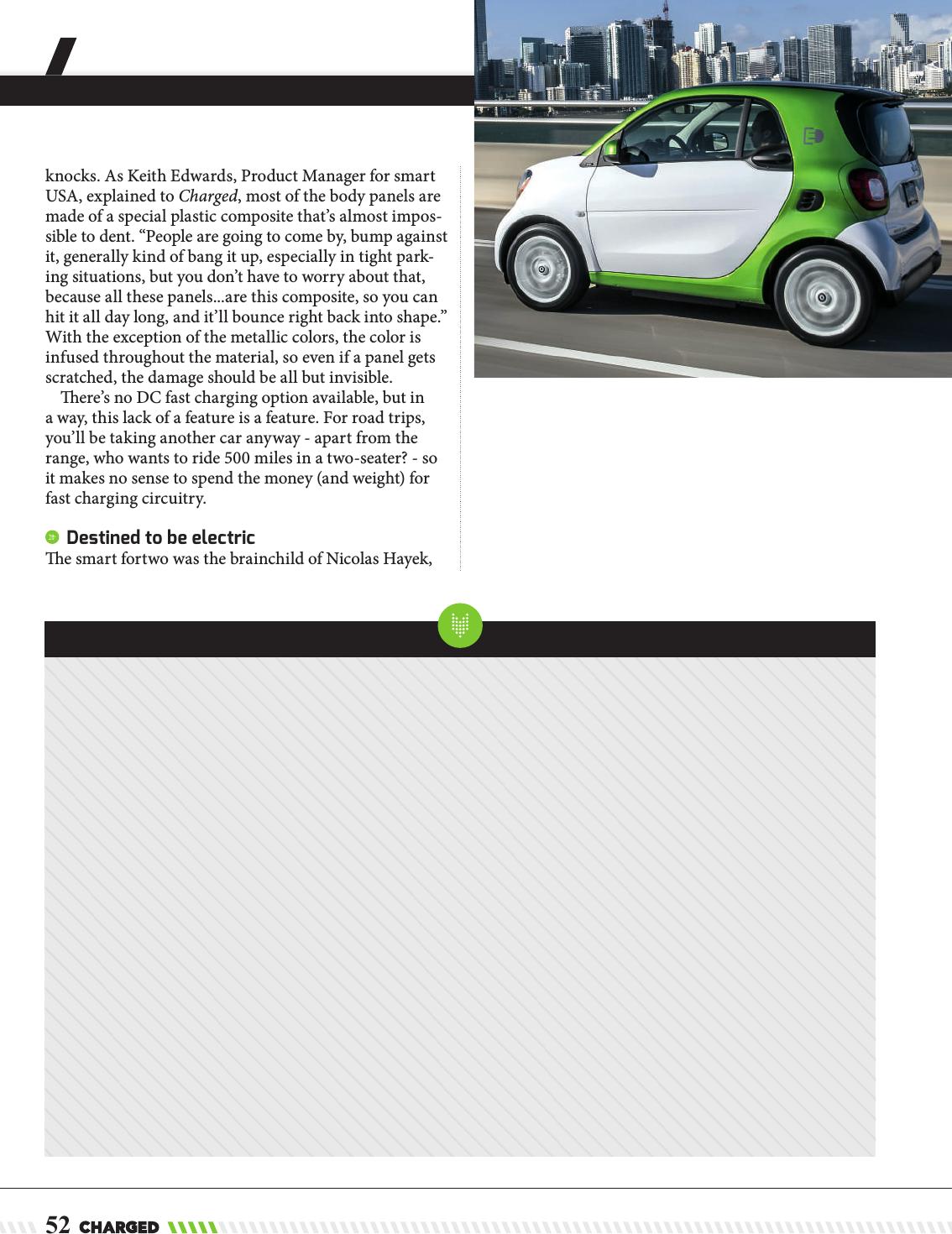
THE VEHICLES
52
knocks. As Keith Edwards, Product Manager for smart
USA, explained to Charged, most of the body panels are
made of a special plastic composite that’s almost impos-
sible to dent. “People are going to come by, bump against
it, generally kind of bang it up, especially in tight park-
ing situations, but you don’t have to worry about that,
because all these panels...are this composite, so you can
hit it all day long, and it’ll bounce right back into shape.”
With the exception of the metallic colors, the color is
infused throughout the material, so even if a panel gets
scratched, the damage should be all but invisible.
ere’s no DC fast charging option available, but in
a way, this lack of a feature is a feature. For road trips,
you’ll be taking another car anyway - apart from the
range, who wants to ride 500 miles in a two-seater? - so
it makes no sense to spend the money (and weight) for
fast charging circuitry.
Destined to be electric
e smart fortwo was the brainchild of Nicolas Hayek,
In 2007, Elon Musk met with Daimler to discuss a deal to
supply Tesla’s powertrain technology for the smart. However,
with no working prototype vehicle to show, his presentation
failed to convince. To win over the pragmatic Germans, the
California cowboys decided to retrot a smart car with an
electric powertrain, and to present it to the Daimler execs
as a surprise. This turned out to be a little tougher than they
thought.
The rst snag was that the smart wasn’t available in the US
at the time. After a bit of research, JB Straubel learned that it
was sold in Mexico, and found one for sale at a dealership in
Tijuana. He dispatched a Spanish-speaking friend across the
border with $20,000 cash in a bag, and he returned a couple
of days later with a brand-new smart.
The Tesla team had only six weeks to gure out how to t
their battery, motor, power electronics and charger into the
tiny smart. Straubel and his engineering team worked 24/7,
grabbing naps on the factory oor, and nally got the job done
at one o’clock one morning. When Straubel hopped in for a
test drive, the tiny hot-rod popped a wheelie and peeled out
of the parking lot.
The Daimler executives showed up at Tesla HQ ready to
be disappointed, but when VP Herbert Kohler got behind the
wheel and zipped out into the street, the skeptical look on his
face was quickly replaced by a big smile. Shortly thereafter,
Daimler signed a $70-million contract for Tesla to supply bat-
teries for what became the smart electric drive. Daimler also
acquired an equity stake in Tesla for a reported $50 million,
a deal which, as Elon Musk later admitted, saved the young
company from bankruptcy. Considering Tesla’s dominant role
today, it might not be too much to say that Straubel’s hacked
smart saved the entire EV industry as we know it.
Tesla learned a lot from its mentor over the course of the
partnership, especially in elds such as noise and vibration
reduction, safety and quality control, which it applied to the
development of Model S. Daimler gained not only a boost
to its battery tech, but some bad-boy internet-age mojo. A
few years later, the companies expanded their partnership
when Tesla provided the electric drivetrain for the Mercedes
B-Class Electric Drive.
However, as Tesla grew, Daimler (and Toyota, with which
it had a similar partnership) apparently began to see it as
a competitor, and ended its cooperation. Daimler sold its
ownership stake in Tesla in 2014 - at a prot of $780 million!
In 2016, having acquired its own battery subsidiary (Deutsche
Accumotive), Daimler terminated its Tesla ties.
Traces of Tesla in the smart’s DNA
the Swiss-Lebanese mastermind of the Swatch, who
originally conceived of it as an electric vehicle. However,
electric drive didn’t turn out to be feasible in 1998, so
the rst generation debuted with a gas engine. It was
only in 2006 that battery technology had advanced to
the point that Daimler began work on the smart electric
drive, which came on the market in 2009 (with batteries
from Tesla - see sidebar).
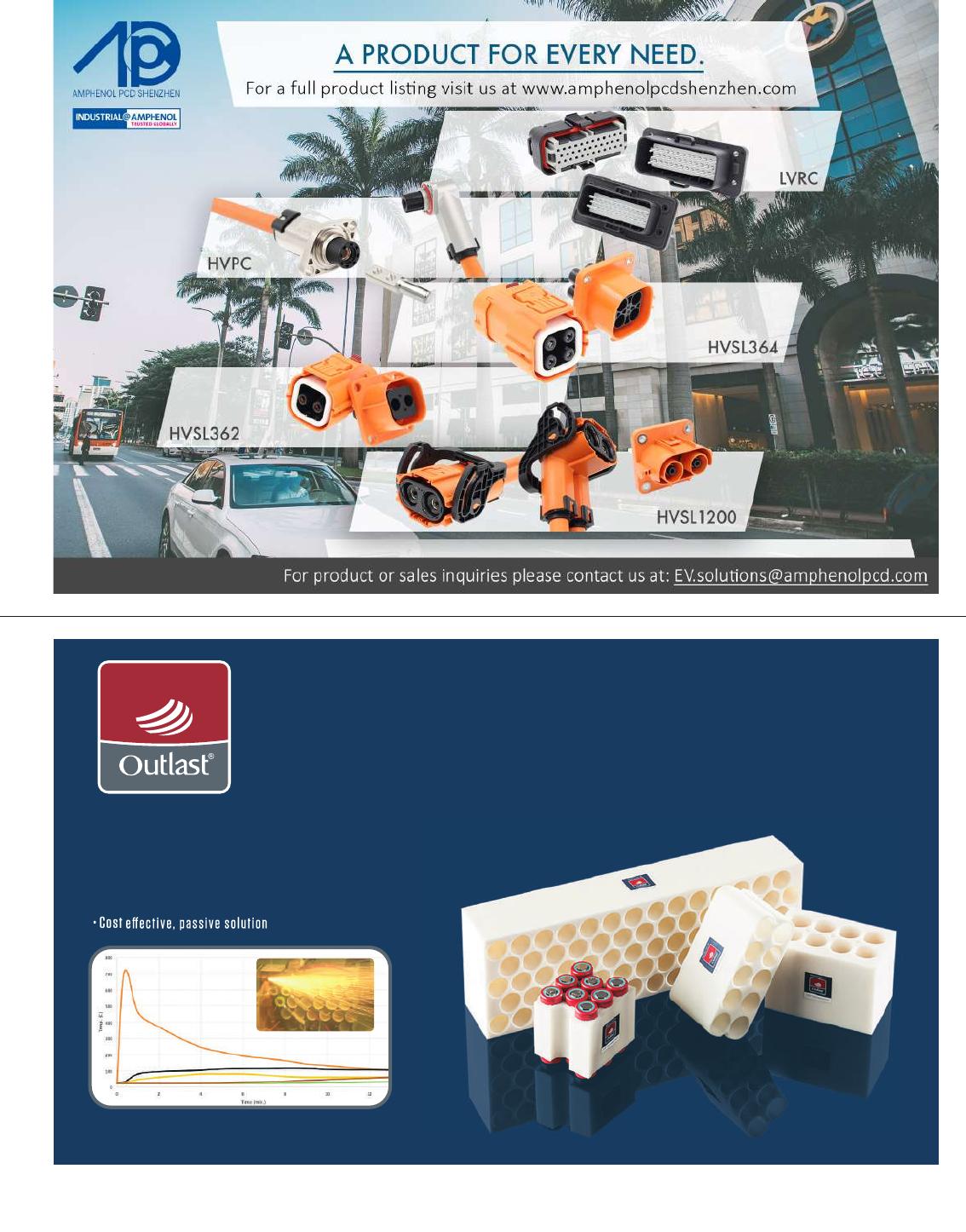
SAFETY AND PERFO RMANCE
LATENT HEAT SYSTEMS (LHS )
® ®
W W W . O UTLA STLHS.COM
• Eliminate s The rmal Propagation
• T h e r m a l m i t i g a t i o n d u r i n g h i g h c h a r g e a n d d i s c h a r g e c y c l e
• H o m o g e n o u s c e l l t e m p e r a t u r e s t h r o u g h o u t t h e p a c k
• O v e r 4 0 % B a t t e r y L i f e i m p r o v e m e n t
• C o s t
CORNE R CELL PEN ETRAT I O N TES T
Run
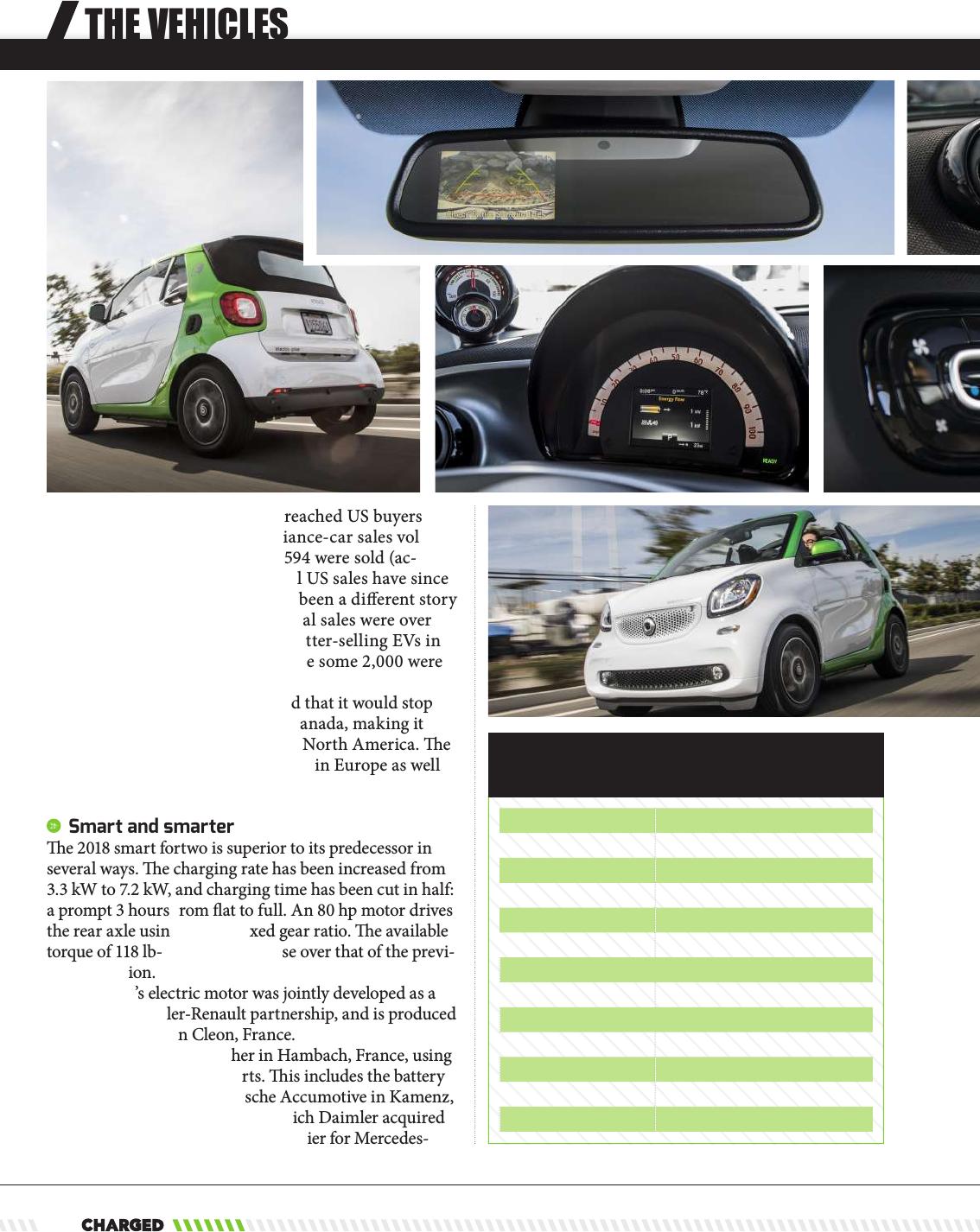
THE VEHICLES
54
e smart electric drive (ED) reached US buyers in
2013, but never exceeded compliance-car sales volumes
- its best year was 2014, when 2,594 were sold (ac-
cording to InsideEVs), and annual US sales have since
dwindled to the three gures. It’s been a dierent story
in the rest of the world - 2016 global sales were over
144,000. e smart is one of the better-selling EVs in
its home market of Germany, where some 2,000 were
sold in 2017.
Last February, smart announced that it would stop
selling gas models in the US and Canada, making it
one of only two EV-only brands in North America. e
brand plans to phase out gas models in Europe as well
over the next year.
Smart and smarter
e 2018 smart fortwo is superior to its predecessor in
several ways. e charging rate has been increased from
3.3 kW to 7.2 kW, and charging time has been cut in half:
a prompt 3 hours from at to full. An 80 hp motor drives
the rear axle using a single xed gear ratio. e available
torque of 118 lb- is a 23% increase over that of the previ-
ous generation.
e smart’s electric motor was jointly developed as a
part of the Daimler-Renault partnership, and is produced
at Renault’s plant in Cleon, France.
e vehicle comes together in Hambach, France, using
largely German-sourced parts. is includes the battery
pack, which is built by Deutsche Accumotive in Kamenz,
Saxony. Deutsche Accumotive, which Daimler acquired
in 2014, is now the sole battery supplier for Mercedes-
The specs
Drivetrain
rear-wheel drive
Motor
air-cooled 3-phase
Power
60 kW (80 hp)
Torque
118 lb-ft
Battery capacity
17.6 kWh
Range
58 miles (EPA estimate)
Acceleration 0-60 mph
under 12 seconds
Top speed
electronically limited to 81 mph
Charging
Level 2, 7.2 kW (3 hours to full
charge)
Length/width/height
106.1/65.6/61.2 inches
Turning circle
22.8 feet
Curb weight
2,363-2,383 lbs
Base price
$23,900
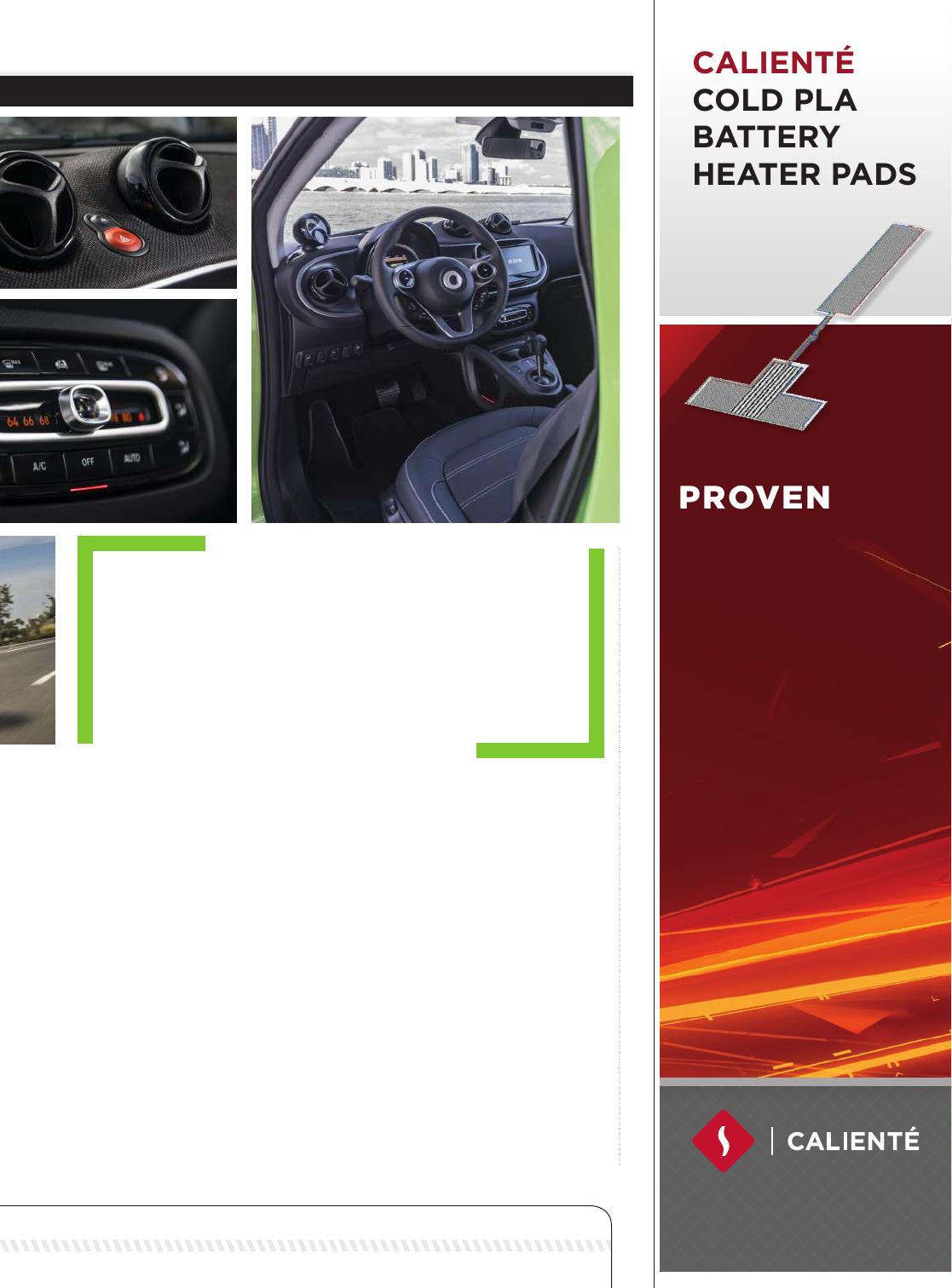
Benz and smart, and is believed to be the only company currently as-
sembling battery packs in Germany. Daimler recently announced plans
to invest €500 million to construct a second battery factory in Kamenz,
which will quadruple production space to 80,000 square meters.
e 2018 smart’s 17.6 kWh battery pack features a liquid thermal
management system. Located under the front seats, it is supported by a
crash-absorbing frame made of high-strength steel tubes.
e user-selectable Eco mode reduces the amount of energy drawn
from the battery, and reduces the output of the climate control system.
Pre-conditioning allows the cabin to be heated or cooled while the smart
is still plugged in.
e smart may be small, but it comes with most of the high-tech bells
and whistles we’ve come to expect, including a color 3.5-inch touch-
screen (optionally upgradable to a 7-inch); a rearview camera; driver
assistance systems such as Crosswind Assist (standard) and Forward
Collision Warning (optional).
A retro-looking analog power meter displays the state of charge as well
as the current level of energy consumption or regeneration.
A sound generator broadcasts a warning sound to pedestrians, which
Run
CALIENTÉ EV
COLD PLATE
BATTERY
HEATER PADS
CalienteLLC.com
info@calientellc.com
260.426.3800
PROVEN
TO PERFORM.
• Heats battery directly
without impacting cooling
• More uniform ramp up
• More energy ecient
• Lower weight
• More cost eective
• Eliminates isolation failure
Last February, smart announced that it
would stop selling gas models in the US
and Canada, making it one of only two
EV-only brands in North America.
Photos courtesy of Mercedes-Benz USA

56
is audible below about 18 mph - above this speed, the
sound is automatically masked by rolling noise and
wind noise.
ere are three trim levels: the base pure trim line of-
fers a choice of black cloth or man-made leather uphol-
stery. e passion line adds more color combinations,
a leather steering wheel, height-adjustable driver’s seat,
electric and heated side-view mirrors, retractable cargo
cover and 15-inch wheels. e prime line adds a sunroof
(for the coupe variant), ambient interior lighting, heated
seats, rain-sensing wipers and LED running lights and
taillamps.
Starting at $23,900 before federal or state incen-
tives, the smart electric drive is by far the cheapest EV
available in the US. Of course, there are loads of op-
tions available, and a fully-loaded cabrio can easily top
$30,000. But if you can qualify for the $7,500 federal tax
credit, plus a fat state incentive like California’s $2,500
rebate, you could be driving electric for around 15
grand.
Take the top off
By now, the smart probably sounds like a paragon of prac-
ticality, the attribute that every car buyer should prize...
and that few really do. But smart has always included a
healthy helping of fun in its vehicles (there were reasons
that people bought the gas smart, despite its surprisingly
poor fuel eciency), and the new model has plenty built
in. It’s as zippy as you’d expect an EV to be, and its unique
dimensions make for a unique driving experience.
And if you really want fun, take a spin in the cabrio
version - yes, it’s the world’s only convertible EV. At
the touch of a button, the canvas roof rolls back, letting
Mother Nature in. You can remove the roof bars and
stash them in a handy rear compartment to open things
up even more.
Starting at $23,900 before
federal or state incentives, the
smart electric drive is by far the
cheapest EV available in the US.
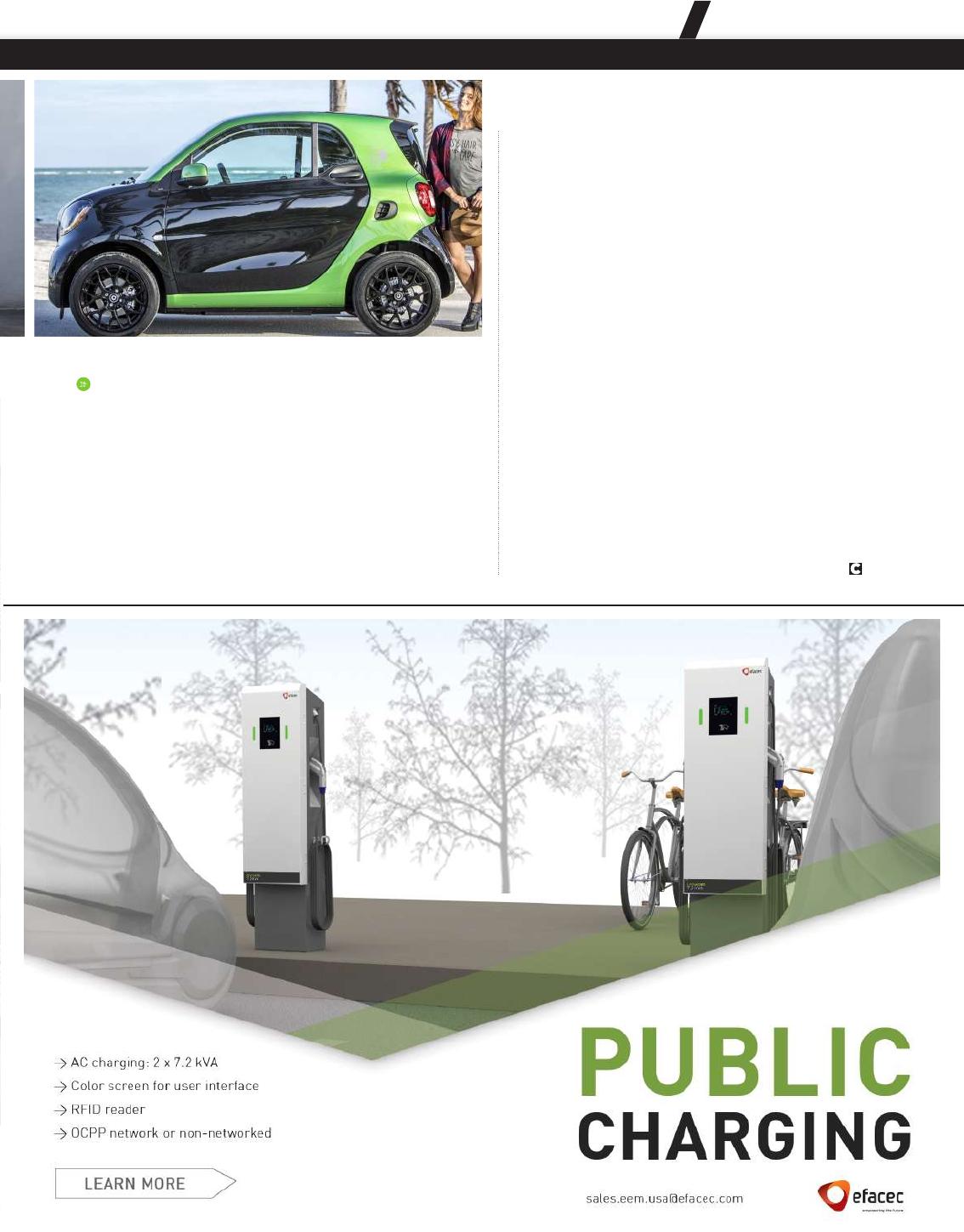
THE VEHICLES
hexagon, and so you actually see a design motif
around the car that’s a nod to the strength of it, on
the taillight, on the speaker covers, the grill, you get
this honeycomb shape, which is a nod to that Tridion
safety cell.”
Is the structure just as rigid when you remove the
roof bars in order to open up the top? Absolutely, says
Edwards. “e only function [the roof bars] serve is to
provide the sliding rail for the so top. e structure
of the cabrio is reinforced with tubular reinforcements,
the A-pillar has some reinforcement in the chassis on
the underside, and then it has this basket handle, so
this is not actually a structural part of the vehicle, and
it keeps you just as safe as the coupe, even when you’re
enjoying this completely top-down driving.”
Safety equipment includes eight airbags. According
to Daimler, the focus in crash testing was on how the
smart would perform in a collision with a substantially
larger and heavier vehicle (which would of course
almost certainly be the case in a real crash). e com-
pany says the smart fortwos “performed well in frontal
collisions with the Mercedes S- and C-Class.”
Be smart, be safe
Keith Edwards explained how the new smart is de-
signed for safety. “e Tridion safety cell is kind of the
safety concept of the car, so on the two-toned ones, it’s
usually the accent color, where it’s actually ultra-high-
strength steel and a mix of other materials, and the
idea behind it is that it acts like a wall bar or a roll cage
or kind of the shell of a nut, where it’s designed to take
an impact and dissipate those forces around the car.”
“It’s kind of the same idea as a honeycomb or a
Photos courtesy of Mercedes-Benz USA
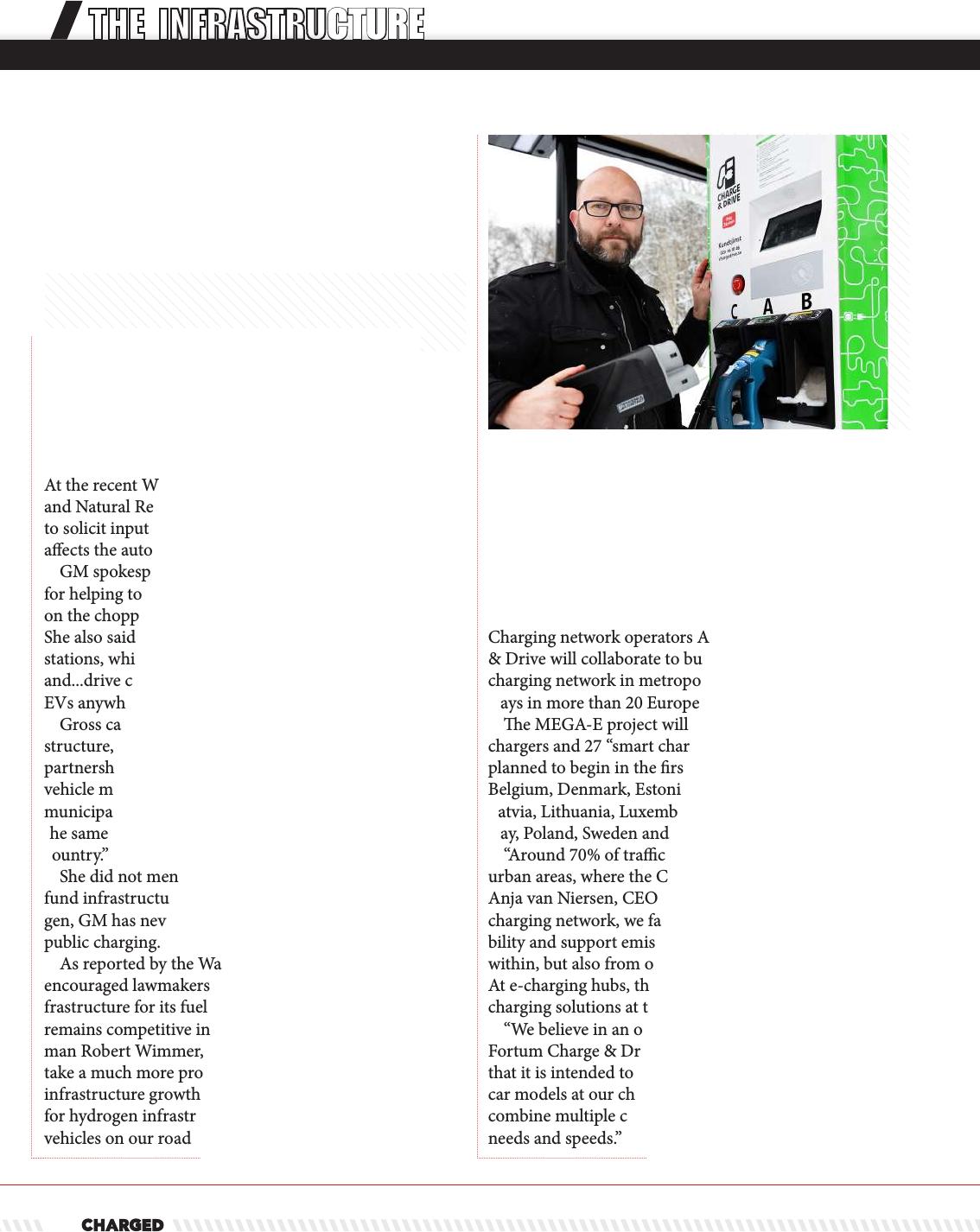
58
THE INFRASTRUCTURE
Charging network operators Allego and Fortum Charge
& Drive will collaborate to build an interoperable
charging network in metropolitan areas and along high-
ways in more than 20 European countries.
e MEGA-E project will include 322 “ultra-fast”
chargers and 27 “smart charging hubs.” e roll-out is
planned to begin in the rst half of 2018, beginning in
Belgium, Denmark, Estonia, Finland, France, Germany,
Latvia, Lithuania, Luxembourg, the Netherlands, Nor-
way, Poland, Sweden and the UK.
“Around 70% of trac in Europe takes place in
urban areas, where the CO
2
impact is the highest,” says
Anja van Niersen, CEO of Allego. “With the MEGA-E
charging network, we facilitate several forms of e-mo-
bility and support emission-free traveling not only
within, but also from one metropolitan area to another.”
At e-charging hubs, the network will combine multiple
charging solutions at the same location.
“We believe in an open infrastructure approach,” says
Fortum Charge & Drive VP Rami Syväri. “is means
that it is intended to welcome every citizen and dierent
car models at our chargers. e idea is therefore also to
combine multiple charging solutions to meet dierent
needs and speeds.”
At the recent Washington Auto Show, the Senate Energy
and Natural Resources Committee held a eld hearing
to solicit input from stakeholders on public policy that
aects the auto industry.
GM spokesperson Britta Gross thanked the committee
for helping to retain the $7,500 EV tax credit, which was
on the chopping block in the recent budget negotiations.
She also said that the nation needs more public charging
stations, which need to be “highly visible to consumers
and...drive consumer condence in the ability to drive
EVs anywhere at any time.”
Gross called for federal funding for charging infra-
structure, saying that the market requires “continued
partnership between electric utilities, station operators,
vehicle manufacturers, and support by federal, state and
municipal government to establish charging stations at
the same scale as the 168,000+ gas stations across the
country.”
She did not mention any contribution from GM to
fund infrastructure. Unlike BMW, Nissan, and Volkswa-
gen, GM has never shown any interest in investing in
public charging.
As reported by the Washington Examiner, Toyota
encouraged lawmakers to fund hydrogen fueling in-
frastructure for its fuel cell vehicles. “To ensure the US
remains competitive in this space,” said Toyota spokes-
man Robert Wimmer, “the federal government needs to
take a much more proactive role supporting hydrogen
infrastructure growth. Without robust federal support
for hydrogen infrastructure...the numbers of fuel cell
vehicles on our roads will remain modest.”
Allego and Fortum collaborate
on an interoperable charging
network to span 20 European
countries
GM wants Congress to fund
EVSE, Toyota wants hydrogen
fueling infrastructure
Photos courtesy of Fortum
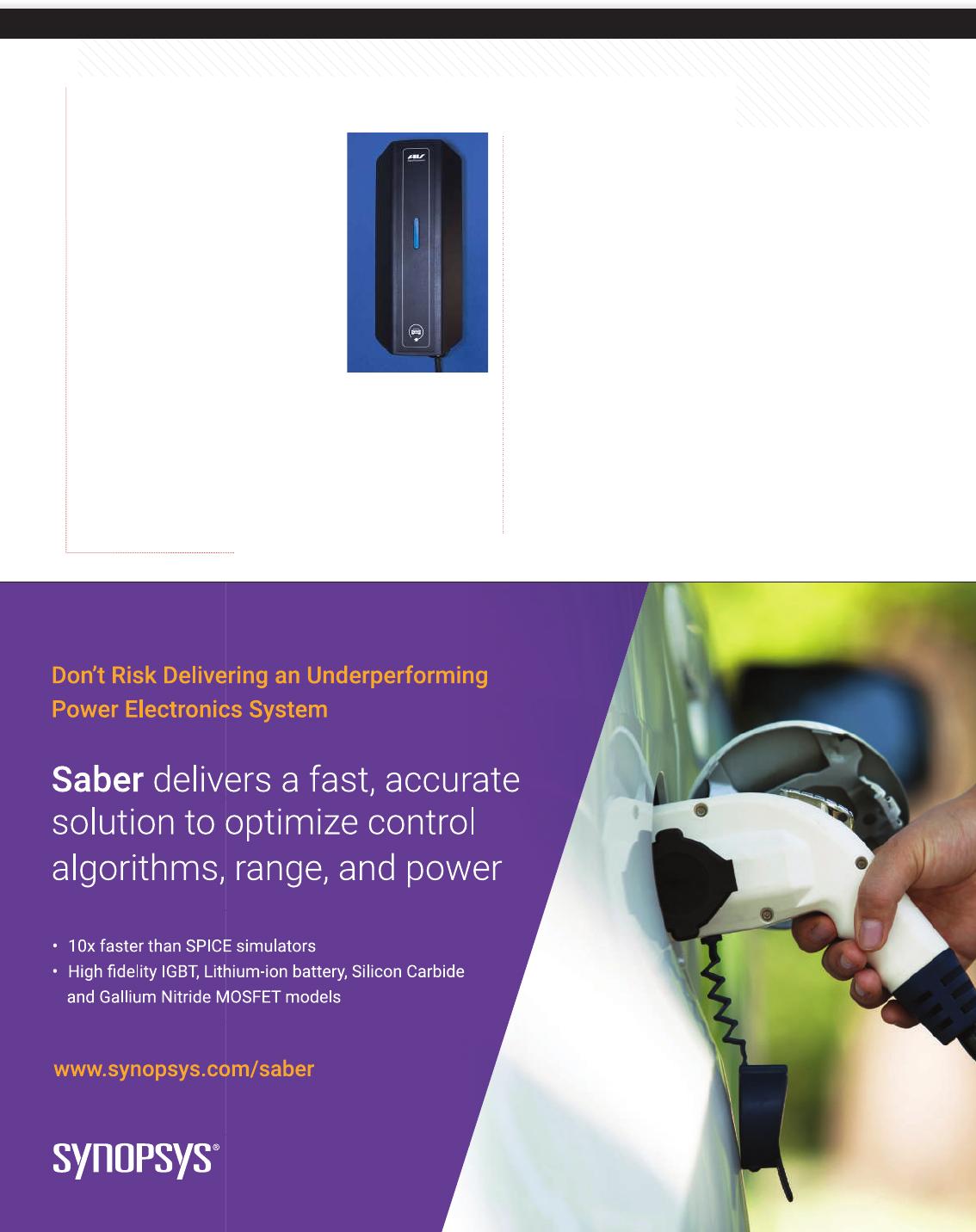
AeroVironment’s new TurboDX charging solution
tion that allows customers to choose from a variety of
Open Charge Point Protocol (OCPP) compliant network
providers. It also oers a Bluetooth-enabled non-net-
worked mobile access control option.
TurboDX features a proprietary thermal management
algorithm that allows a connected vehicle to charge
during high ambient temperature conditions while con-
tinuously monitoring the charging session to ensure safe
operation.
AeroVironment has begun shipping TurboDX for
OEM and commercial customers. It will be available for
retail purchase online beginning in the rst quarter at an
MSRP of $469 for the 16-amp version.
“TurboDX is loaded with advanced, user-friendly fea-
tures to ensure a hassle-free, smart-charging experience,”
said AeroVironment VP Ken Karklin. “TurboDX can be
easily congured to address the specic needs of em-
ployers, landlords, individual homeowners and property
managers who need a exible solution.”
AeroVironment (NASDAQ:AVAV)
has introduced TurboDX, the
company’s next-generation Level
2 charging station for commercial,
workplace, utility and residential
customers.
TurboDX has been certied by
Underwriters Laboratory to North
American UL Standards for safety
and reliability. European variants
are certied to IEC standards, and
Chinese congurations meet the
CQC certication.
TurboDX is oered in 16- and 32-amp versions, with
15-foot or 25-foot cords. It accommodates a dual, triple
or quad installation, and its modular design makes it
easy to expand the number of chargers as needed.
TurboDX, which builds on AeroVironment’s popular
TurboCord charging system, is an open networked solu-
Photos courtesy of AeroVironment
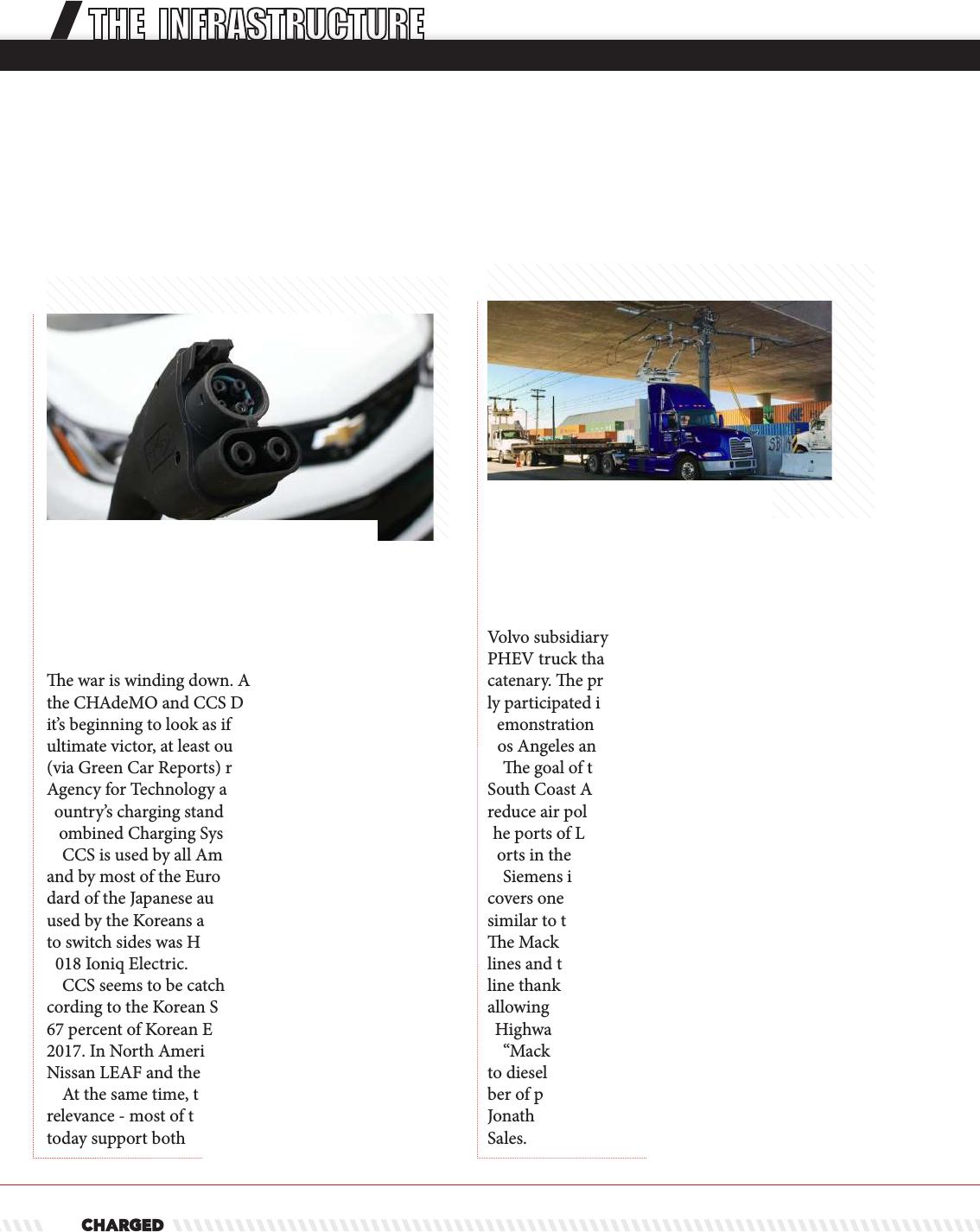
60
THE INFRASTRUCTURE
e war is winding down. Aer years of conict between
the CHAdeMO and CCS DC fast charging standards,
it’s beginning to look as if CCS is destined to be the
ultimate victor, at least outside of Japan. Business Korea
(via Green Car Reports) reports that the South Korean
Agency for Technology and Standards plans to revise the
country’s charging standard to recommend the use of the
Combined Charging System (CCS) for future EVs.
CCS is used by all American automakers except Tesla,
and by most of the Europeans. CHAdeMO is the stan-
dard of the Japanese automakers and, until recently, was
used by the Koreans as well. e rst Korean automaker
to switch sides was Hyundai, which chose CCS for its
2018 Ioniq Electric.
CCS seems to be catching on quickly in Korea - ac-
cording to the Korean Society of Automotive Engineers,
67 percent of Korean EVs used the CCS standard in
2017. In North America, CHAdeMO is used only by the
Nissan LEAF and the Kia Soul EV compliance car.
At the same time, the conict has lost some of its
relevance - most of the DC fast chargers being installed
today support both standards.
South Korea to officially
adopt CCS fast charging
standard
Volvo subsidiary Mack Trucks has demonstrated a
PHEV truck that can recharge by means of an overhead
catenary. e prototype Mack Pinnacle DayCab recent-
ly participated in a one-mile, zero-emission eHighway
demonstration in Carson, California, near the ports of
Los Angeles and Long Beach.
e goal of the project, which is sponsored by the
South Coast Air Quality Management District, is to
reduce air pollution at freight-intensive locations, such as
the ports of Los Angeles and Long Beach, the two largest
ports in the US.
Siemens installed the eHighway infrastructure, which
covers one mile of highway lanes with a catenary system
similar to those used to power trolleys or streetcars.
e Mack truck can connect to the overhead contact
lines and transfer energy to the truck’s electric drive-
line thanks to a current collector supplied by Siemens,
allowing it to operate with zero tailpipe emissions on the
eHighway corridor.
“Mack continuously investigates alternative solutions
to diesel, and the catenary system is just one of a num-
ber of projects in which we are currently involved,” said
Jonathan Randall, Mack’s Senior VP of North American
Sales.
Mack demonstrates
catenary-powered PHEV at
port of Los Angeles
Photo courtesy of Mack
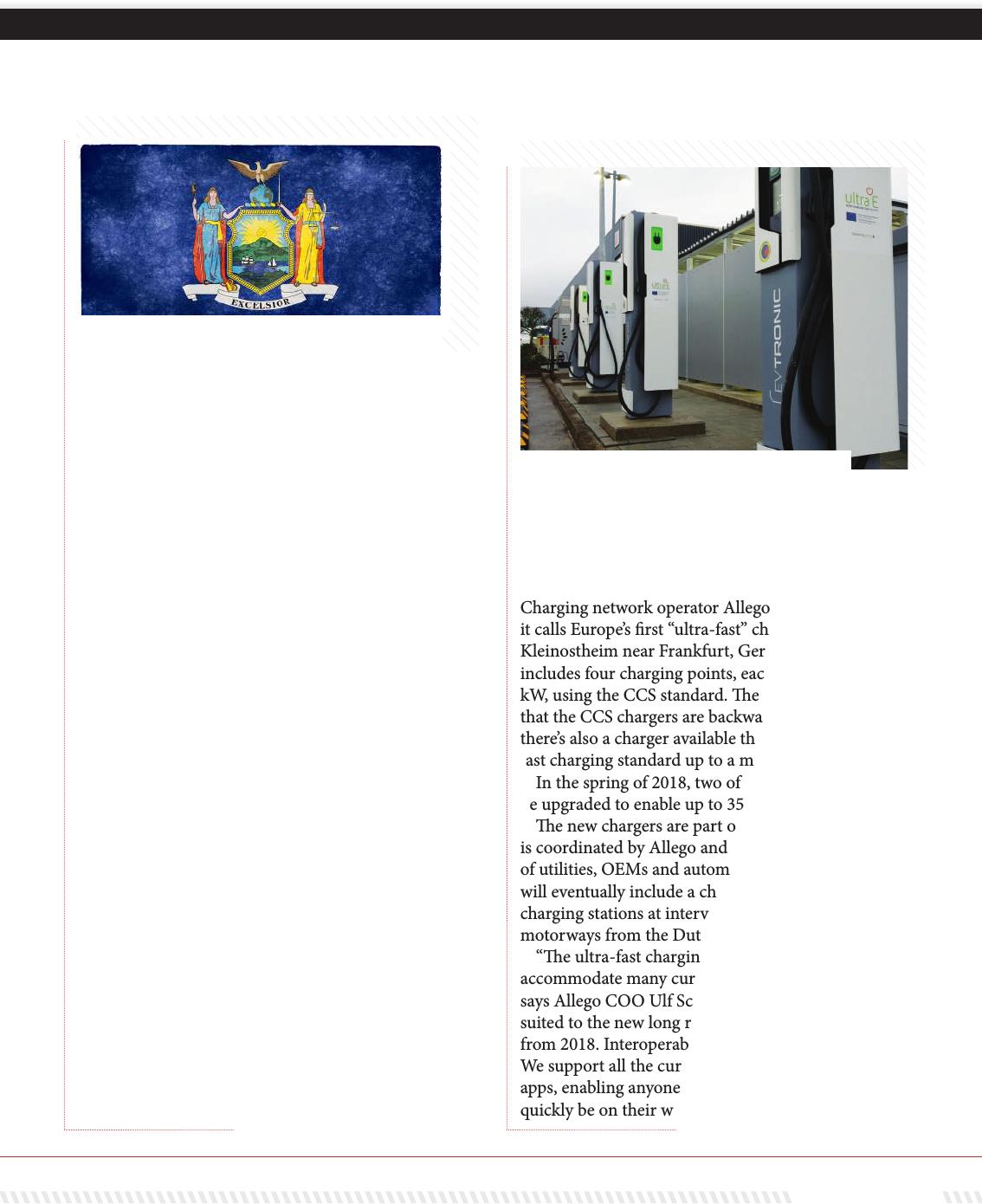
Charging network operator Allego has deployed what
it calls Europe’s rst “ultra-fast” charging station, at
Kleinostheim near Frankfurt, Germany. e station
includes four charging points, each with a capacity of 175
kW, using the CCS standard. e company told Charged
that the CCS chargers are backwards-compatible, and
there’s also a charger available that is suitable for every
fast charging standard up to a maximum of 50 kW.
In the spring of 2018, two of the charging points will
be upgraded to enable up to 350 kW of power.
e new chargers are part of the Ultra-E project, which
is coordinated by Allego and supported by an alliance
of utilities, OEMs and automotive suppliers. e project
will eventually include a charging corridor with 21 fast
charging stations at intervals of 150 to 200 kilometers on
motorways from the Dutch coast to the Austrian border.
“e ultra-fast charging stations are designed to
accommodate many current and future types of e-car,”
says Allego COO Ulf Schulte. “ey are particularly
suited to the new long range e-cars that will be available
from 2018. Interoperability comes as standard at Allego.
We support all the current charging cards and access
apps, enabling anyone to charge their e-car at Allego and
quickly be on their way.”
New York Governor
announces $3.5 million in
R&D funding for EV-grid
integration
JAN/FEB 2018 61
Photo courtesy of Allego
New York Governor Andrew M. Cuomo has announced
the availability of up to $3.5 million for R&D proposals
to accelerate the use of EVs, reduce the cost of installing
and operating charging stations, and provide recommen-
dations on how they can be used for grid resiliency.
e New York State Energy Research and Develop-
ment Authority (NYSERDA) will administer the solici-
tation of proposals. e agency is particularly interested
in proposals for business models and technologies to
manage the relationship between EVs and the electric
grid, for example: how to reduce the impact of charging
vehicles on the grid; how vehicles can be integrated into
buildings to provide backup power; and how to remotely
manage charging at peak times.
Earlier this year, Governor Cuomo announced the
Drive Clean Rebate, a $70-million rebate initiative that
has already provided more than $3 million in rebates to
New Yorkers for the purchase or lease of plug-in vehicles.
In the rst three months of the program, New York’s EV
sales increased 61 percent over the same time period last
year.
“e Drive Clean Rebate and other state initiatives
have made electric cars and charging stations more
aordable and accessible to consumers across the state
- but we have more work to do,” said NYSERDA CEO
Alicia Barton. “At NYSERDA we are expanding our focus
to research eorts that will help New York better inte-
grate electric vehicles into the grid.”
175 kW charging station
opens in Germany, 350 kW
coming soon
Image courtesy of Nicolas Raymond
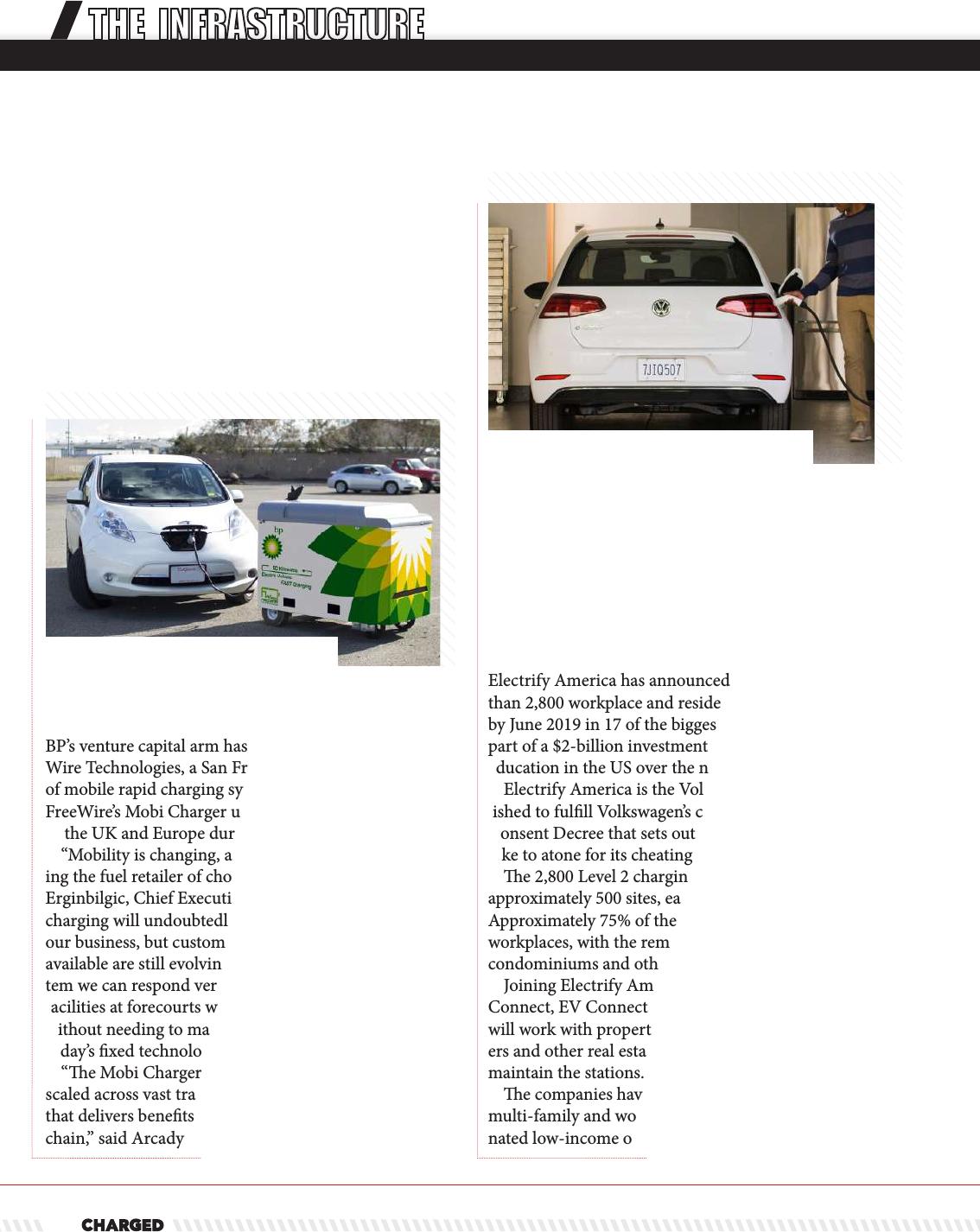
62
THE INFRASTRUCTURE
Electrify America has announced it will install more
than 2,800 workplace and residential charging stations
by June 2019 in 17 of the biggest US metropolitan areas,
part of a $2-billion investment in EV infrastructure and
education in the US over the next 10 years.
Electrify America is the Volkswagen subsidiary estab-
lished to fulll Volkswagen’s commitments under the
Consent Decree that sets out measures the company will
take to atone for its cheating on diesel emissions.
e 2,800 Level 2 charging stations will be located at
approximately 500 sites, each with more than one station.
Approximately 75% of the new chargers will be located at
workplaces, with the remainder at apartment buildings,
condominiums and other multi-family properties.
Joining Electrify America in this initiative are Sema-
Connect, EV Connect and Greenlots. ese companies
will work with property developers, oce facility manag-
ers and other real estate site hosts to install, operate and
maintain the stations.
e companies have agreed to install 35% of all
multi-family and workplace sites in California in desig-
nated low-income or disadvantaged community areas.
VW subsidiary Electrify
America to install 2,800
charging stations at
workplaces and multi-unit
dwellings
BP’s venture capital arm has invested $5 million in Free-
Wire Technologies, a San Francisco-based manufacturer
of mobile rapid charging systems, and plans to roll out
FreeWire’s Mobi Charger units at selected BP retail sites
in the UK and Europe during 2018.
“Mobility is changing, and BP is committed to remain-
ing the fuel retailer of choice into the future,” said Tufan
Erginbilgic, Chief Executive of BP Downstream. “EV
charging will undoubtedly become an important part of
our business, but customer demand and the technologies
available are still evolving. Using FreeWire’s mobile sys-
tem we can respond very quickly and provide charging
facilities at forecourts where we see the greatest demand
without needing to make signicant investments in
today’s xed technologies and infrastructure.”
“e Mobi Charger can be quickly and cost-eectively
scaled across vast transportation networks - exibility
that delivers benets all along the EV charging value
chain,” said Arcady Sosinov, CEO of FreeWire.
BP invests in mobile
charging company FreeWire
Photo courtesy of VW
Photo courtesy of BP
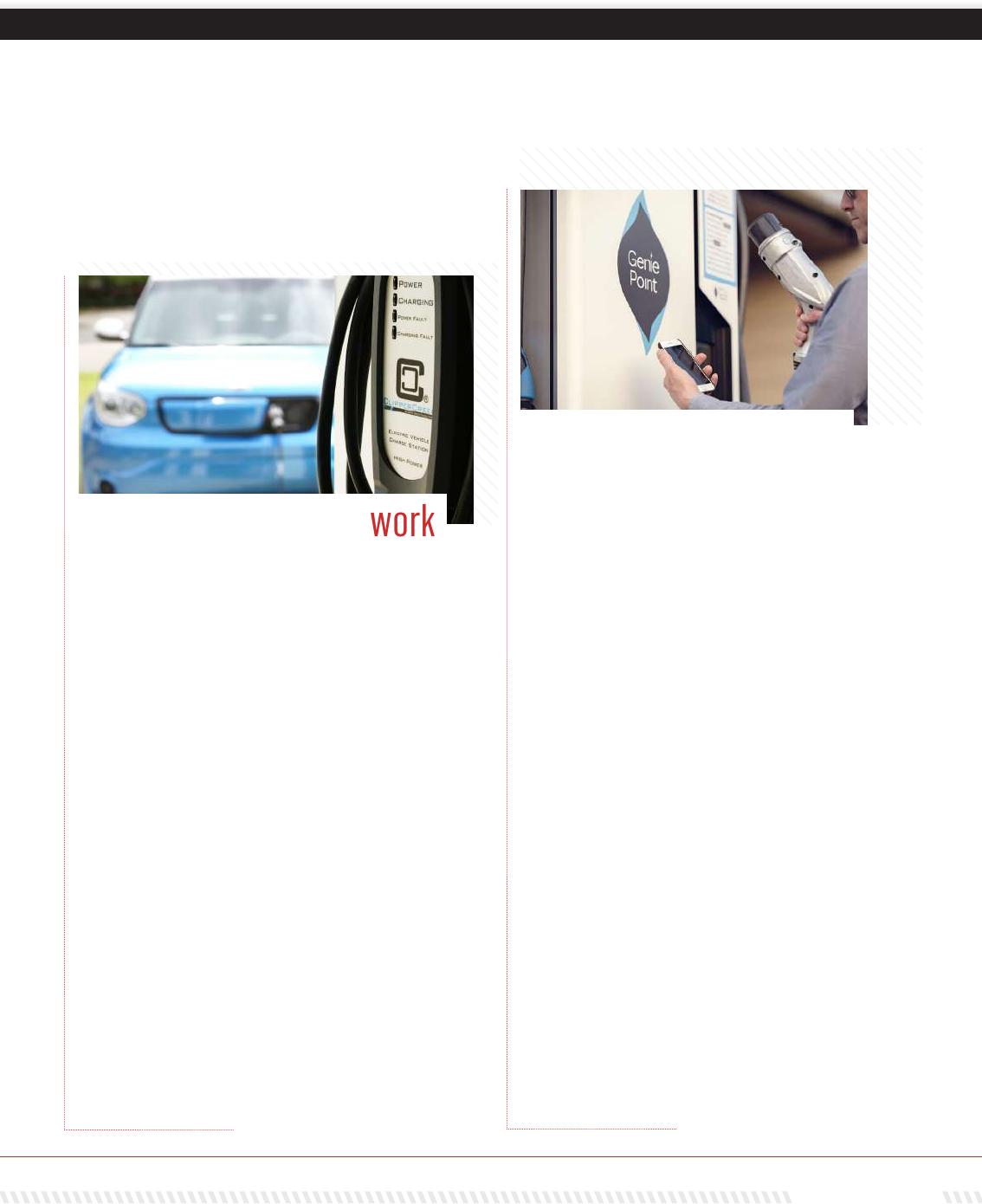
Under its new EV Charge Network program, Pacic
Gas and Electric (PG&E) will install 7,500 new Level 2
charging stations at condominiums, apartment buildings
and workplaces across Northern and Central California.
e focus is on increasing access to charging in loca-
tions where it has traditionally been limited and where
cars oen sit for longer periods of time, such as work-
places and apartment buildings.
e three-year program will continue through 2020,
with a budget of $130 million. PG&E will pay for and
build the infrastructure from the electric grid to the
charger, and will also oset a portion of the hardware
cost for all participating customers. Site hosts can choose
to own their charging equipment, and can choose char-
gers from a list of pre-qualied vendors.
At least 15 percent of the chargers will be installed in
disadvantaged communities.
“California continues to lead the nation in the ght
against climate change, and clean transportation is criti-
cal to building our sustainable energy future,” said PG&E
CEO Geisha Williams. “One in ve EVs in the US plugs
into PG&E’s clean energy grid.”
PG&E’s EV Charge Network
to install 7,500 new
charging stations
JAN/FEB 2018 63
Photo courtesy of ChargePoint Services
GeniePoint Network rolls
out fast chargers at UK
petrol stations
UK charging solution provider ChargePoint Services (no
relation to the US company ChargePoint) has partnered
with gas station operator the Motor Fuel Group (MFG)
to roll out a network of rapid chargers that it says will be
the biggest non-motorway rapid charging network in the
UK.
Over 14 new tri-connector rapid chargers have already
been installed at MFG retail fuel stations (“forecourts” to
our British friends). A total of 60 more are to be installed
by the end of the rst quarter. e new chargers provide
50 kW charging, and are connected to ChargePoint
Services’ GeniePoint Network, which monitors them to
provide maximum uptime.
“Our GeniePoint Network is the fastest growing reli-
able Rapid Charger network in the UK,” said Alex Bam-
berg, Managing Director of ChargePoint Services. “From
commuters to taxi drivers and eet operators, at key
forecourt locations ChargePoint Services and MFG are
providing a new critical service supporting the change to
electric transport.”
“Our forecourt development programme includes
the installation of some 200 EV charging points by
the end of 2018,” said MFG COO Jeremy Clarke. “e
programme is now building up momentum and we look
forward to giving our customers increased access to this
important new fuel.”

64
CERTIFICATION
ENERGY STAR
HOW EV CHARGING STATIONS
EARN
By Peter Banwell, Senior Manager, EPA
he ENERGY STAR label is one of the most
widely known consumer symbols in the
country - more than 90% of American
households recognize it. ENERGY STAR-
certied products helped consumers save $23 billion in
energy costs just in 2015, contributing to cumulative
energy cost savings of $246 billion since 1992, when
the program began. Now, the EPA’s trusted mark of
energy eciency and cost savings is nding a place in
the EV industry, as the EPA recently added EV charg-
ing stations (EVSE) to the ENERGY STAR family.
T
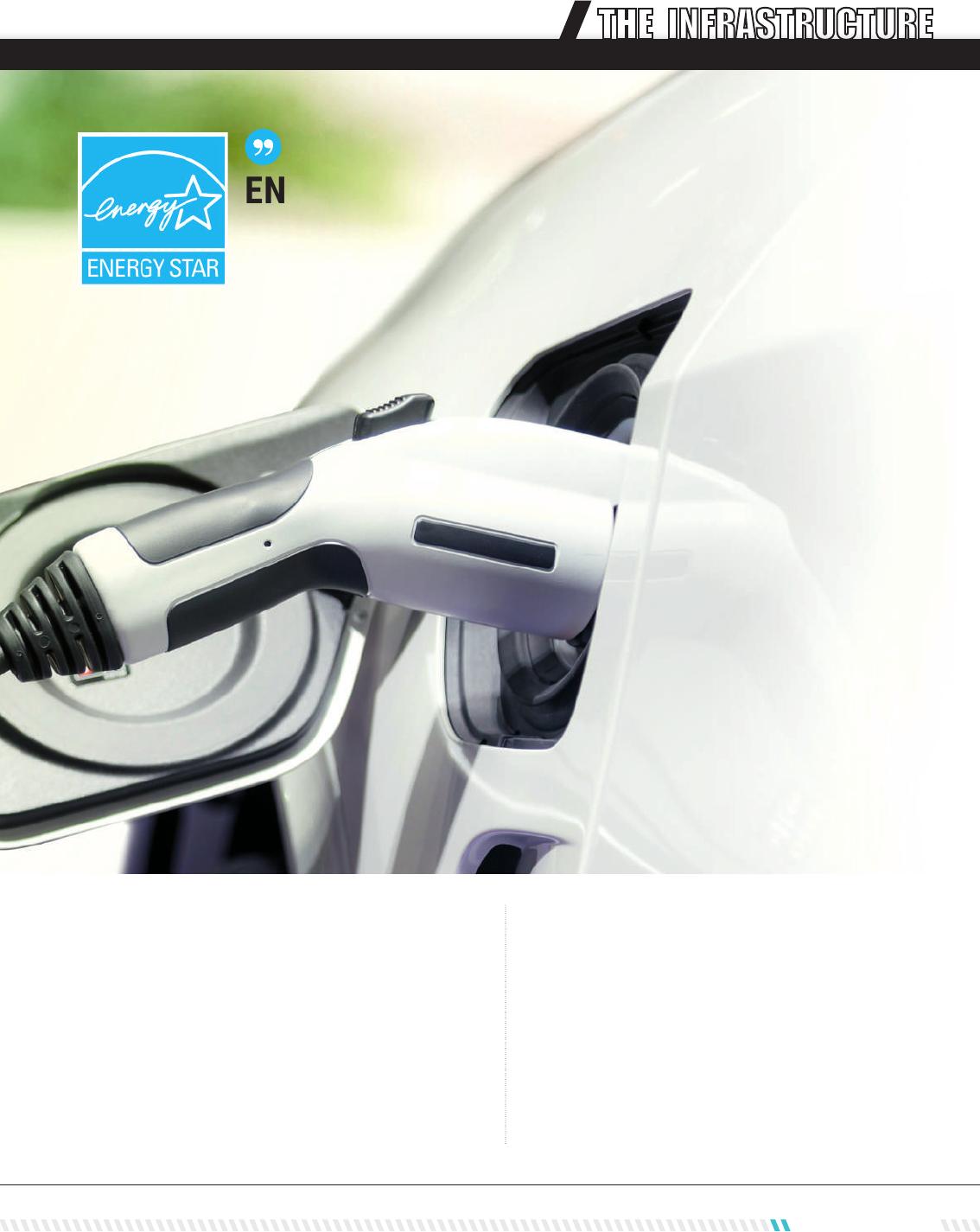
ENERGY STAR-certified charging stations
use 40% less energy in standby mode, on
average, than standard stations.
JAN/FEB 2018 65
THE INFRASTRUCTURE
Two types of charging stations are currently eligible
for the ENERGY STAR label - Level 1 and Level 2 AC.
ENERGY STAR-certied charging stations reduce
energy waste in several modes of operation: when the
vehicle is not present (No Vehicle Mode) and when the
vehicle is connected but is not receiving energy (Partial
On Mode and Idle Mode). ese three modes encom-
pass the times when the EVSE is not actively charging
a vehicle. e Idaho National Laboratory (INL) esti-
mated that a Level 1 charging station is in one of these
three modes for about 85% of the time. For Level 2 sta-
tions, INL estimated that a typical model is in one of
these three modes for an even greater amount of time.
As a result, ENERGY STAR-certied charging stations
use 40% less energy in standby mode, on average, than
standard stations.
Some ENERGY STAR-certied EVSE oer con-
nected functionality. e models that contain this
feature are capable of supporting demand response (via
soware updates or integration with external services)
through open communication protocols, providing op-
portunities such as load dispatching, ancillary services,
price notication, and price response for utilities, and
potentially additional monetary savings for purchasers.
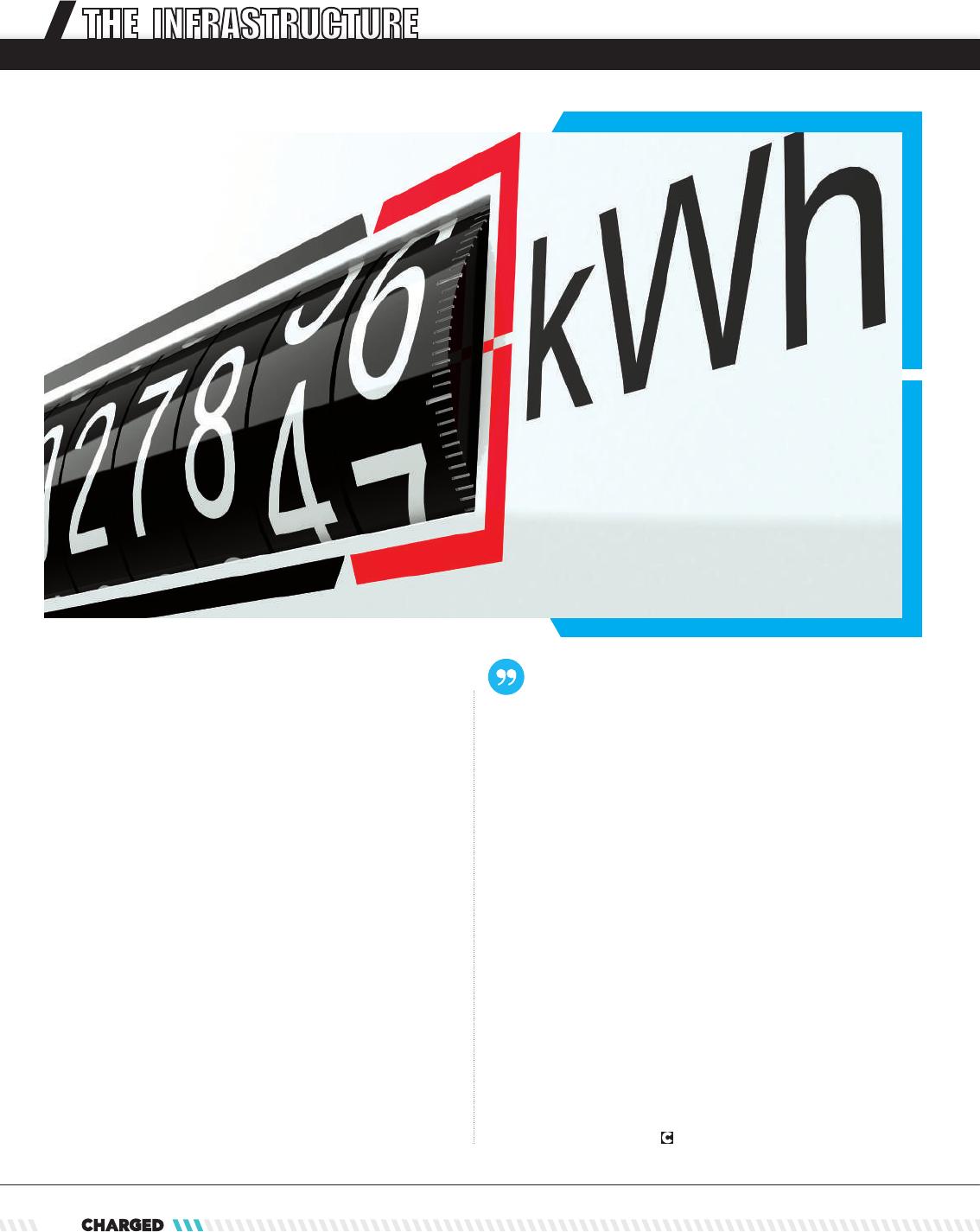
66
through its California Electric Vehicle Infrastructure
Project, just announced that all equipment qualifying
for funding must be ENERGY STAR-certied.
e EPA has plans to expand the scope of the EN-
ERGY STAR program in the future - it is now begin-
ning the process of adding DC fast charging stations
to the list of qualied products. Doing so will require
the development of a new procedure for testing and
measuring the power consumption of DC fast chargers.
e agency would appreciate any stakeholder feedback
and data relevant to the development of ENERGY
STAR eciency requirements for DC fast chargers.
Please contact us at evse@energystar.gov to receive
updates on this eort.
All ENERGY STAR models must also meet electrical
safety requirements.
To earn the ENERGY STAR label, EVSE perfor-
mance must be independently certied based on
testing in an EPA-recognized laboratory. For the EVSE
purchaser, ENERGY STAR certication identies the
models that save energy and money over the lifetime of
the product. Future savings from ENERGY STAR-cer-
tied charging stations are expected to grow to more
than $17 million by 2026.
e EPA maintains a web site where potential
purchasers and industry professionals can learn more
about certied products. For example, all ENERGY
STAR-certied products and their features can be
viewed using the Product Finder. is tool allows users
to compare the characteristics and features of dierent
products to determine which energy-saving product is
best for their needs. e list includes a mix of residen-
tial and commercial EVSE models that have qualied
for the ENERGY STAR label. EPA expects the list
of certied products to grow in the coming months,
especially since the California Energy Commission,
THE INFRASTRUCTURE
The EPA is now beginning the
process for adding DC fast
charging stations to the list of
possible qualified products.
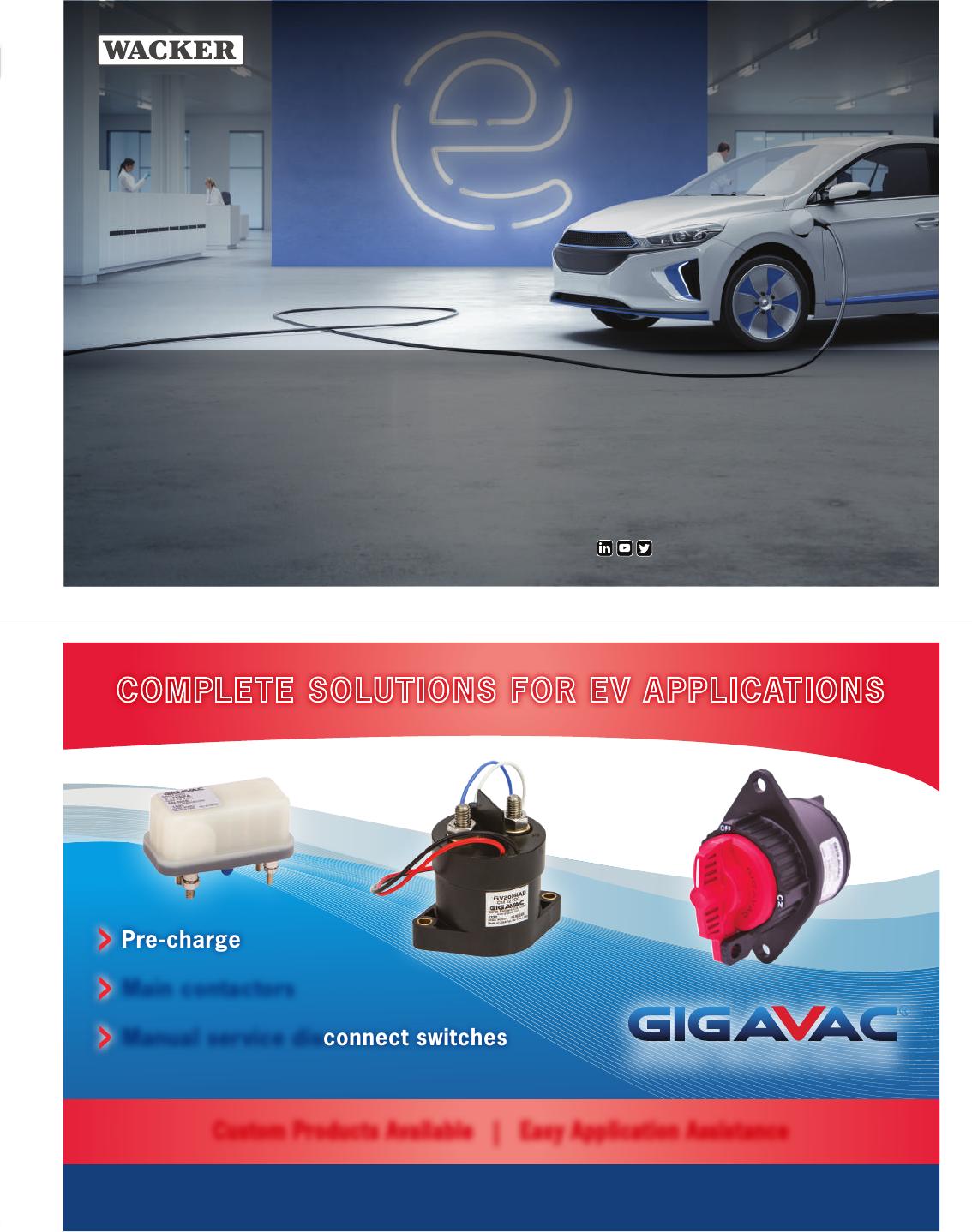
Run
Run
DRIVING TOMORROW’S e-NOVATION:
SILICONE – MATERIAL OF CHOICE
FOR e-MOBILITY APPLICATIONS.
CREATING TOMORROW’S SOLUTIONS
WACKER is a world leader in developing silicone products enabling the electrification of automotive platforms.
Our products can be found protecting sensors, electronic control units, power conversion equipment, batteries and
displays. WACKER’s broad product portfolio covers:
• Potting gels for protecting sensors to next-generation SiC power modules to battery modules
• Multiple adhesive technologies for sealing
• Thermally conductive silicones to meet ever-increasing heat loads
• Optically clear resins for display bonding and sealing
Wacker Chemical Corporation, 3301 Sutton Road, Adrian, MI 49221, USA
TEL: +1 888 922 5374, www.wacker.com/emobility, info.usa@wacker.com
WACK-546
WACK1809_7x4.685_546.indd 1 1/10/18 10:59 AM
COMPLETE SOLUTIONS FOR EV APPLICATIONS
Pre-charge
Main contactors
Manual service disconnect switches
+1-805-684-8401 | info@gigavac.com | www.gigavac.com
ADVA NCED S WITCHING SOLUTIONS
Custom Products Available | Easy Application Assistance
ChargedEV_AD_5-25-17.indd 1 5/25/17 11:00 PM

By Paul Beck
ince EV charging company EVBox was
founded in the Netherlands in 2010, it has
grown to see its charging stations in over
30 countries around the world, powering
nearly 1,000 cities. “On a global level, we have more
than 50,000 connected smart charging stations. We
have the largest installed base worldwide,” EVBox CEO
Kristof Vereenooghe told Charged.
e company is continuing to expand its electric
charging empire, and the US is next on its list. EVBox
has been in the US since 2017, selling a commercial
EV charger called the BusinessLine, and has recently
S
THE CHARGING MARKET
IN EUROPE
AND THE US:
EVBOX
EXPLAINS THE DIFFERENCE
68
announced a new charger tailored specically for the
American market.
e new Level 2 charger was designed based on
EVBox research in California, the hotspot of EV tech-
nology in the States. Speaking with EV drivers, charger
installers, facility managers, and other EV stakehold-
ers, EVBox thinks it has nailed down a few key dif-
ferences between Americans and Europeans when it
comes to EVs.
“is Level 2 charger is a new product that we have
developed, but it takes into account the needs of the
American market in mind,” says Vereenooghe.

JAN/FEB 2018
69
THE INFRASTRUCTURE
Image courtesy of EVBox
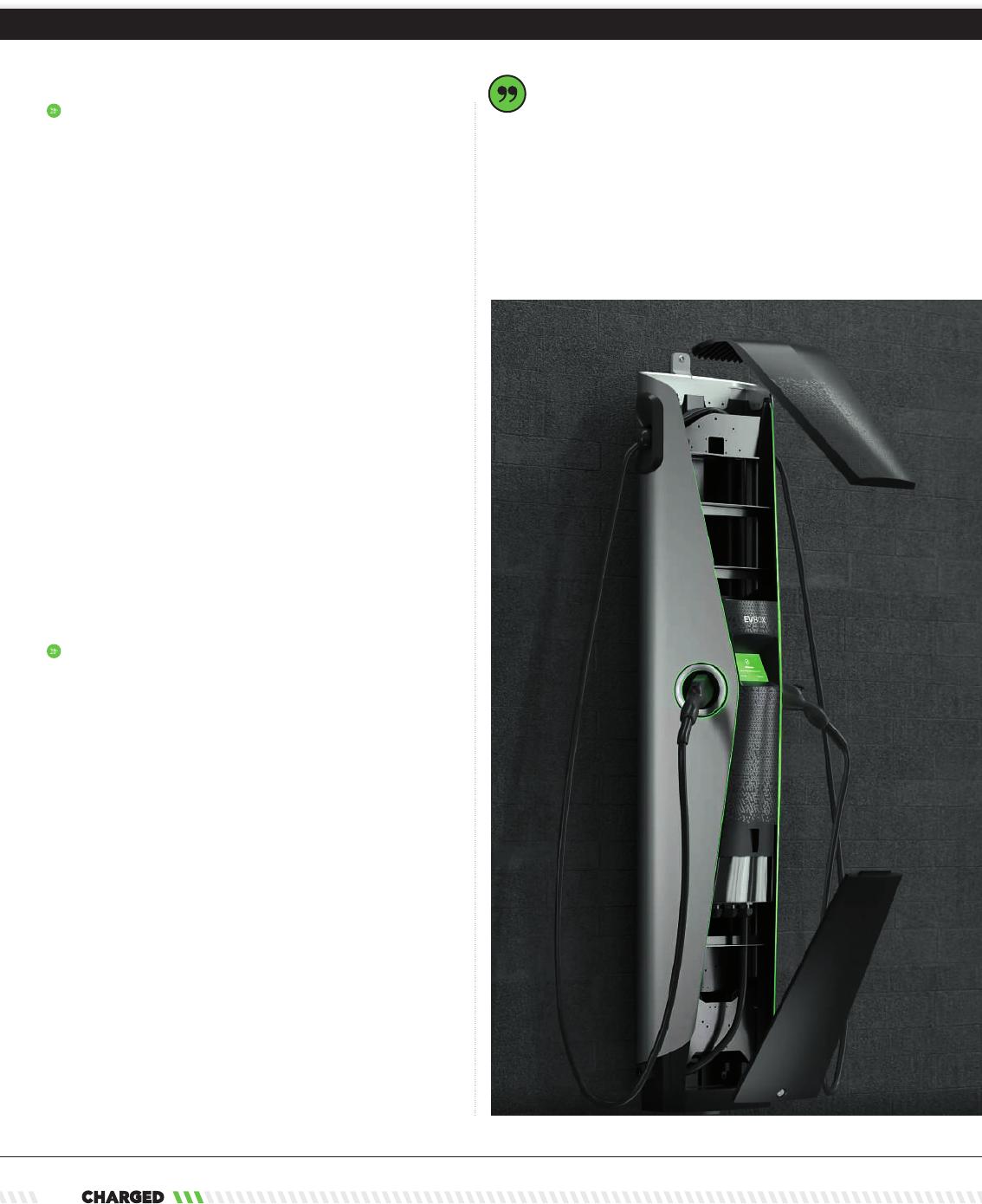
I always say we had the unfair
advantage that we started EVBox
in the Netherlands, which is still
one of the most developed EV
and EV charging countries.
70
Chargers from Amsterdam
“I always say we had the unfair advantage that we
started EVBox in the Netherlands, which is still one of
the most developed EV and EV charging countries,”
says Vereenooghe.
e Netherlands is ahead of the curve when it comes
to EV charging because of a decision made by the
Dutch government at the turn of the decade. Recog-
nizing the chicken-and-egg problem - no EV infra-
structure means no EV drivers, and vice versa - the
government decided to support the building of public
EV infrastructure. It began this project by testing four
dierent charger vendors - EVBox among them - with
the stipulation that these manufacturers work with
open standards from day one.
“And so from the early days, in 2010-2011, the gov-
ernment, together with EVBox and relevant partners,
had already put charging infrastructure in place in
cities like Amsterdam, Rotterdam, and others,” Ver-
eenooghe explains. “And they measured the heartbeat
of the stations every een minutes, on uptime, on
total cost of ownership, etc. Aer a couple of years they
gured out that we were very happily over-performing
compared to the other vendors. More than twice as
good as the number two.”
The two sides of the pond
With its advantageous origin on the far side of the
Atlantic, EVBox has a good handle on what Europeans
expect in their EV chargers. But what about Americans?
Let’s start with the technical dierences. “In the US
it’s one phase or split phase, and in Europe it’s either one
or three phase,” explains Vereenooghe. “So we go from
3 to 7 to 11 to 22 kilowatts in Europe. In the US most
vehicles charge at 7.4 kW or less.”
From there, the dierences begin to take on a more
cultural tone. In the US, bigger is typically better, and
EV chargers are no exception. “In Europe people like to
have smaller types of products, traditionally they prefer
a smaller physical design that blends with the envi-
ronment,” says Vereenooghe. “In the US we nd that
customers desire robust chargers that stand out and give
visibility to the location.”
“In America there’s more space in general, and people
are used to it,” he says. “American drivers enjoy driving
big pickups, trucks, SUVs - in general you see more big
vehicles on US roads than in Europe. And this percep-
tion of bigger size also inuences design and the percep-
tion of how a charging station should look.”
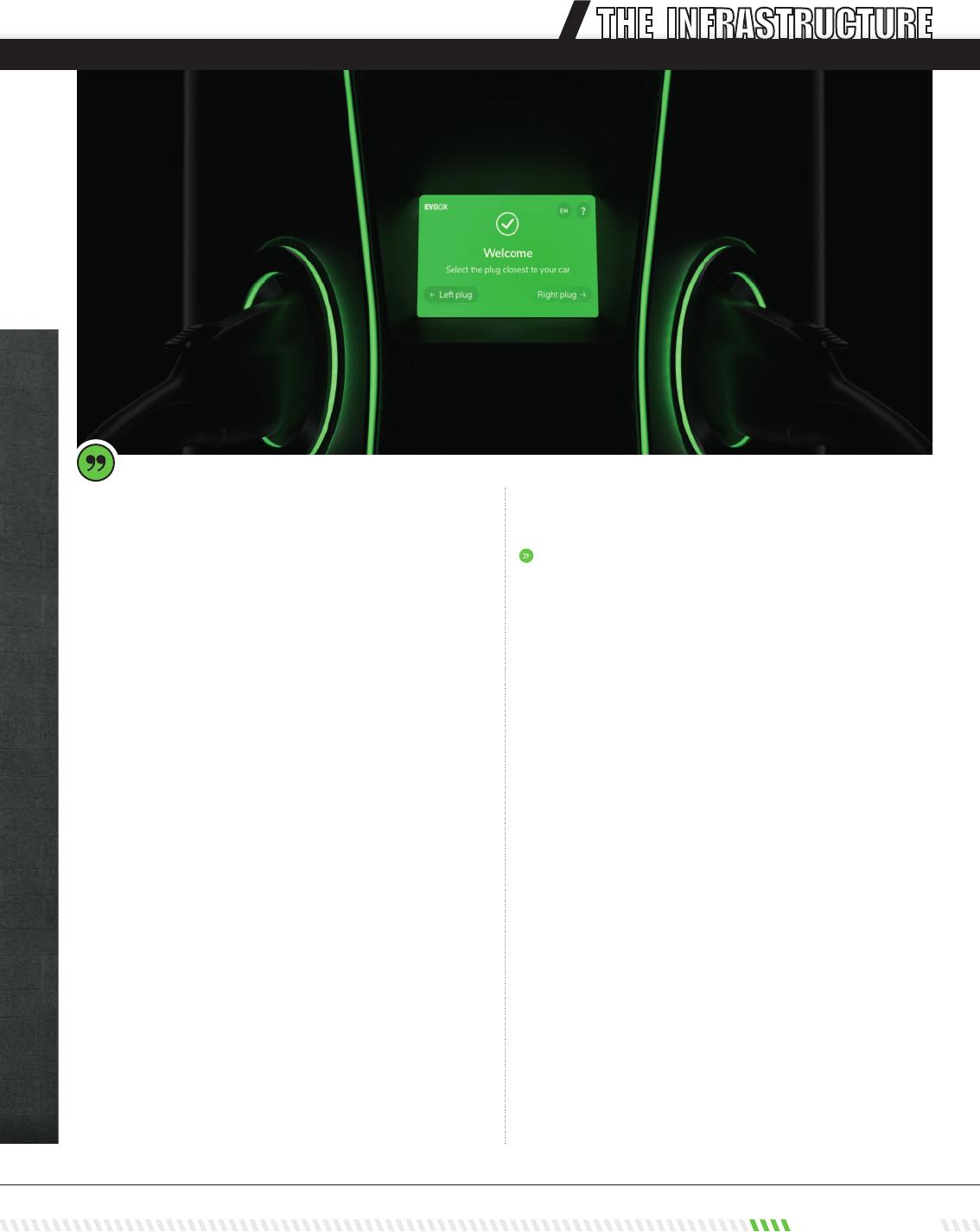
JAN/FEB 2018
71
charging stations on the street, it’s more about home
charging, workplace, and retail charging.”
Smart charging before it was cool
One explanation for these dierences is a market seg-
ment that’s quite popular in Europe: leased company
cars. “Most of the people that drove EVs at the begin-
ning, they were driving company lease cars,” explains
Vereenooghe. “In Europe, people very oen get a little
bit less salary, but they get a company car.”
For this reason, EV chargers in Europe had to be
smart from the very beginning.
“Because we use smart charging infrastructure, we
know exactly how much energy you consumed to charge
your specic car. Our soware platform will automati-
cally pay the private individual at the end of the month
for his home consumption to charge his company car.
en we bill the employer or leasing company not
only for that consumption at home, but also for all the
other charging sessions that he did across Europe. At a
supermarket, at a restaurant, I mean wherever. It’s all
combined into one bill,” says Vereenooghe.
“So the whole infrastructure is in place, and it’s fully
automated through a cloud soware platform,” he
continues. “And we’ve done it already for six years. Same
with smart charging. I mean today, smart charging is
becoming a hot topic here in the US, but let me tell you,
we did it before the denition of smart charging existed.
I mean since 2010, 2011, we’ve already taken care of
load balancing and peak shaving and all those kinds of
things. So it’s already embedded in our systems and in
the soware platforms for many years.”
e biggest dierence between American and Eu-
ropean EV drivers has to do with the reasons people
choose to drive EVs in the rst place. In the US, EVBox
believes the primary motivation that will trigger mas-
sive adoption will be cost. In Europe, it will be concern
for the environment. is dierence manifests itself in
the dierent models of EV charging between the two
continents.
ese days in the US, EV charging is seen more as a
business opportunity. Tesla continues to aggressively
install its proprietary chargers as a competitive advan-
tage, charging networks are expanding their reach with
various automotive partnerships, utility companies are
getting into the game for obvious reasons, and com-
mercial property owners are installing EVSE in their
parking lots for employees and customers.
“In contrast, countries like e Netherlands have ex-
tensive public charging infrastructure available,” Veree-
nooghe explains. “If you walk the streets of Amsterdam
and some other cities in Europe, in every street you’re
going to nd charging infrastructure where people who
are parking in the street can actually charge their car,”
says Vereenooghe. “at’s something that does not exist
as much in the US. In the US, people don’t park their
cars that much on the street, so you’re not going to nd
THE INFRASTRUCTURE
Images courtesy of EVBox
In the US we find that
customer desire robust
chargers that stand out and
give visibility to the location.
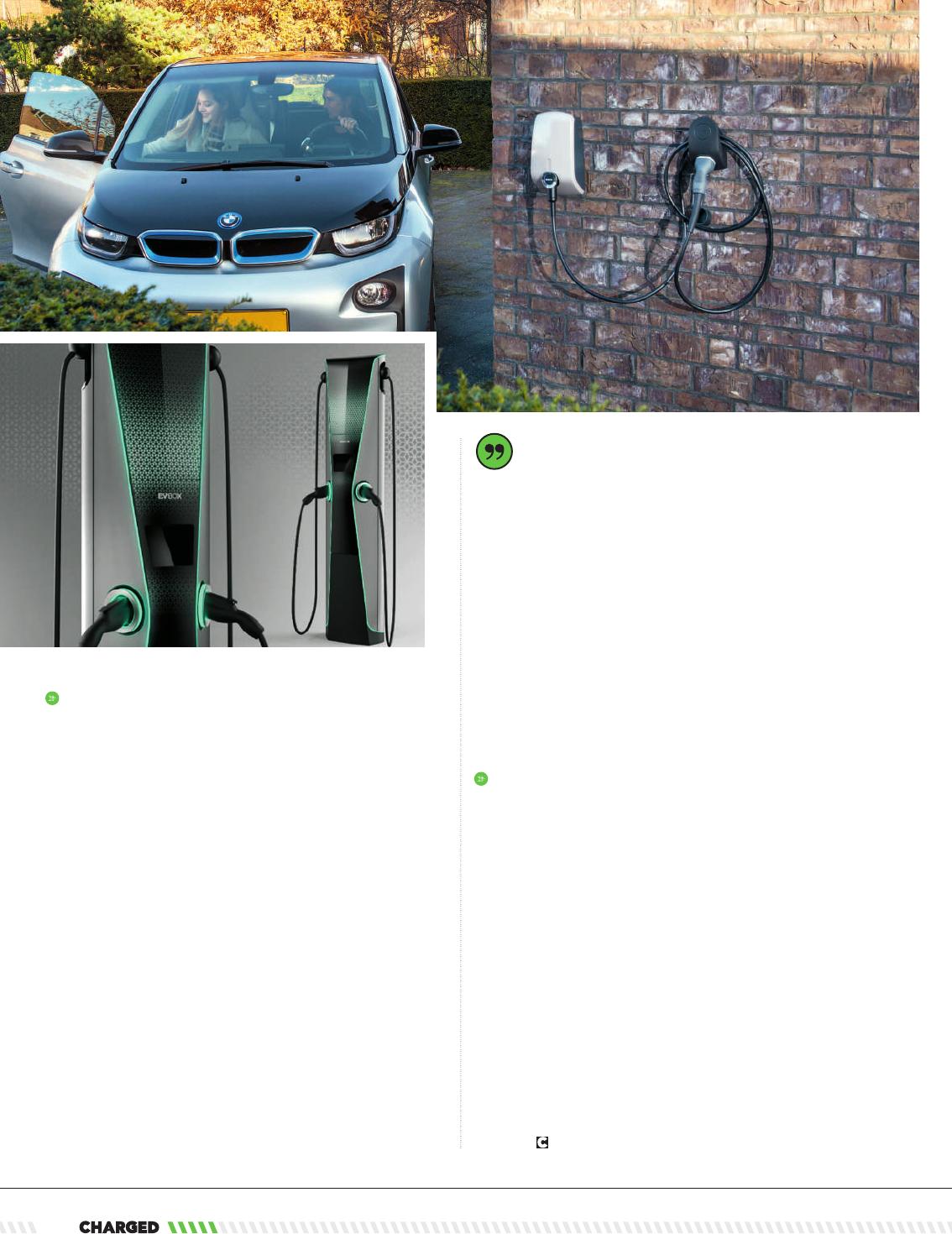
72
the future, we will continue to do that for products for
the US market - made by Americans for Americans.”’
For home charging, EVBox’s recently launched Elvi
- a CES Innovation Award Honoree - which will be
available within the rst half of this year.
A true international player
EVBox’s interest in expanding its American presence is
subsumed by its interest in bringing its formidable EV
chargers to the global market. According to Veree-
nooghe, the company has been very successful in this
regard.
“If a corporation needs one player to take care of its
charging infrastructure, we can do it from Sydney to
Singapore to Alaska to Chile, wherever in the world
they need it,” he says. “e engineering and R&D
development is centralized in Amsterdam, which the
industry calls the ‘eMobility Valley’ of the world. Only
our manufacturing is done on the continent where we
sell and service the product. So our European products
are manufactured in the Netherlands, and the ones for
the US are manufactured in the US. We think it’s very
important to act as a local company in each country
where we have presence. We’re a true international
player.”
The new Level 2
EVBox’s new Level 2 charger builds on the company’s
considerable EV experience, but is optimized for use
in the US. e new charger’s modular design is made
for easy installation and scalability, allowing facil-
ity managers to add and upgrade as they see t. e
charger is also highly customizable, so businesses can
personalize it with their own branding. Each charger
can charge two vehicles at once at 7.4 kW; by installing
two chargers back-to-back, as Vereenooghe notes is
oen done, you can double the capacity of a station to
four cars. And the rugged design of the new charger is
sure to appeal to American tastes.
ough the new charger was announced this January
at CES, it won’t be commercially available until early
next year. According to Vereenooghe, the company is
working on scalable production of the charger, which
is still in the midst of the certication process. In the
meantime, Americans can purchase the EVBox Busi-
nessLine charger.
“Our BusinessLine is a product that EVBox is well
known for, and we manufacture that in our assembly
facility in the US as well,” says Vereenooghe. “And in
If a corporation needs one
player to take care of its
charging infrastructure, we can
do it from Sydney to Singapore
to Alaska to Chile.
Images courtesy of EVBox
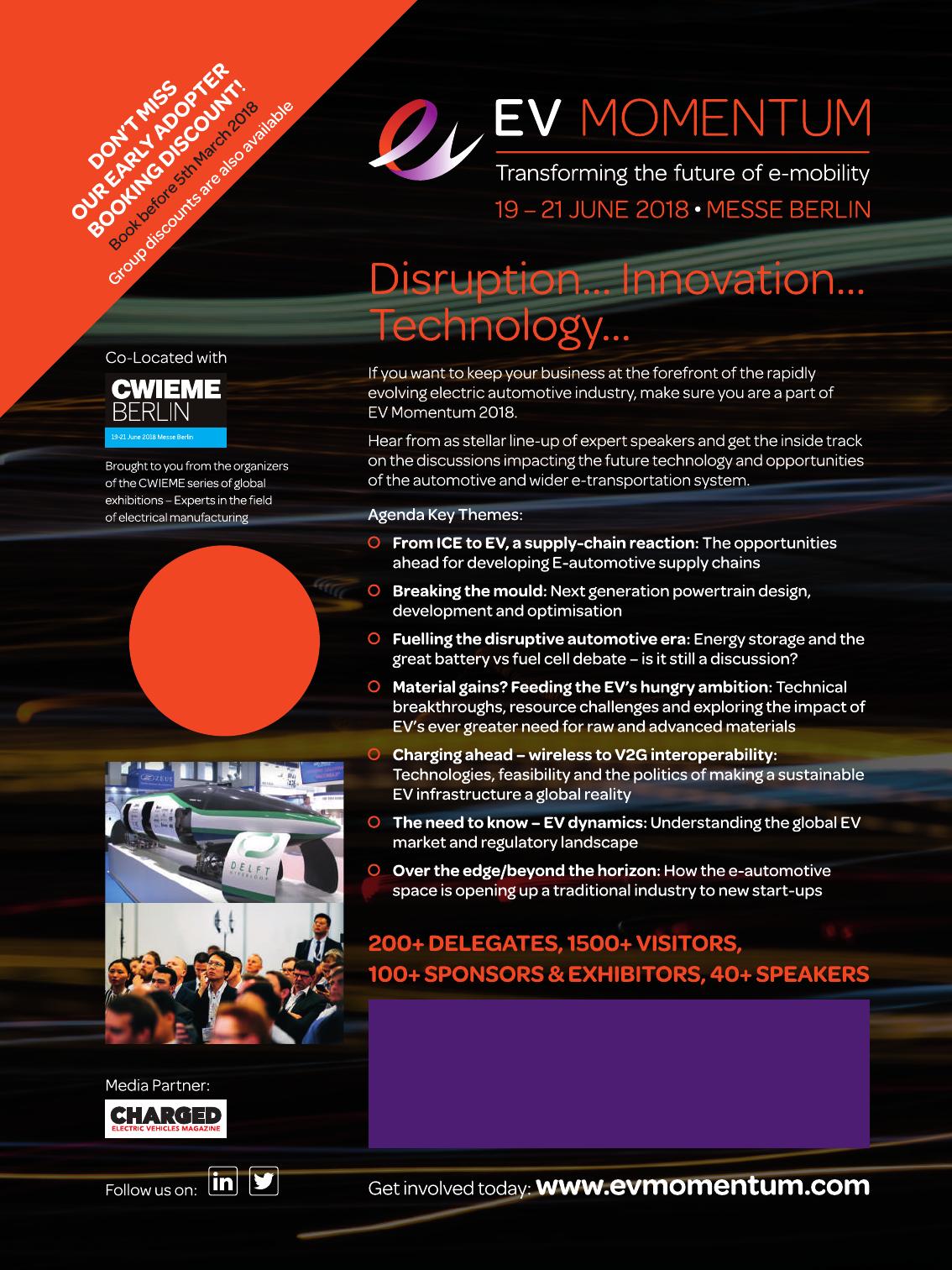
SPONSORSHIP
& EXHIBITION
OPPORTUNITIES
NOW AVAILABLE
VISIT WEBSITE FOR
MORE DETAILS
Meet automakers, manufacturers (including all major
OEMs, electric motor and component manufacturers),
visionaries, suppliers and game changers.
Join us at EV Momentum 2018 and help us transform
the future of e-mobility!
EV_Advert_290118.indd 1 29/01/2018 16:55
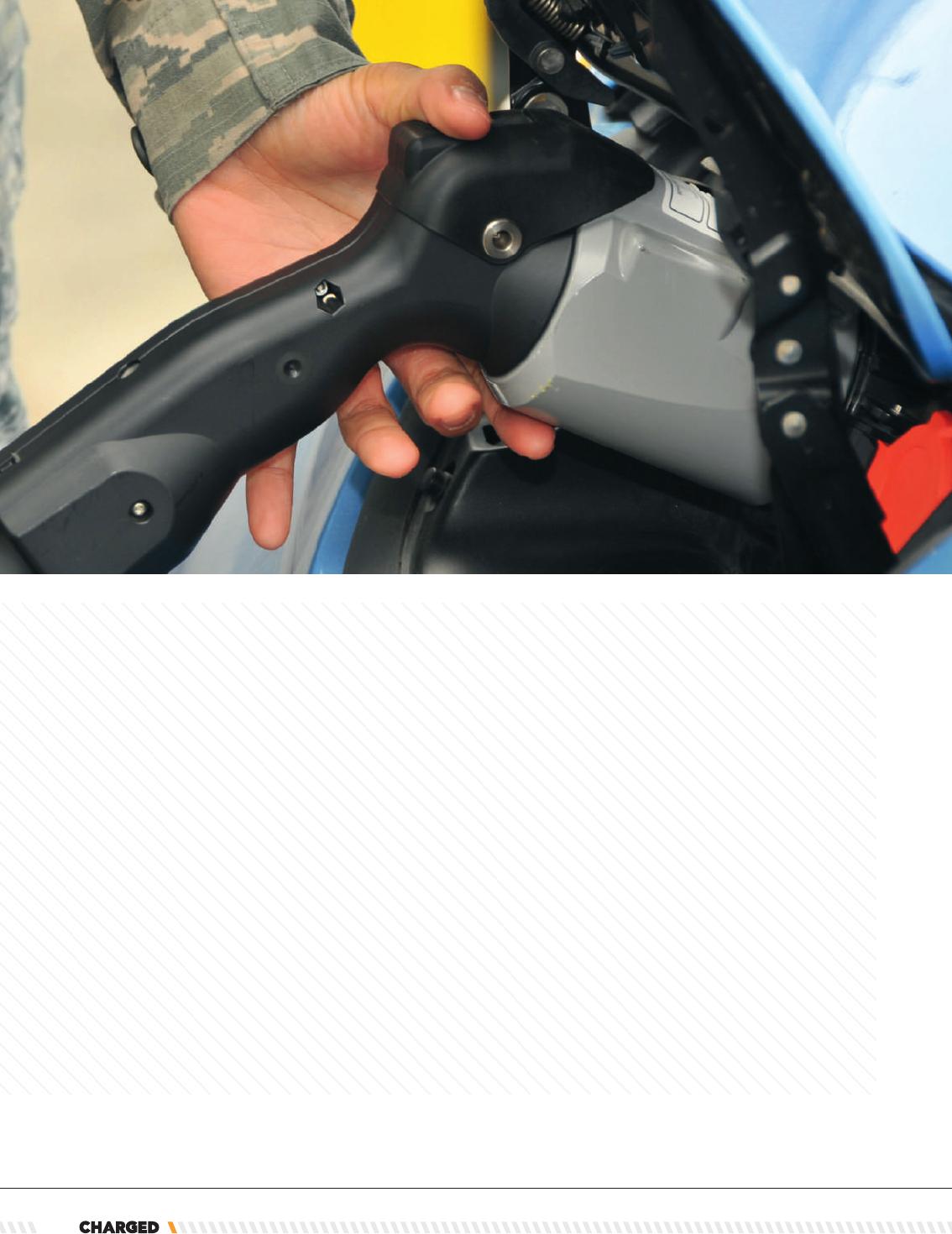
VEHICLE-TO-GRID
PROJECT REVEALS
CHALLENGES
74
OF THE EARLY DAYS
By Tom Ewing
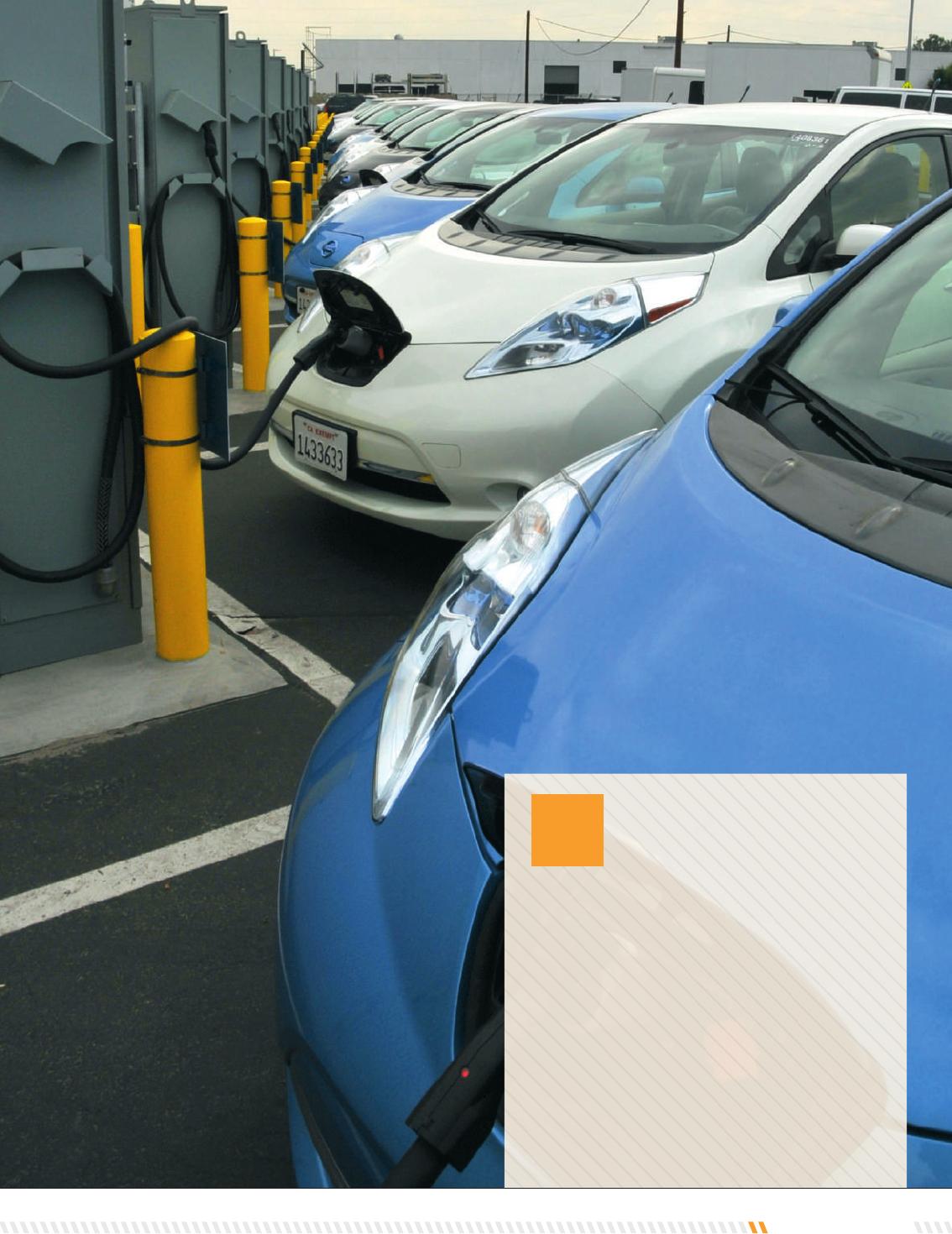
JAN/FEB 2018 75
ehicle-to-grid (V2G) is a technical
and policy-based eort to optimize
the way EVs interact with the electri-
cal grid. V2G developers view EVs as
“resources” within an electrical network. In V2G
literature, the word resource is oen used instead
of cars or vehicles.
e notion of a resource is based on the idea
that a vehicle linked to a charger can (and
should) do more than just take on fuel. At night
or during the work day, the car’s battery can
store power when overall electrical demand is
low but wind and solar facilities are generating
inexpensive power. When demand and genera-
tion shi, the battery can send power to the grid,
osetting the need for additional generation.
EVs can also provide ancillary services, helping
to regulate the stability of the grid.
V
Photos courtesy of Los Angeles Air Force Base
Los Angeles Air Force Base
became the first federal facility to
replace its entire general-purpose
fleet with plug-in vehicles in a
two-year V2G research project

76
Obviously, such benets will not be delivered by just
one EV, perhaps not even by 1,000 or 10,000. But even-
tually, it’s expected that a grid/EV dynamic will develop
that is dependable and mutually benecial for vehicles
and the network.
Also obviously: this ain’t easy. Right now, V2G is still
pretty theoretical. It could happen, if…
California, as in all things EV, leads in V2G research.
For state policymakers, V2G is a must, not a want,
required by Governor Brown’s Executive Order B-16-
2012, which directs that “electric vehicle charging will
be integrated into the electricity grid” by 2020, less than
two years away. Policymakers need this working sooner,
not later.
In December, a major V2G research project concluded
in California, closely watched because of its scope and
its utility market interaction. e project, which ran
from October 2015 to December 2017, was a partner-
ship between Southern California Edison (SCE) and the
Department of Defense (DOD), specically Los Angeles
Air Force Base, part of a $20-million DOD research
investment. e base became the rst federal facility to
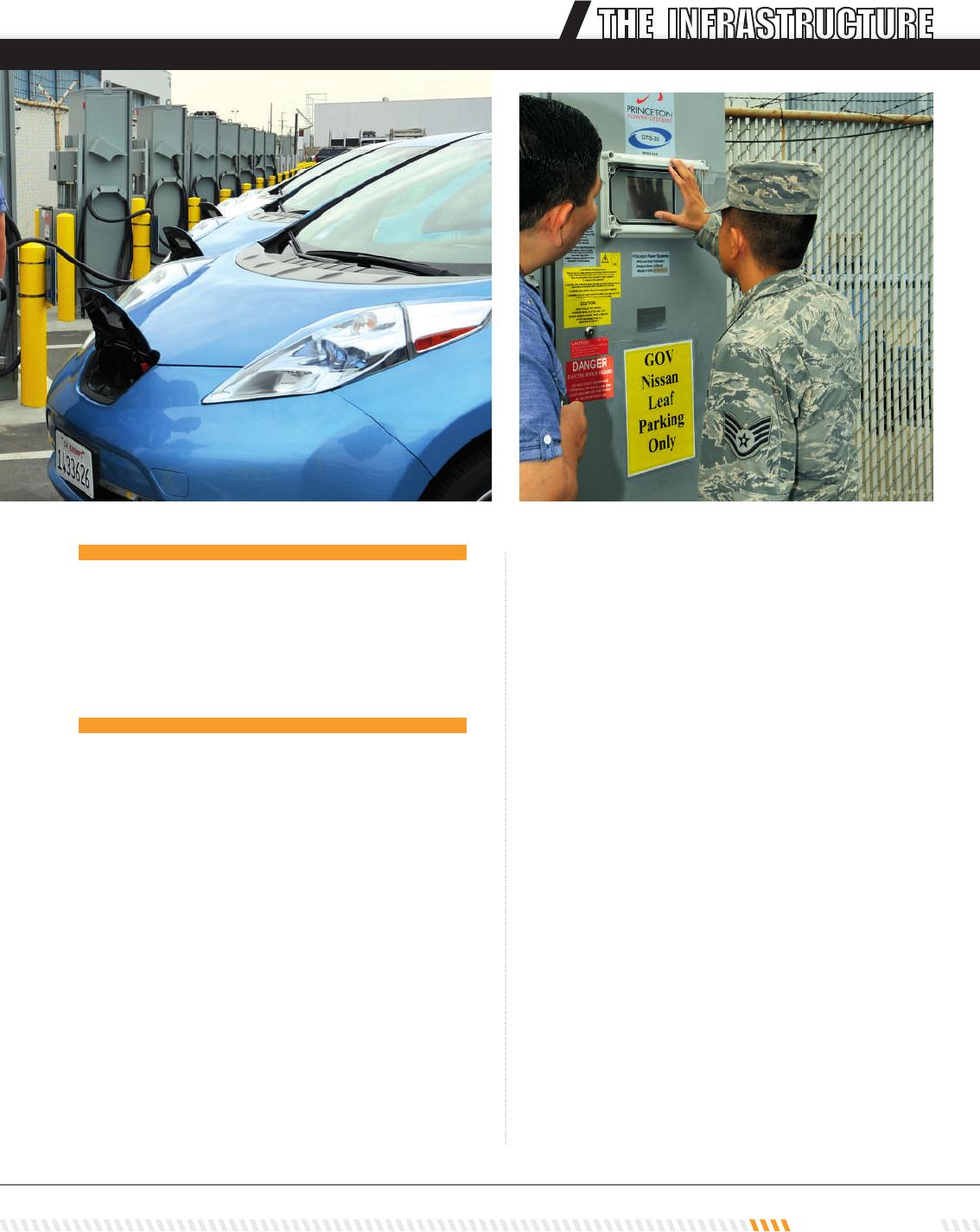
JAN/FEB 2018 77
replace its entire general-purpose eet with 41 plug-in
vehicles, including automobiles, pickup trucks and a
passenger van.
In December, SCE led its V2G report with the Cali-
fornia Public Utilities Commission. SCE calls the project
successful because the work supported “a pioneering cus-
tomer in the direct participation space.” SCE writes that
“the greatest accomplishment of the V2G Pilot is that it
has paved the path for smaller resources to participate in
the ancillary services market going forward.” On its web
site, SCE writes that a successful pilot could be the “proof
of concept” that helps establish the viability and scalabil-
ity of V2G technology.
From SCE’s December report, viability and scalability
seem to advance somewhat, but unevenly - the phrase
“bits and pieces” comes to mind. SCE’s report makes it
hard to assess how much this project (pardon the sports
metaphor) moved the ball - 3 yards, 30 yards, or perhaps
even close to the goal line.
SCE and Air Force engineers
started almost from scratch,
expending a lot of effort just
to get to the work at hand.
One thing is certain: the project required a lot of
remedial work. SCE and Air Force engineers started
almost from scratch, expending a lot of eort just to get
to the work at hand. SCE and the Air Force repeatedly
confronted challenges which, taken together, belie any
notions that V2G is at the almost-ready stage. SCE writes
of shepherding “the pilot through myriad testing, quali-
cation and participation wickets.”
For example, engineers hoped to take advantage of
V2G work from the University of Delaware (UD), work
that was favorably referenced among V2G proponents.
It turned out, though, that UD’s components were
proprietary, and couldn’t be used for the new project.
Furthermore, UD communications protocols did not
comply with SAE standards. Surprisingly, UD’s inverter
was not utility-certied, something which is required
throughout the US. In sum, UD’s work didn’t provide
any advantage for SCE/Air Force. is is more than
disappointing, and it’s not only about technology. V2G’s
success depends on an open, common body of knowl-
edge - secrets are a setback.
Another unexpected problem: even in California,
there were no commercially available vehicles and
electrical supply hardware, other than for the Nissan
LEAF, capable of meeting all of the tasks and functions
required by the project.
e project started with the Nissan LEAF, a bus from
Phoenix, and trucks from EVAOS, EVI and VIA Motors.
None of the equipment could pass initial testing in its
THE INFRASTRUCTURE
Photos courtesy of Los Angeles Air Force Base
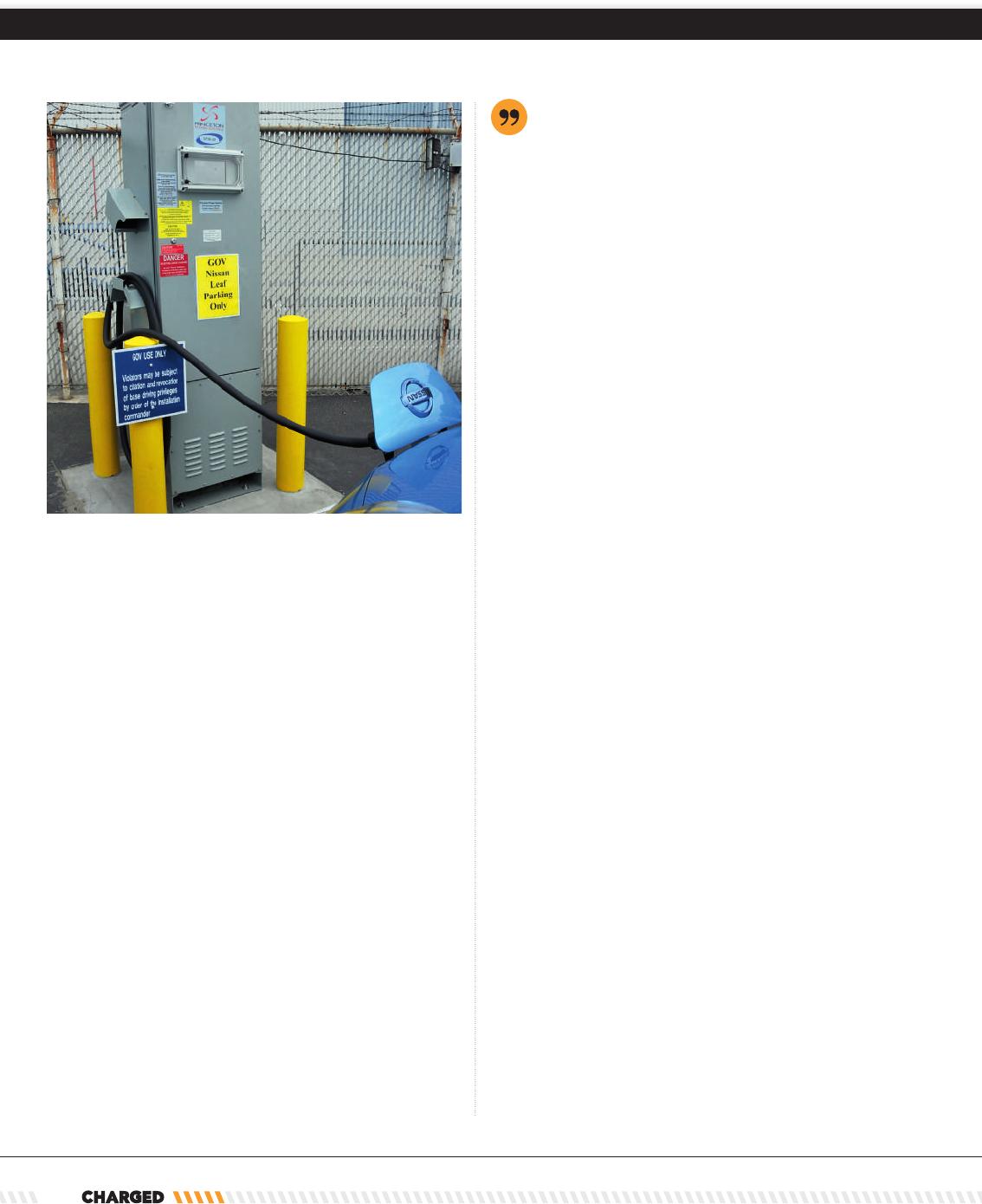
78
manufactured conguration. Issues included, but were
not limited to: limited charger functionality; standby load
that was higher than SCE’s recommendations for charg-
ing infrastructure; heavy parasitic loads that reduced the
reliability of the vehicles; and inverter issues. Each vehicle
had to be recalibrated and all compliance and functional-
ity issues readdressed. Interestingly, the manufacturers
couldn’t perform the requisite tests, which eventually took
over two years. SCE expected testing to take six months.
In fact, the trucks were never used - they were shipped
to Texas. at le 29 vehicles - a somewhat puny eet, in
retrospect, considering this was supposed to be the largest
V2G project in the world. Among the vehicles, quality
and performance issues were troubling. Some vehicles
that passed the certication test in October 2015 were no
longer reliably operational just one year later.
One important project goal was to show that EVs
could participate in CAISO’s wholesale market. (e
California Independent System Operator is the entity
that organizes and oversees generation and transmis-
sion within multiple utility service areas.) SCE calls
this a success: “e Pilot was successful in providing
frequency regulation to the CAISO market for a total of
243 MWh of Regulation Up and 102 MWh of Regulation
Down from May 2016 to September 2017.” (Up/Down
refers to receiving or sending power from or to the grid.)
However, market interaction had problems. e
vehicle eet could not provide accurate information to
CAISO. is impacted day-ahead market awards, and it
impacted vehicle performance because it’s related to bat-
tery issues. New tools are needed, SCE writes, to auto-
mate energy bidding but still track power. Consequently,
the Air Force had to reduce the number of hours its
vehicles were in the market, a move completely contrary
to V2G’s potential benets.
It’s important to note that a eet presents dier-
ent V2G characteristics than do individual EVs. e
Air Force’s eet needed to be ready on demand, which
conicts somewhat with the idea of using an EV as a
grid resource. An individual EV owner would likely take
advantage of a more predictable V2G schedule, staying
connected at night, for example, or during the workday
when the vehicle is parked.
ere were other challenges. Communication so-
ware didn’t work, which meant the vehicles’ market
performance wasn’t stabilized until early 2017. Prob-
lems compounded: CAISO had to decertify some of
the EV resources from certain activities because of
inaccurate and insucient data. Again, a big hit when
thinking of EVs as assets.
e project used two communications standards:
Open Charge Point Protocol 1.5 (OCPP) and the SAE
Smart Energy Prole 2.0 (SEP2). ey didn’t work. It
took months for engineers to make corrections and build
new operating features. Some engineers questioned why
two standards were used, when one was likely sucient.
OCPP was chosen very early in the project’s development
by the DOE’s Lawrence Berkeley National Laboratory; it
was retained, even though engineers knew early on that
its performance was questionable.
e re-tooled soware got the job done. But again, to
what end? SCE’s report does not say whether these xes
just kept this particular project going or whether they
are the kind of advances that could lead to standard-
Photo courtesy of Los Angeles Air Force Base
The Pilot was successful in
providing frequency regulation to
the CAISO market for a total of
243 MWh of Regulation Up and
102 MWh of Regulation Down from
May 2016 to September 2017.
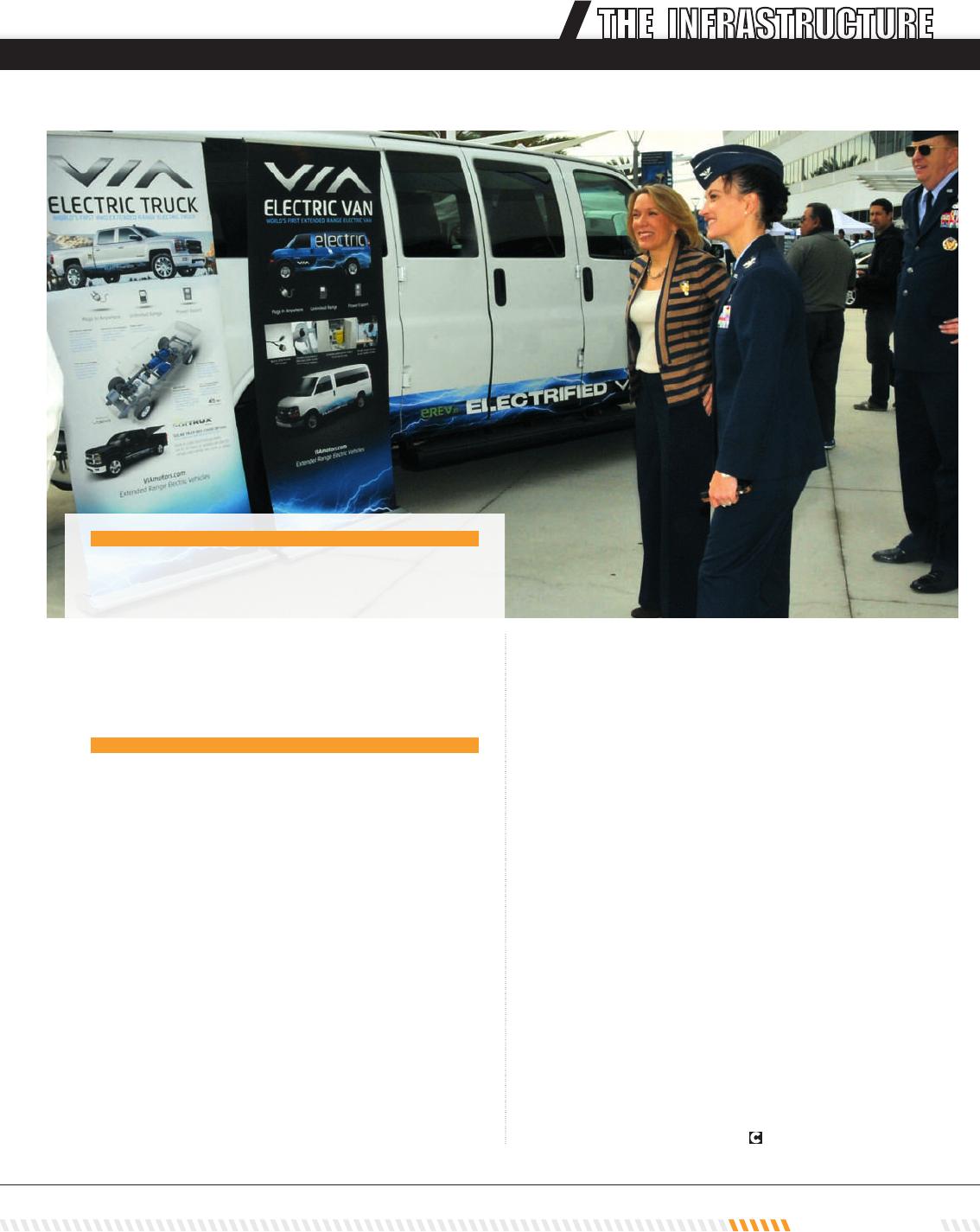
JAN/FEB 2018 79
fee of $216. e biggest hit was a $1,000 monthly fee for a
CAISO scheduling coordinator, a person certied to par-
ticipate in trades. In total, the project lost about $17,000.
SCE’s report suggests that the fees could possibly be
reduced by “utilizing a signicantly larger resource,” i.e.,
more EVs linked together, lowering the cost per vehicle.
How many vehicles would that be? SCE’s answer is a bit
of a riddle: “By ‘larger resource’ we mean more vehicles
included in an aggregation. e order of magnitude ques-
tion depends on the desires of the EV owners.”
CAISO’s $1,000/month charge took project planners
by surprise. When asked about the coordinator’s role,
SCE explained that “Scheduling coordinators deal di-
rectly with the CAISO for bidding, self-scheduling and
nancially settling participatory resources. In short, it
would be costly for each EV owner to be his or her own
scheduling coordinator. Scheduling coordinator ser-
vices can be purchased that would support aggregation
of many EV owners’ vehicles into a resource through
aggregation and thus share fees.” Obviously an issue
needing further attention.
DOD’s V2G work will continue, including testing
vehicle-to-building technologies. DOD will present its
own nal report in early 2018.
ized applications. When asked about a metric for prog-
ress, an SCE spokesperson said (via email) that “the
V2G pilot moved knowledge forward towards COTS
(commercially available o the shelf) products. Addi-
tional insight would need to come from the customer,
the Department of Defense.”
One reason that every electron needs to be accounted
for within a V2G system is because money is involved
- for the resource owner, the utility, ratepayers, taxpay-
ers, grid operators and new entrepreneurs who want to
provide services in “this direct participation space.”
Importantly, the Air Force did realize income from its
energy trades, despite the extensive communication-so-
ware problems. Revenue per vehicle ranged from $25 to
$72 per month, with an average of $41 per vehicle-month.
Aggregated gross revenue was $7,639. Unforeseen, how-
ever, were high monthly participation fees. SCE had to
charge a manual billing fee of $118 and a meter data feed
THE INFRASTRUCTURE
Photo by Sarah Corrice
Revenue per vehicle ranged
from $25 to $72 per month,
with an average of $41 per
vehicle-month. Aggregated
gross revenue was $7,639.
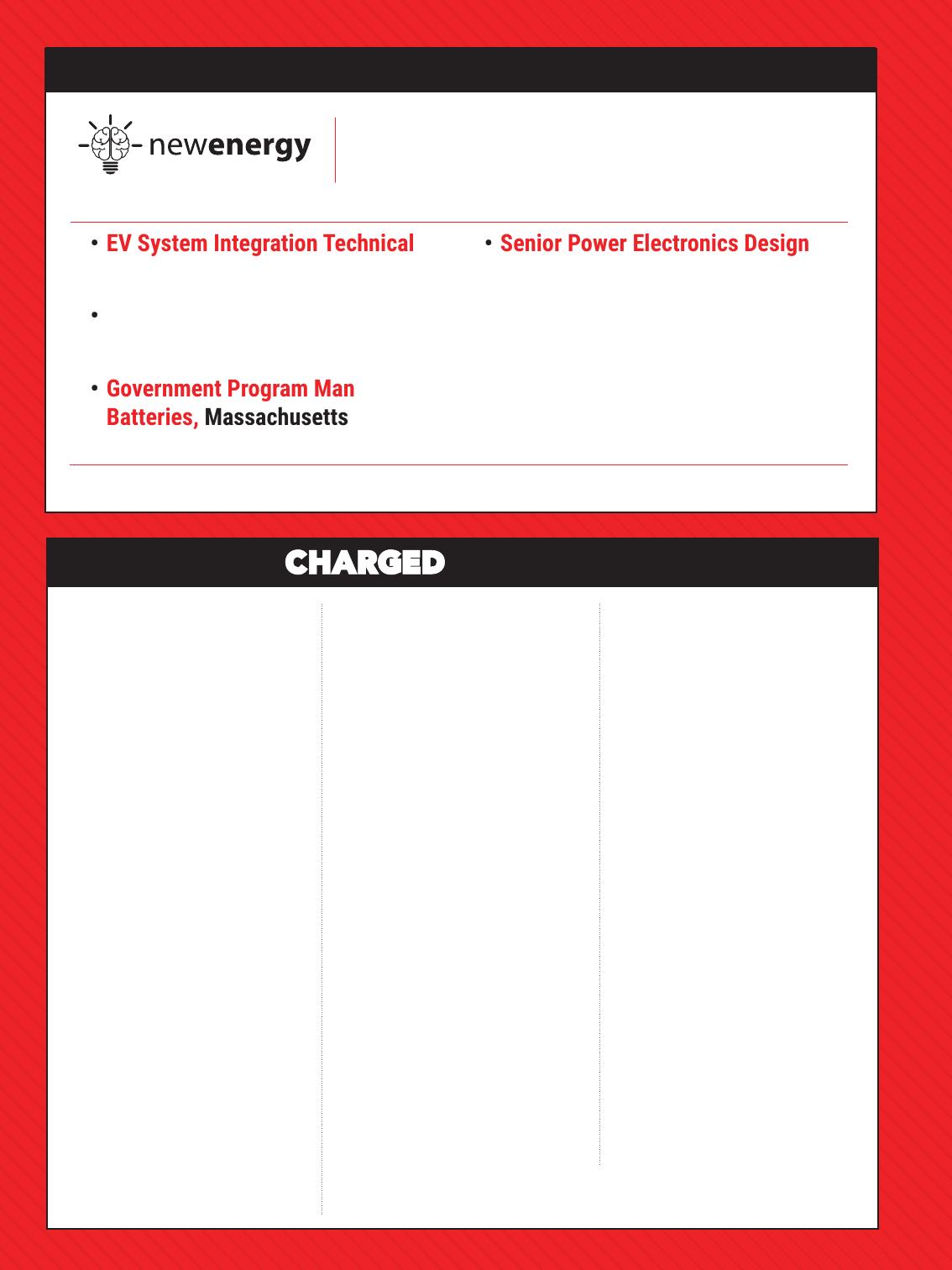
Advertiser Index
For more info about advertising visit: www.ChargedEVs.com/Advertise
ABB ....................................................... 5
abb.com/evcharging
Amphenol PCD Shenzhen ................... 53
www.amphenolpcd.com.cn
Arbin Instruments .............................. 10
arbin.com
APEC ................................................... 81
apec-conf.org
Bender ................................................ 15
bender-us.com
Bitrode ................................................ 19
Bitrode.com
BorgWarner ........................................ 27
Borgwarner.com
Caliente ............................................... 55
calientellc.com
Chroma ................................................. 2
chromausa.com
ClipperCreek ....................................... 41
Clippercreek.com
Efacec ................................................. 57
electricmobility.efacec.com
EV Momentum .................................... 73
evmomentum.com
EV Safe Charge ..................................... 8
evsafecharge.com
EV Tech Expo Europe ............................ 9
Evtechexpo.eu
F&K Delvotec ....................................... 41
Fkdelvotec.com
Gigavac ............................................... 67
gigavac.com
Hitachi Metals .................................... 45
www.hitachi-metals.co.jp/e/
Hongfa America ................................. 21
Hongfa.com
International Battery Seminar ............ 7
internationalbatteryseminar.com
Maccor ................................................ 13
Maccor.com
New Energy Stafng & Recruiting ..... 83
newenergystafng.com
NH Research ....................................... 37
nhresearch.com
Odawara ............................................. 13
Odawara.com
Outlast Technologies .......................... 53
Outlastlhs.com
Pi Innovo ............................................ 16
pi-innovo.com
Scheugenpug .................................... 11
scheugenpug-usa.com
Seal Methods ...................................... 17
sealmethodsinc.com
Semikron ............................................. 84
semikron.com/power-stacks.com
Synopsys ............................................. 59
synopsys.com/saber
Tecnomatic ......................................... 39
tecnomatic.it
UQM .................................................... 47
uqm.com
Wacker ................................................ 67
wacker.com/emobility
Wildcat Discovery Technologies ........ 37
wildcatdiscovery.com
Wolfspeed ........................................... 43
wolfspeed.com/power
New Jobs
• EV System Integration Technical
Advisor, California
• Battery Program Manager,
Massachusetts
• Government Program Manager,
Batteries, Massachusetts
• Senior Power Electronics Design
Engineer, Indiana
• EV System Performance Engineer,
Indiana
• And many more open positions
New Energy is the exclusive stang and recruiting partner of
CHARGED EVs Magazine.
Staffing & Recruiting Services
Now Hiring:
Apply Now: www.NewEnergyStang.com | Jobs@NewEnergyStang.com | (248) 382-8518

Run
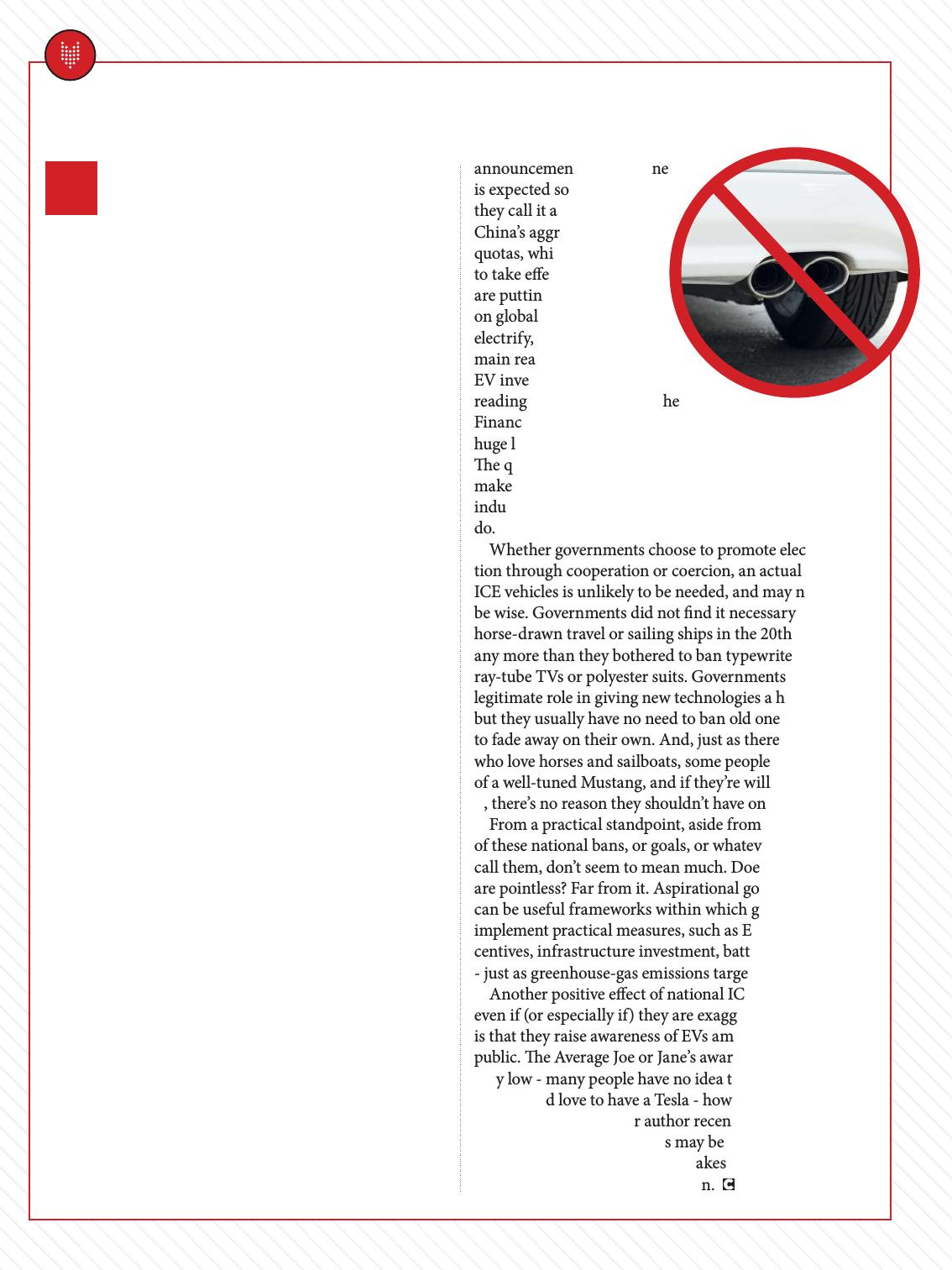
he mainstream press doesn’t always cover the
EV-related stories that those of us in the indus-
try would consider the most signicant, but the
recent spate of announcements by various governments
concerning an eventual phase-out of ICE vehicles has re-
ally caught the imagination of the world’s newspapers and
mass-market magazines.
Ocials in Norway, the Netherlands, France, India, the
UK and China, as well as a growing number of cities, have
all made statements to the eect that fossil-burners may
someday be phased out. e popular press has covered
these stories extensively, in many cases reporting that a
“ban” is imminent. What does all this really mean, and
how newsworthy is it?
e rst country to make headlines was (of course)
Norway, where some government ocials announced in
2016 that they were seeking to ban ICE vehicles by 2025.
In February 2017, long aer the press had run away with
the story, the government claried its intentions in an on-
line post: “e Norwegian Parliament have decided on a
goal that all new cars sold by 2025 should be zero (electric
or hydrogen) or low (plug-in hybrids) emission. e Par-
liament will reach this goal with a strengthened green tax
system based on the polluter pays principle, not a ban.”
Last July, the UK government announced a multi-
faceted plan to reduce air pollution, which included a
deadline of 2050 for the end of ICE vehicle sales. Also in
July, French Ecology Minister Nicolas Hulot said that his
country aims to end the sale of gas and diesel vehicles by
2040, and become carbon-neutral 10 years later. India’s
government announced the “ambition that by 2030, all ve-
hicles sold in India may be electric-powered.” “is is an
aspirational target,” said government energy adviser Anil
Kumar Jain. “Ultimately the logic of markets will prevail.”
A careful reading of these announcements reveals that
most of them refer to aspirational goals, not actual legisla-
tive proposals, much less imminent bans of ICE vehicles.
It’s also worth keeping in mind that it’s oen a long road
from a politician’s sweeping statement to a permanent
policy. If and when any of the democracies do propose
actual bans, these will be challenged in legislatures and
courts, and bitterly resisted by the politically powerful
auto and oil industries. In most cases, the dates for these
transitions have been set so far in the future that the
politicians who proposed them will be long retired by the
time any nal decision is made.
And then there is China. e world’s largest auto mar-
ket has not set a rm date for a complete ICE phase-out,
but ocials have said they are studying the issue, and an
announcement of a timeline
is expected soon. Whether
they call it a “ban” or not,
China’s aggressive EV
quotas, which will begin
to take eect in 2019,
are putting real pressure
on global automakers to
electrify, and they are the
main reason for the major
EV investments we’ve been
reading about recently. As the
Financial Times put it, “China has
huge leverage over the industry and is not afraid to use it.”
e quota system is a settled policy, and China’s policy-
makers have far fewer worries about pesky details such as
industry prots or consumer tastes than Western leaders
do.
Whether governments choose to promote electrica-
tion through cooperation or coercion, an actual ban on
ICE vehicles is unlikely to be needed, and may not even
be wise. Governments did not nd it necessary to ban
horse-drawn travel or sailing ships in the 20th century,
any more than they bothered to ban typewriters, cathode-
ray-tube TVs or polyester suits. Governments have a
legitimate role in giving new technologies a helping hand,
but they usually have no need to ban old ones that are due
to fade away on their own. And, just as there are those
who love horses and sailboats, some people adore the roar
of a well-tuned Mustang, and if they’re willing to pay for
it, there’s no reason they shouldn’t have one.
From a practical standpoint, aside from China, many
of these national bans, or goals, or whatever you want to
call them, don’t seem to mean much. Does that mean they
are pointless? Far from it. Aspirational goals of this kind
can be useful frameworks within which governments will
implement practical measures, such as EV purchase in-
centives, infrastructure investment, battery research, etc.
- just as greenhouse-gas emissions targets are used today.
Another positive eect of national ICE phase-outs,
even if (or especially if) they are exaggerated by the press,
is that they raise awareness of EVs among the general
public. e Average Joe or Jane’s awareness of EVs is still
very low - many people have no idea that they are a viable
option (“I’d love to have a Tesla - how do they do on gas?”
an acquaintance of your author recently said). So, while
implementing a ban on ICEs may be an impractical idea,
if talking about a ban is what it takes to get people’s atten-
tion, then let the media go to town.
By Charles Morris
T
How significant are so-called ICE bans?
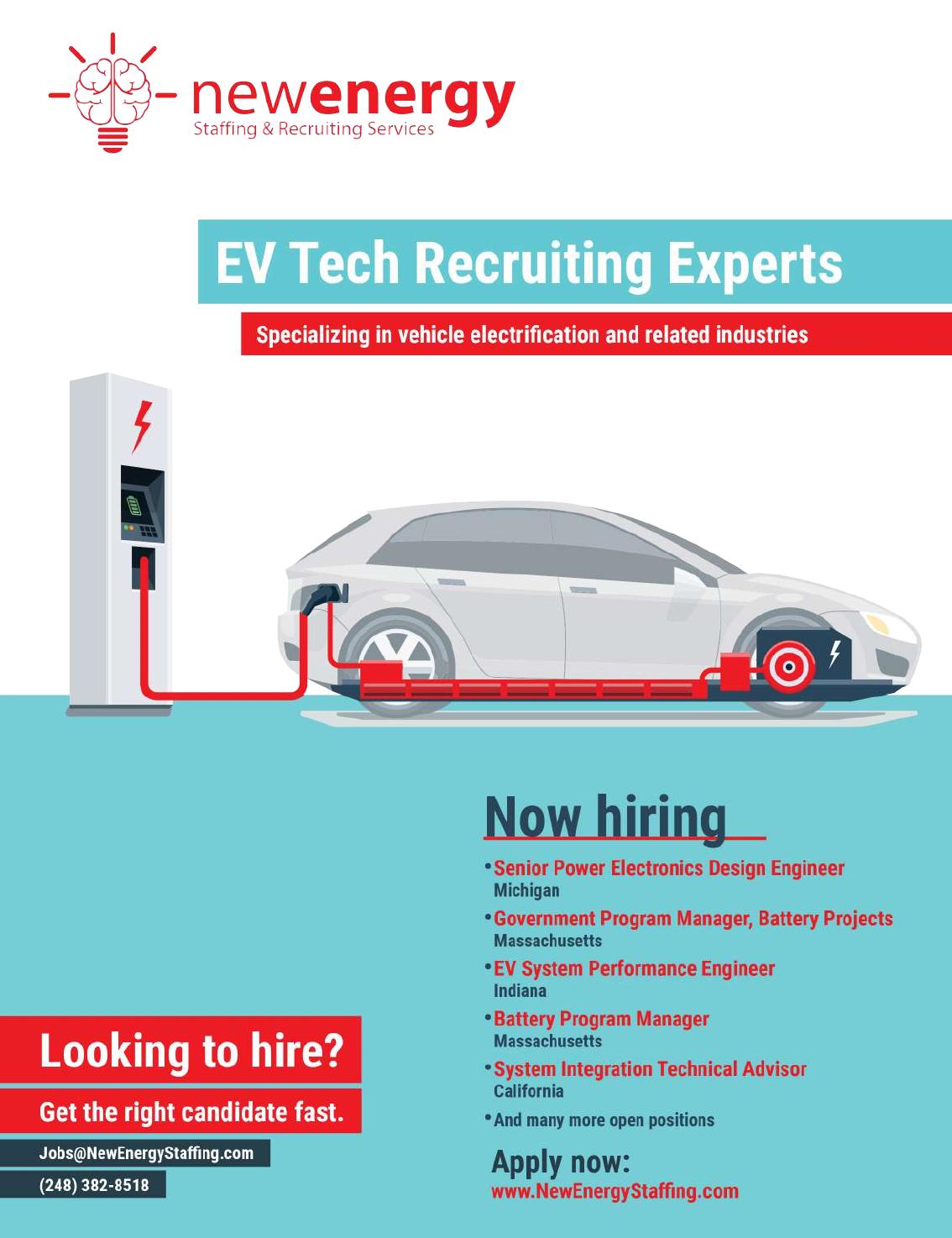

DC Fast Chargers
Speed up
your time to
market!
Further information:
www.semikron.com/power-stacks
Contact us: sales.skusa@semikron.com
Visit us at APEC 2018
Booth 1019
Power electronics for chargers
up to 350kW
SEMIKRON’s power electronic assemblies
enable swift entry into the growing fast
charger market. Reliable and ecient IGBT
stacks are key parts for your successful
high power charging system.